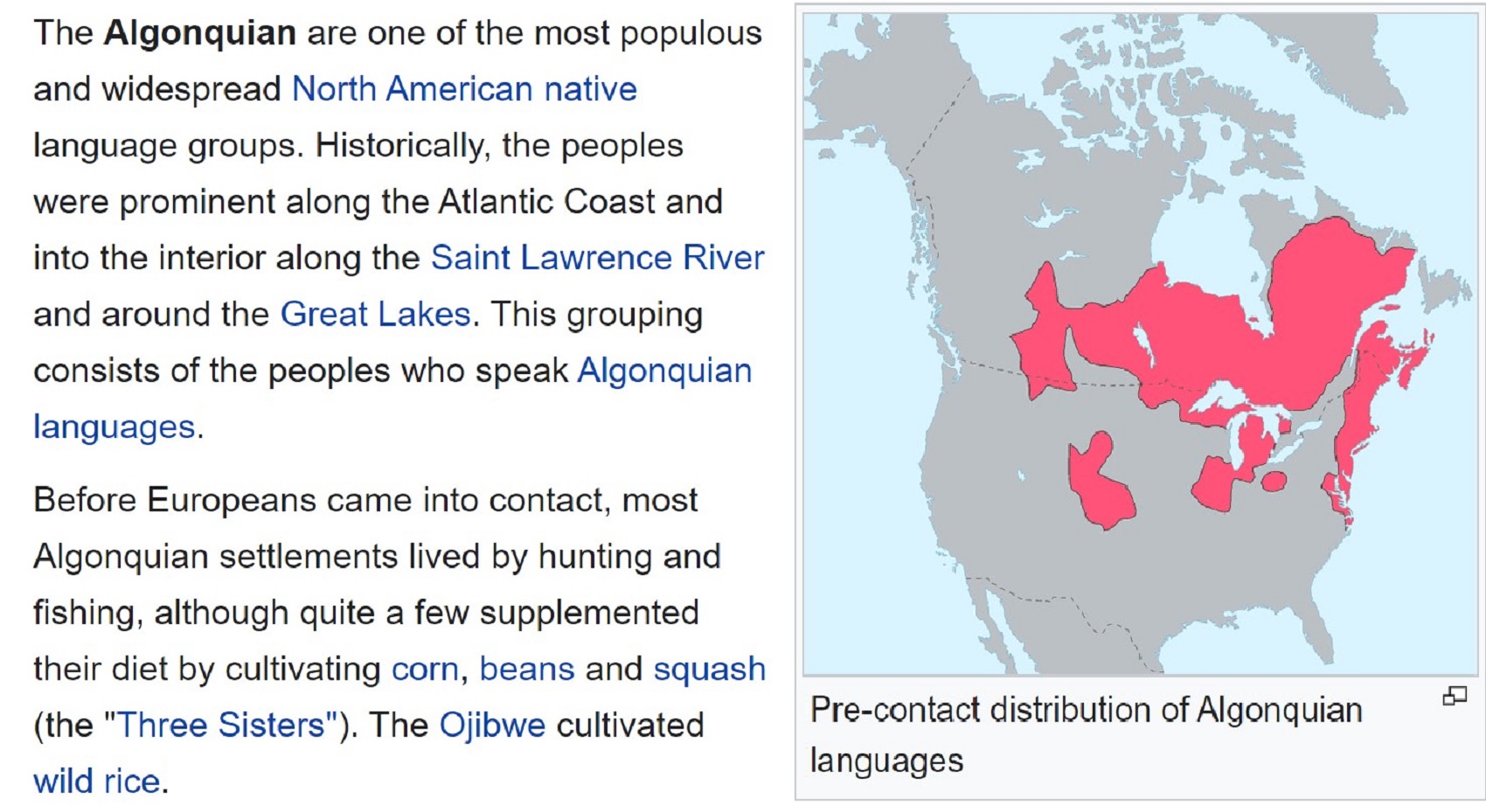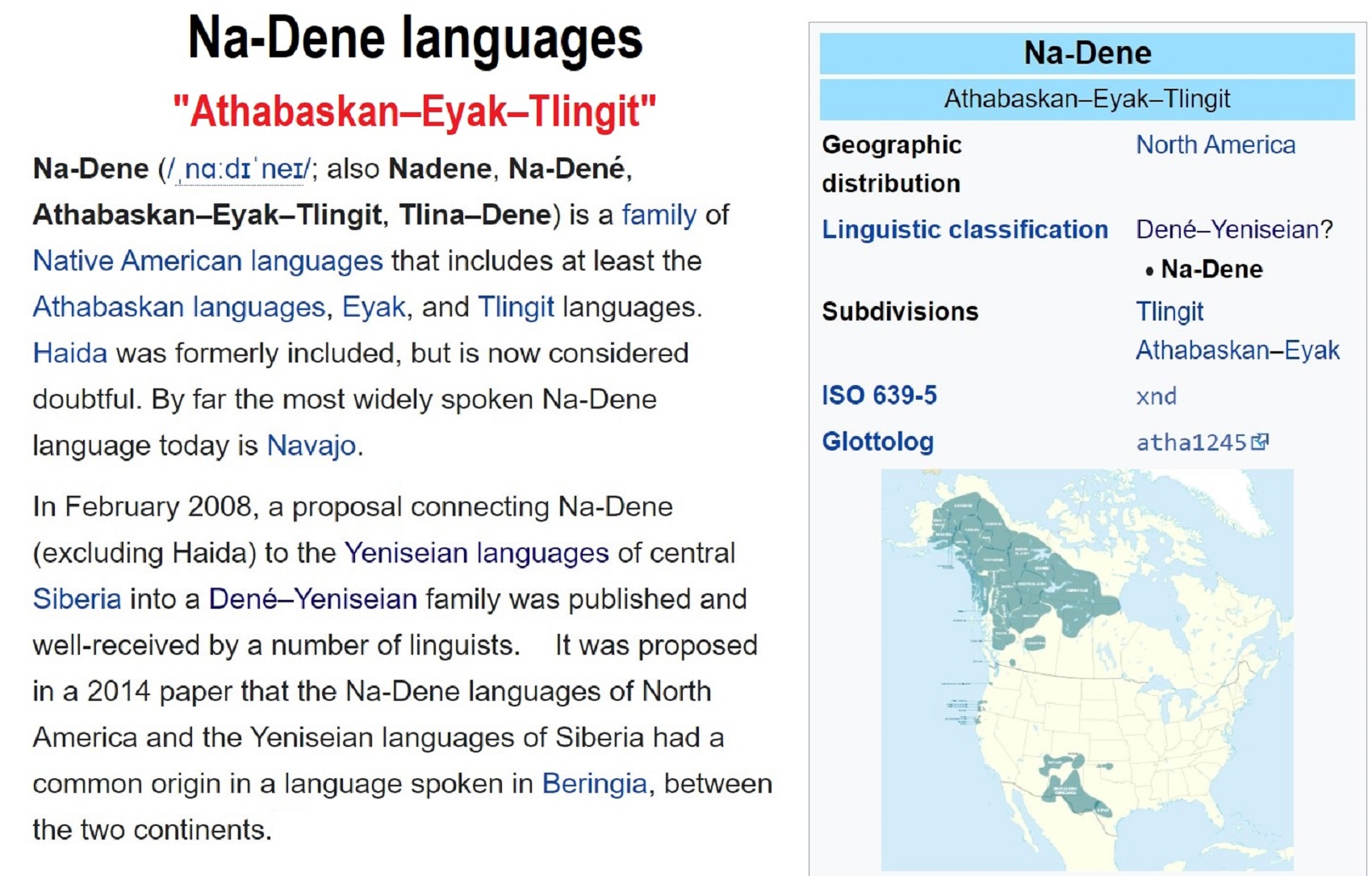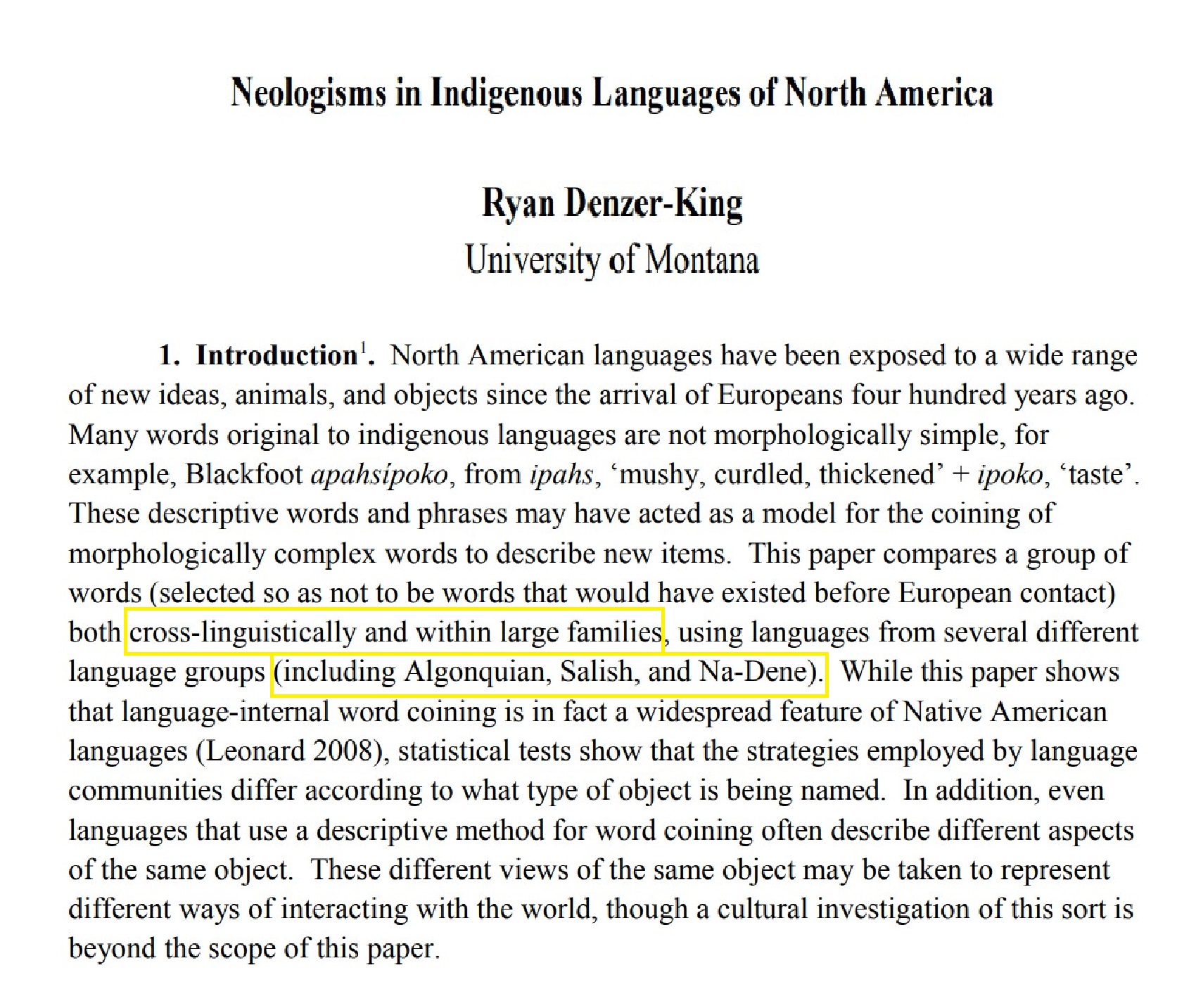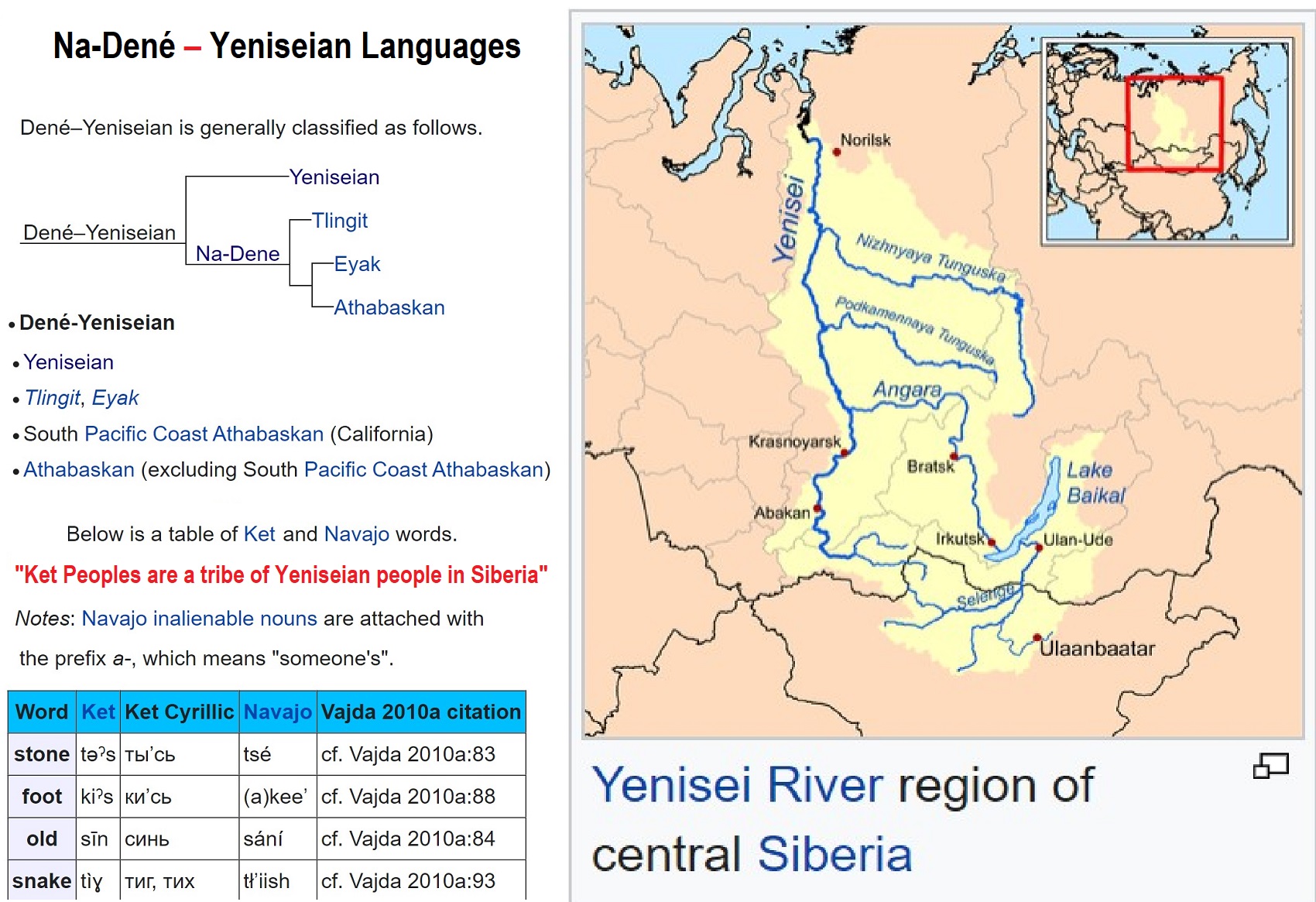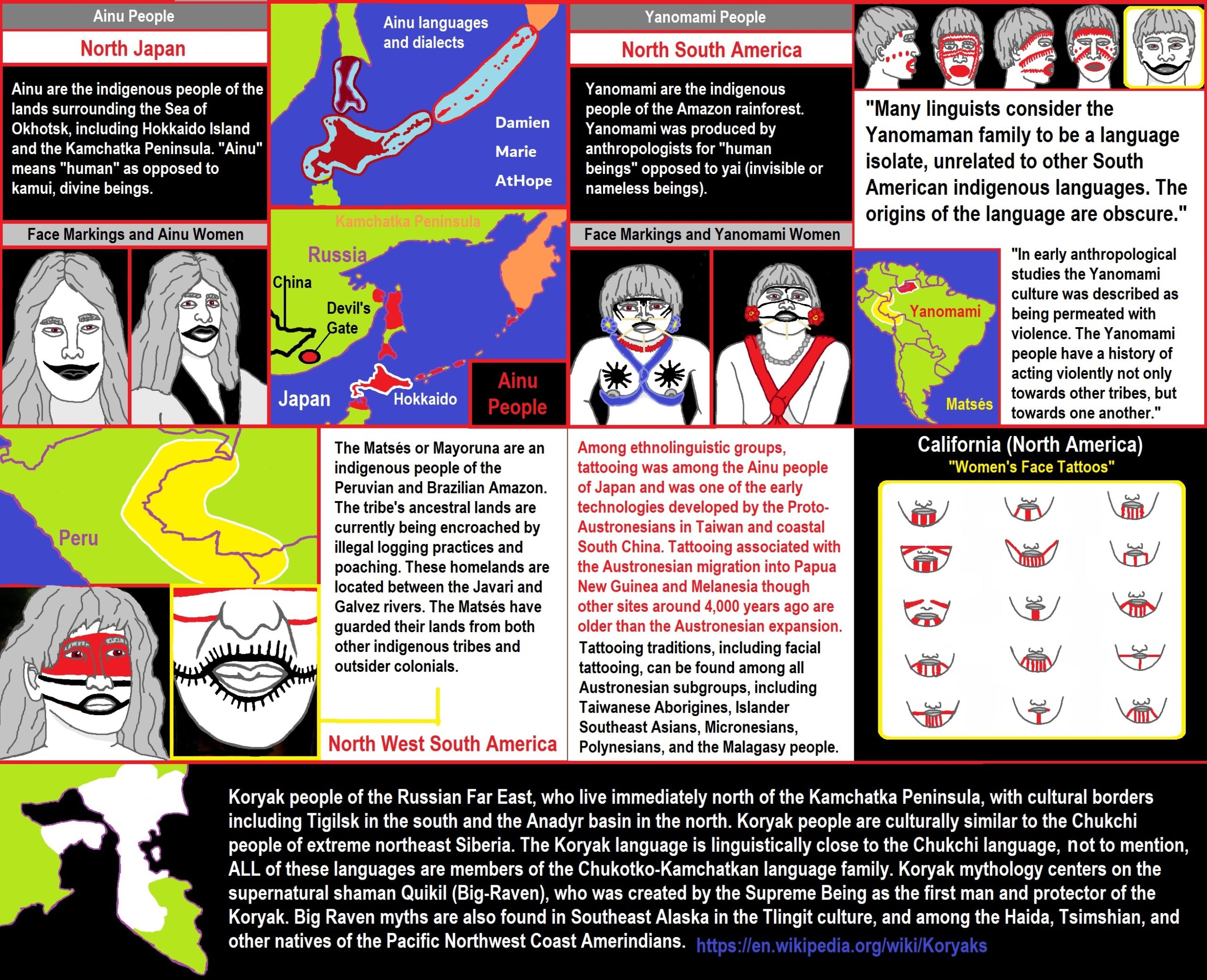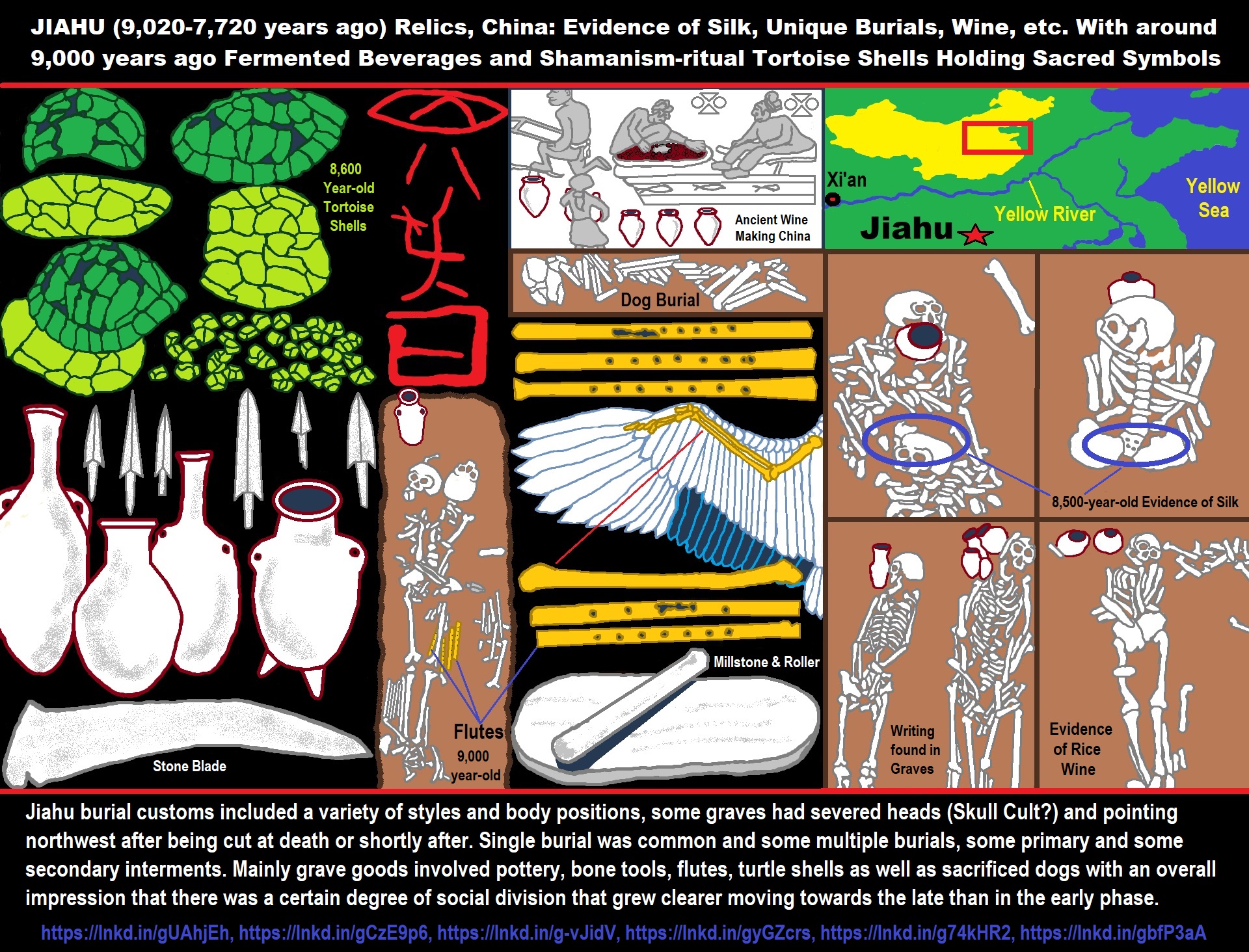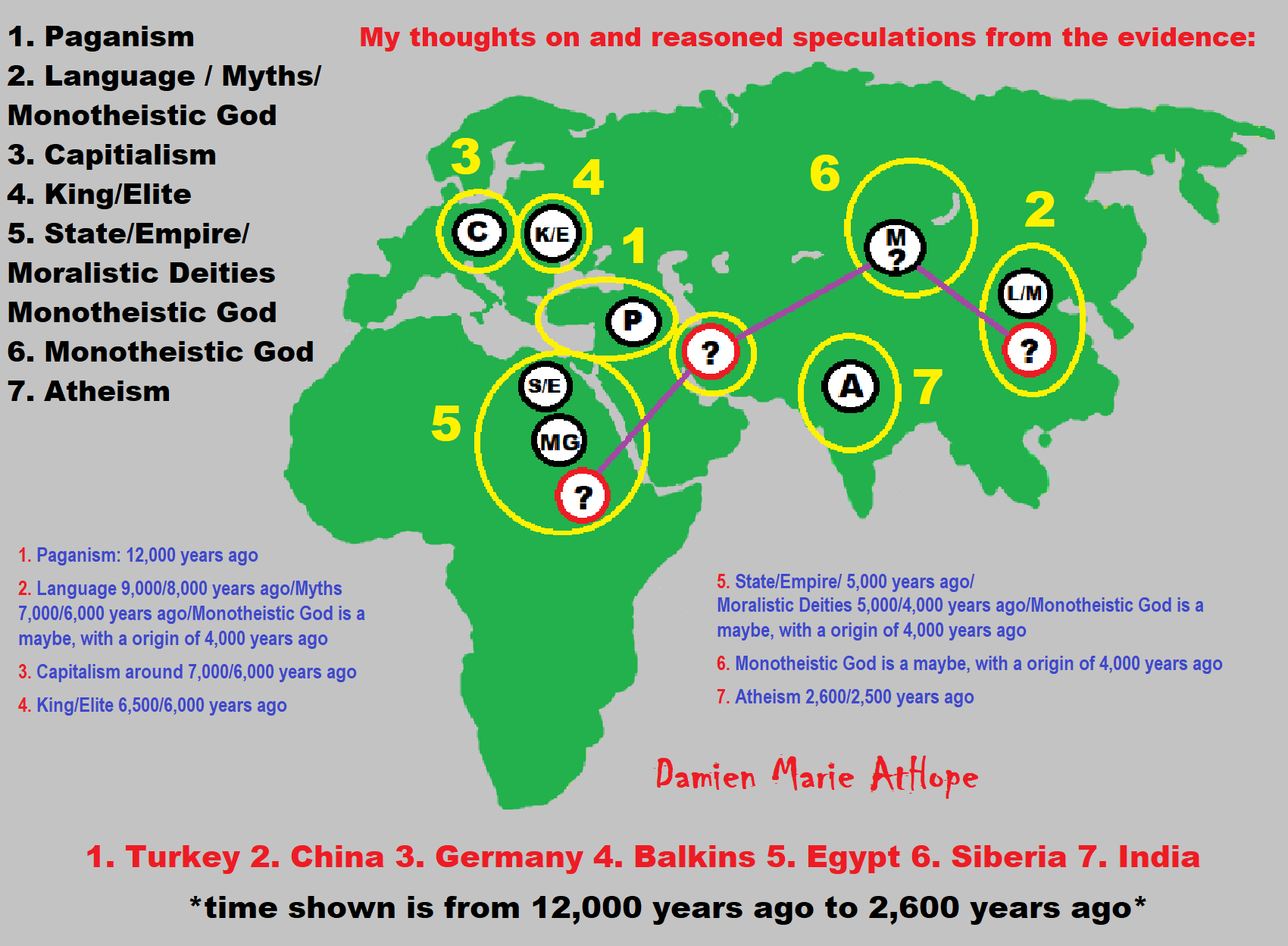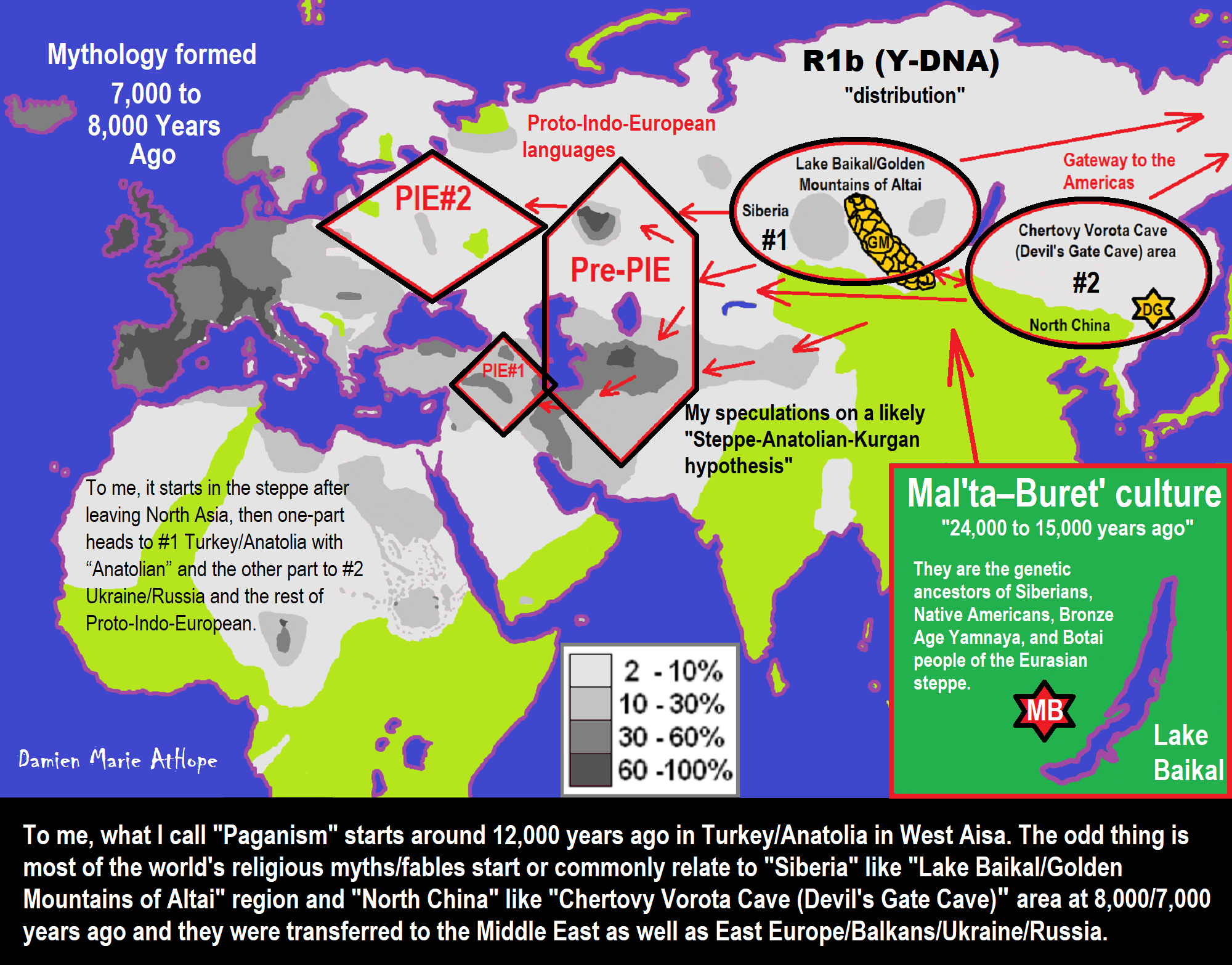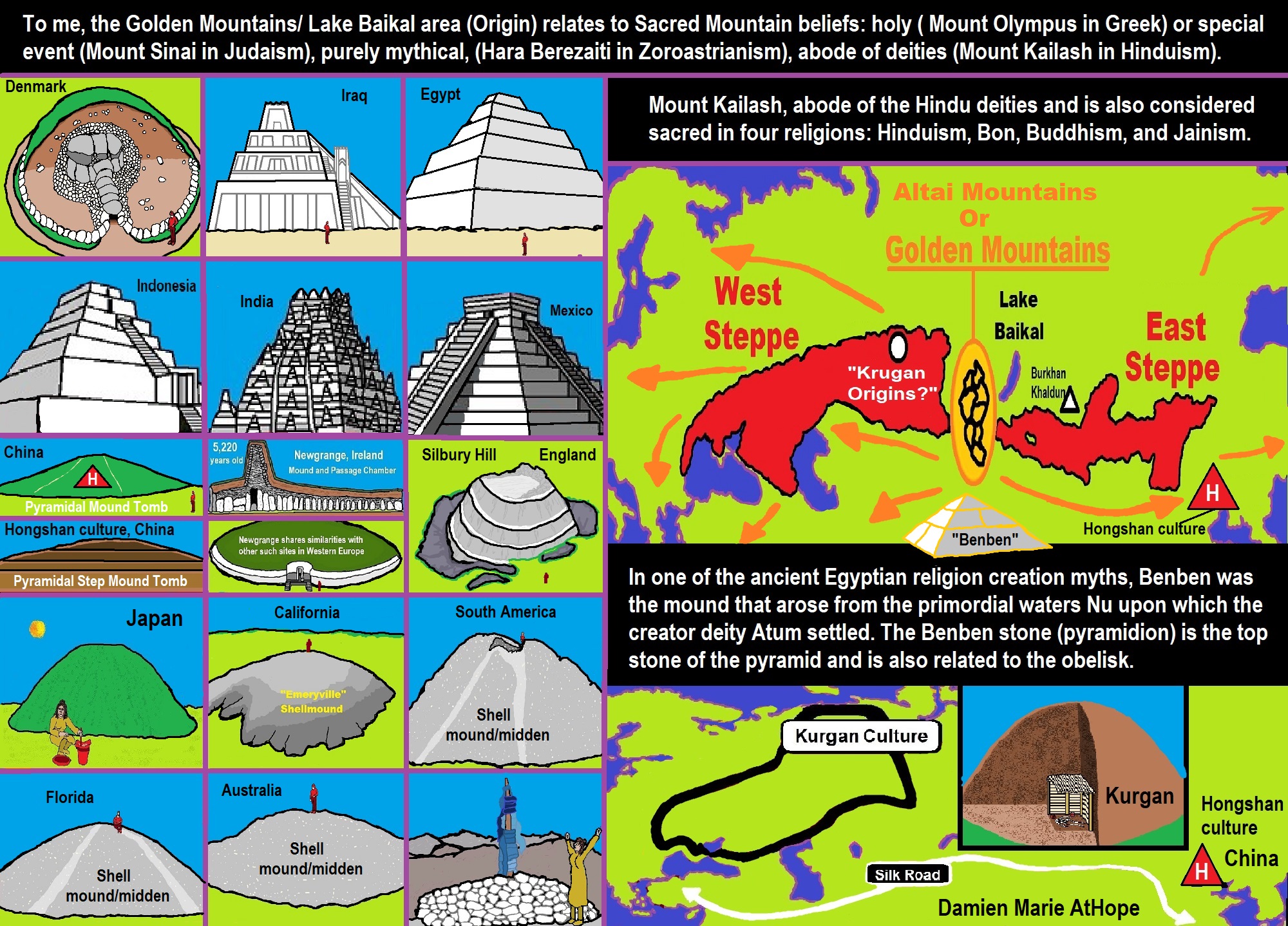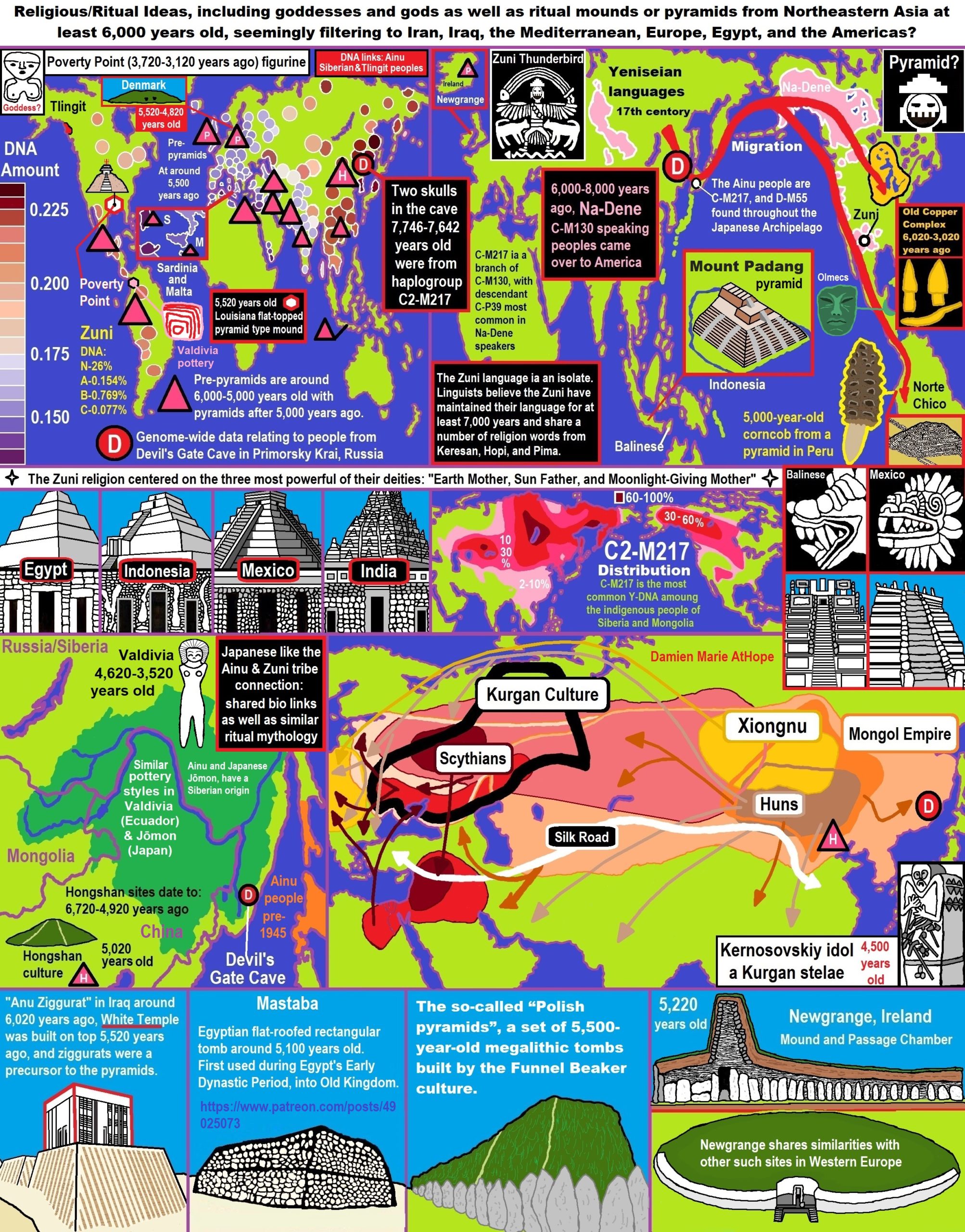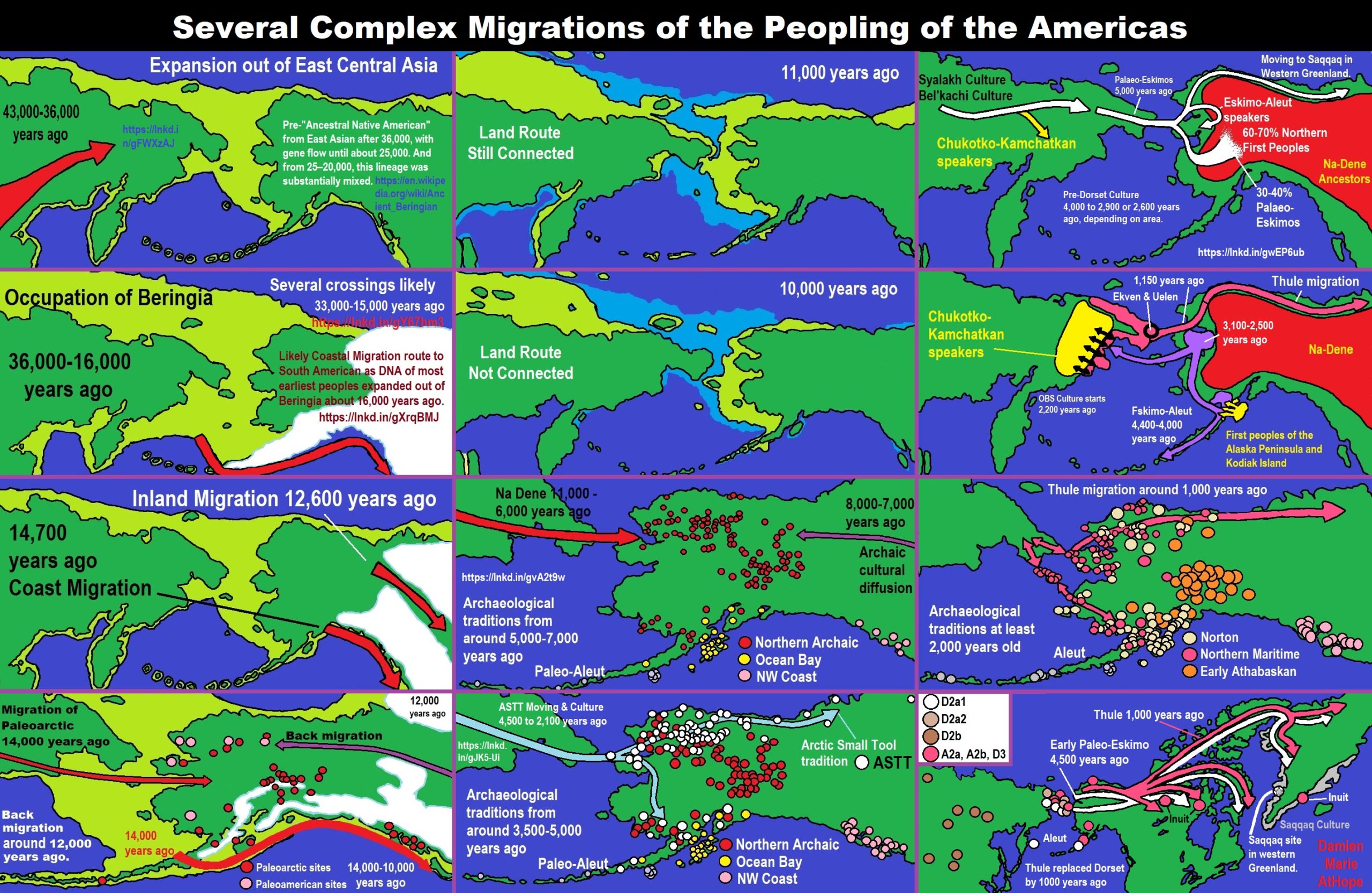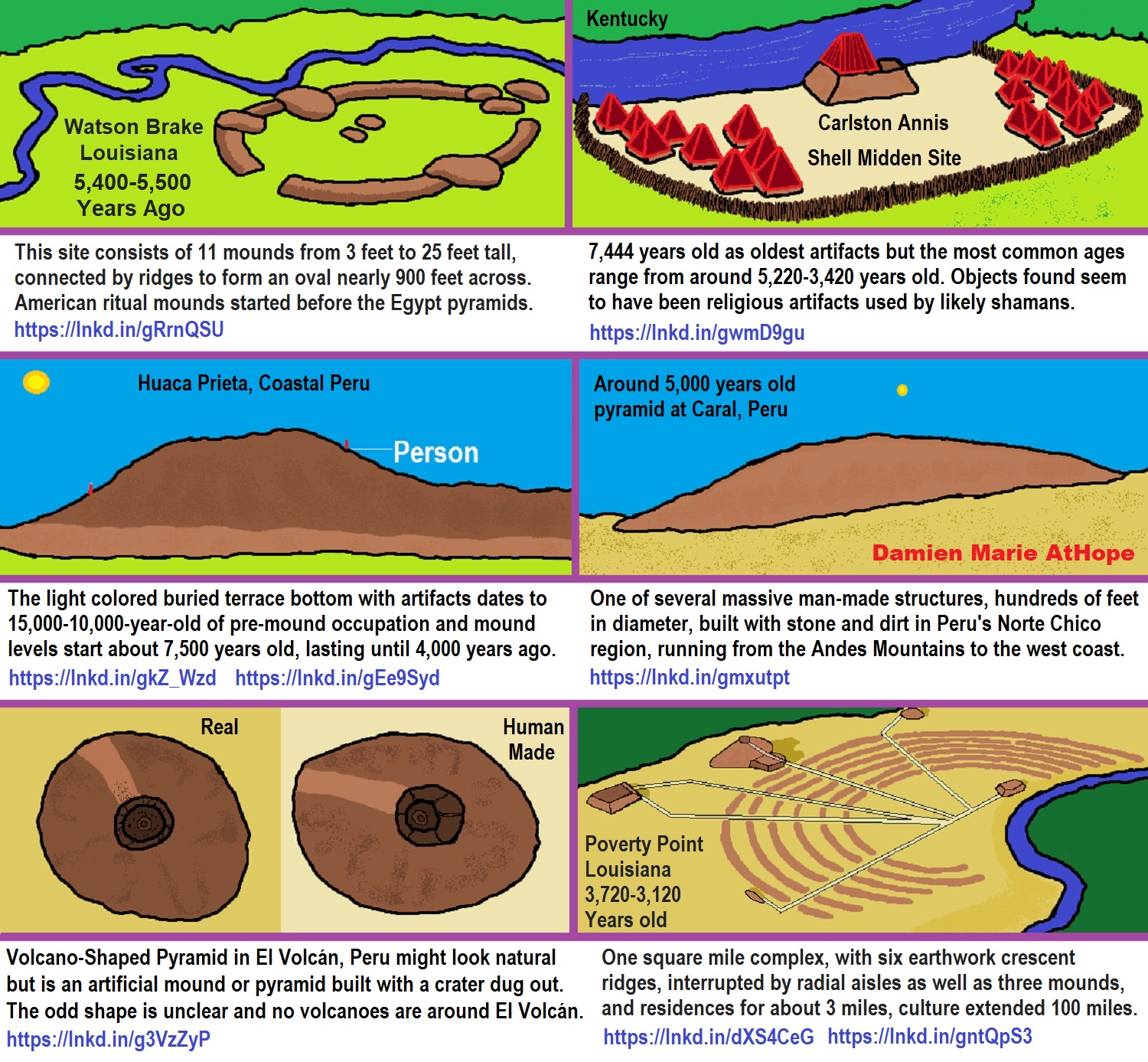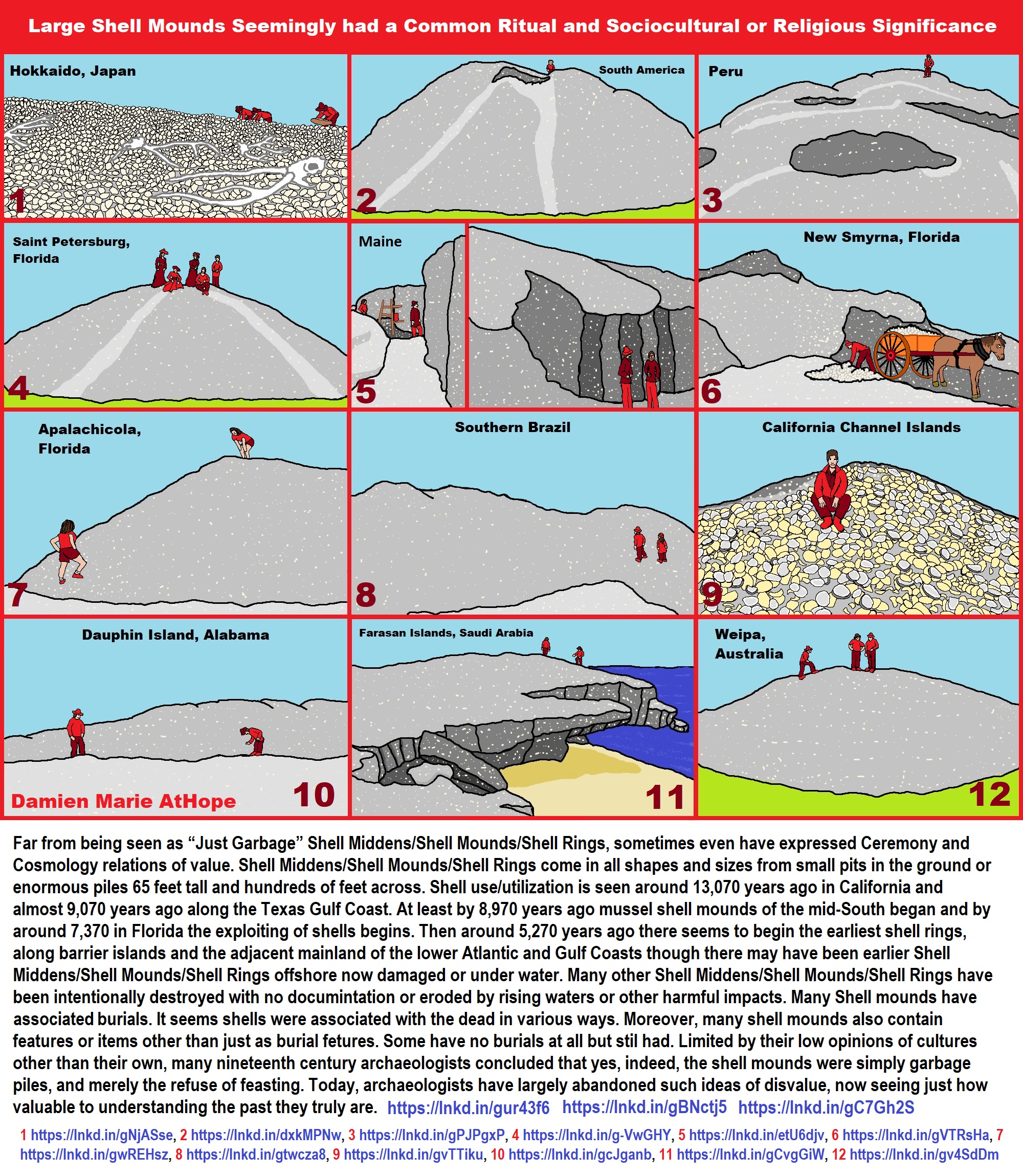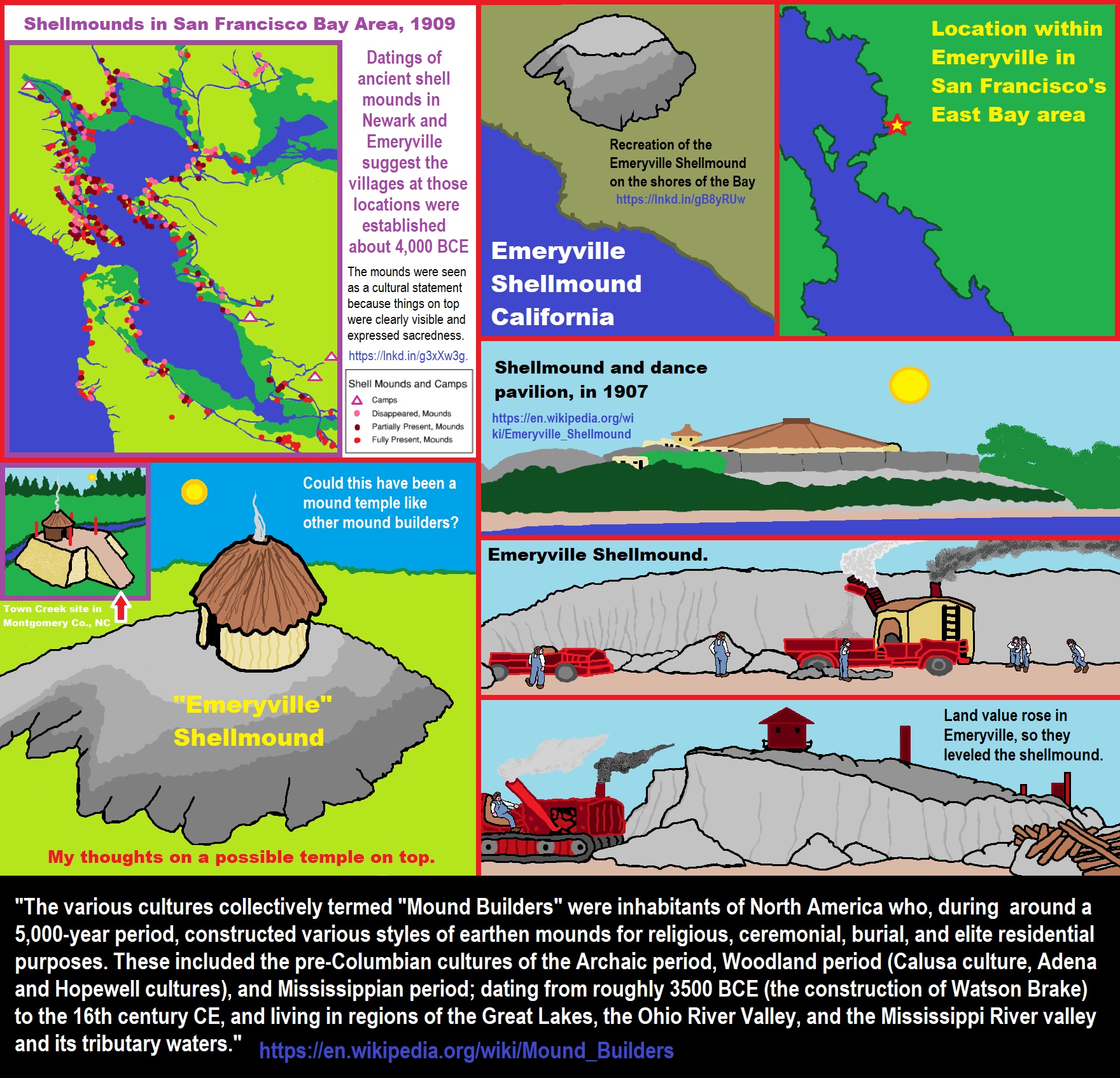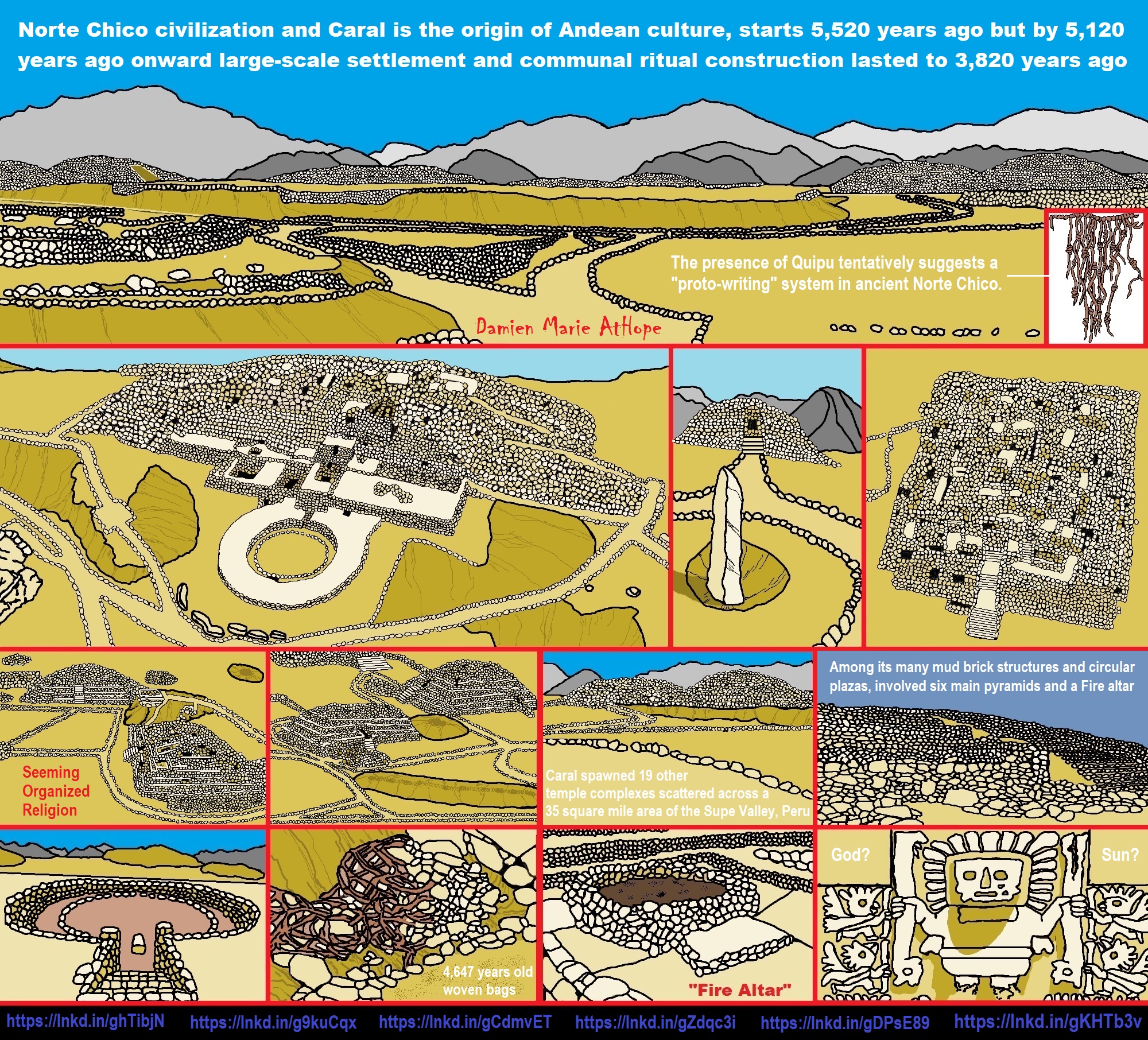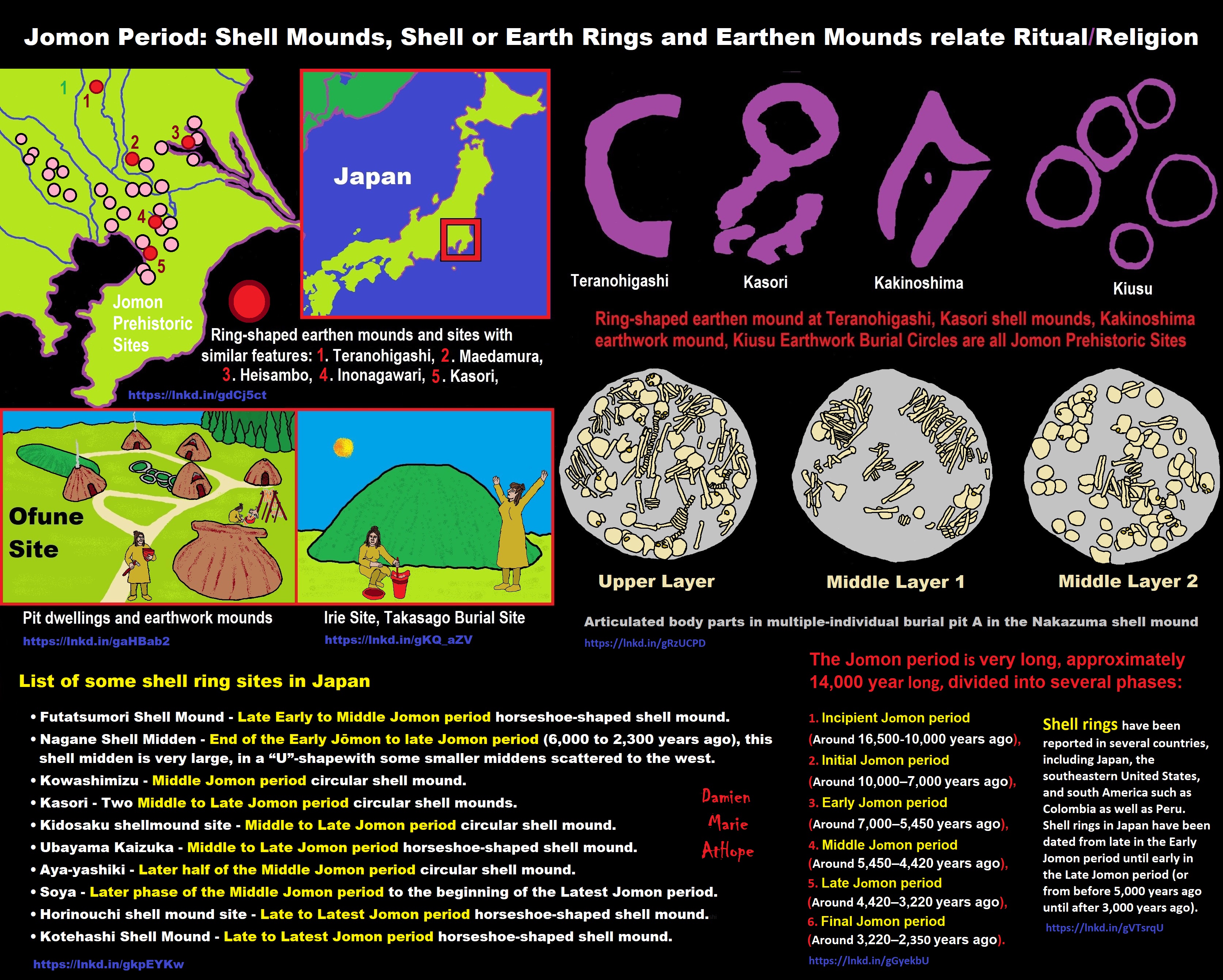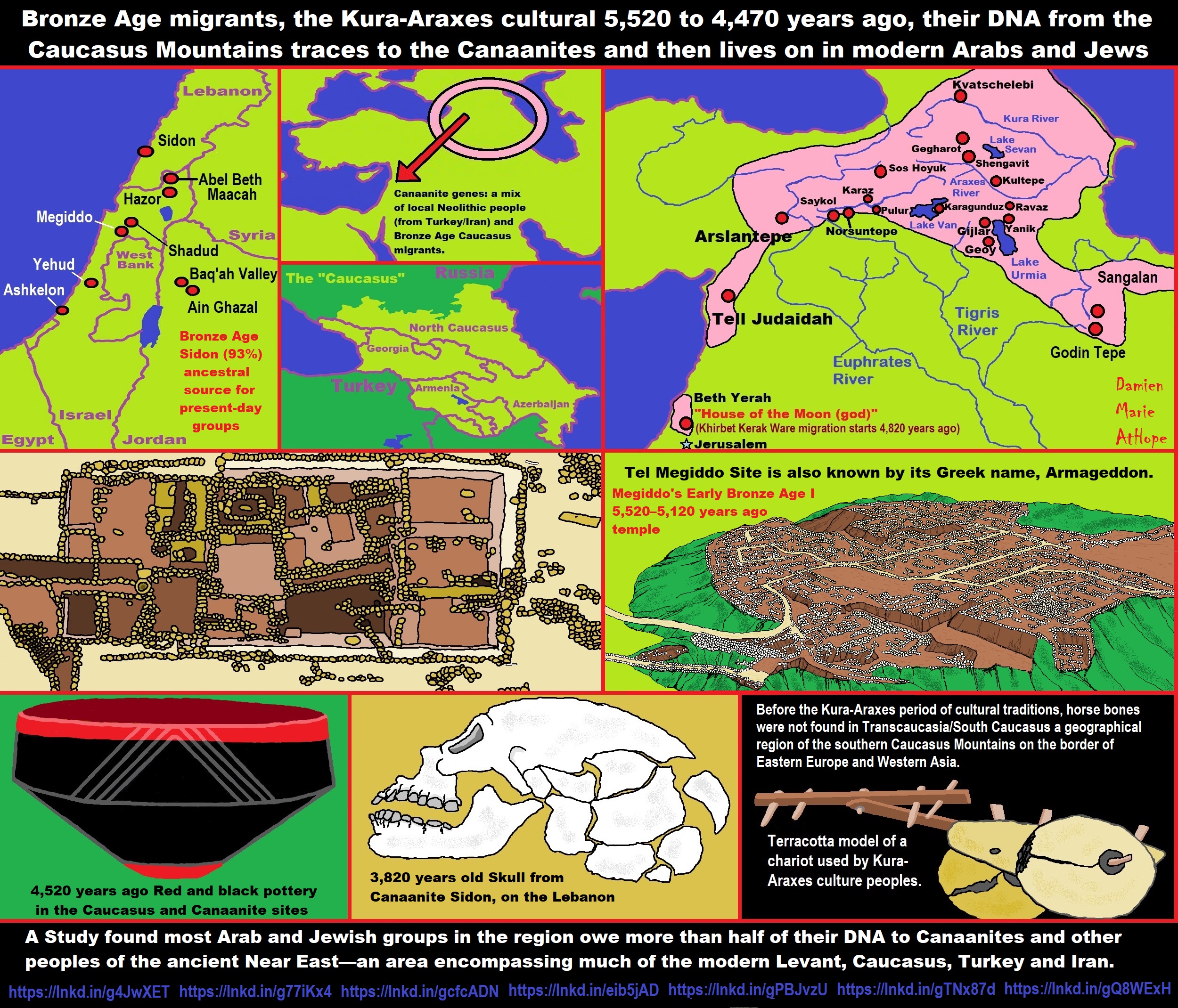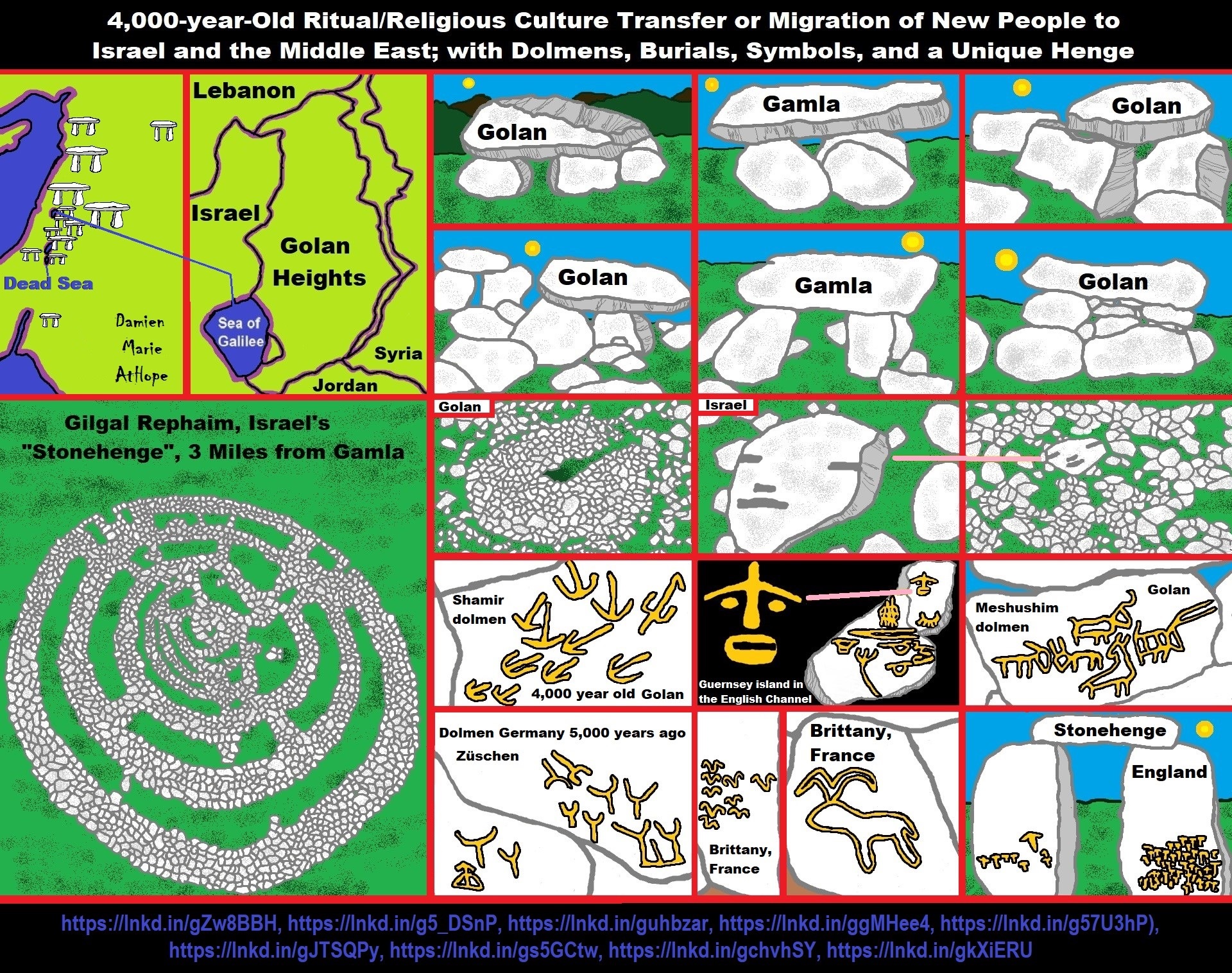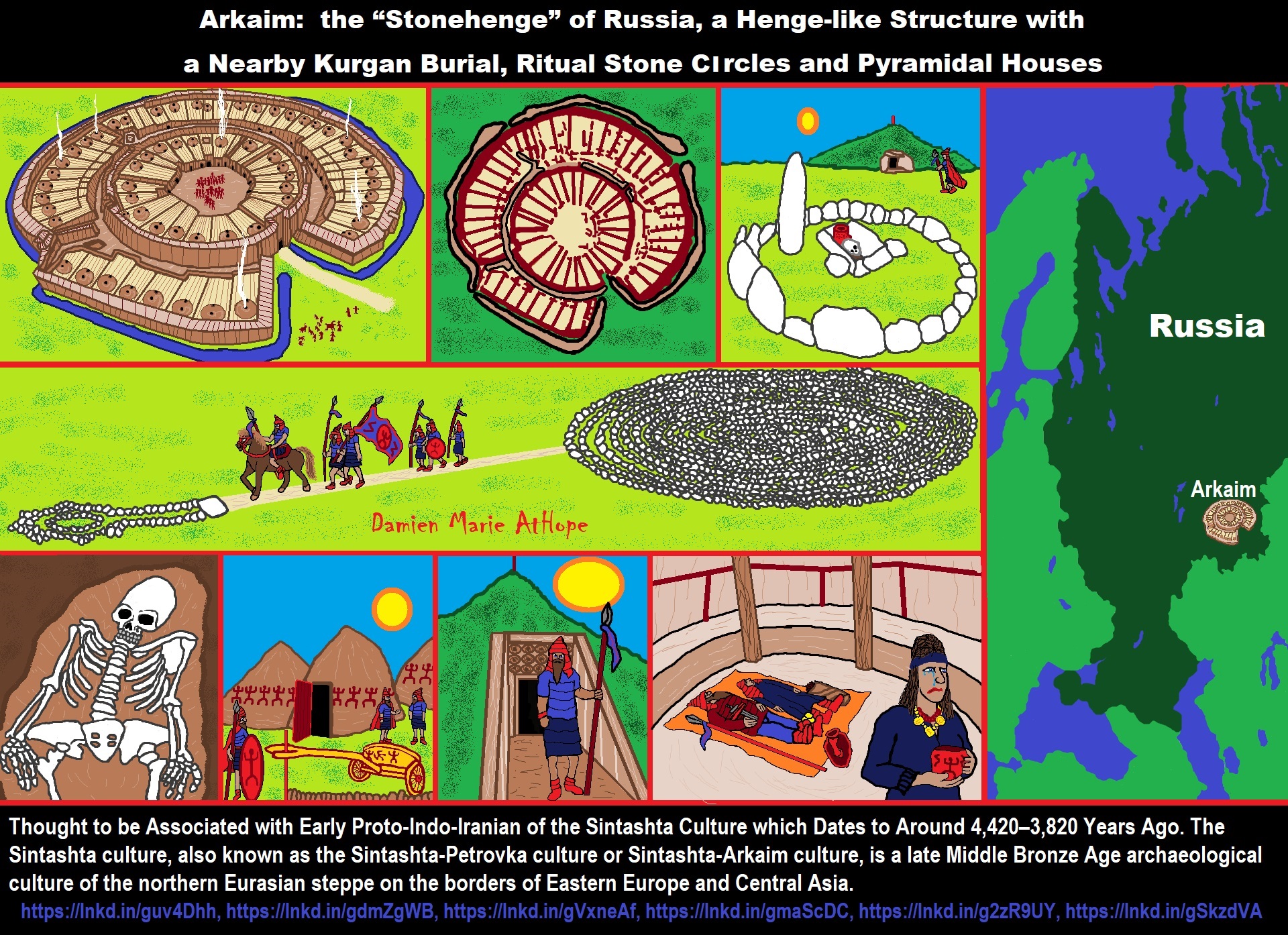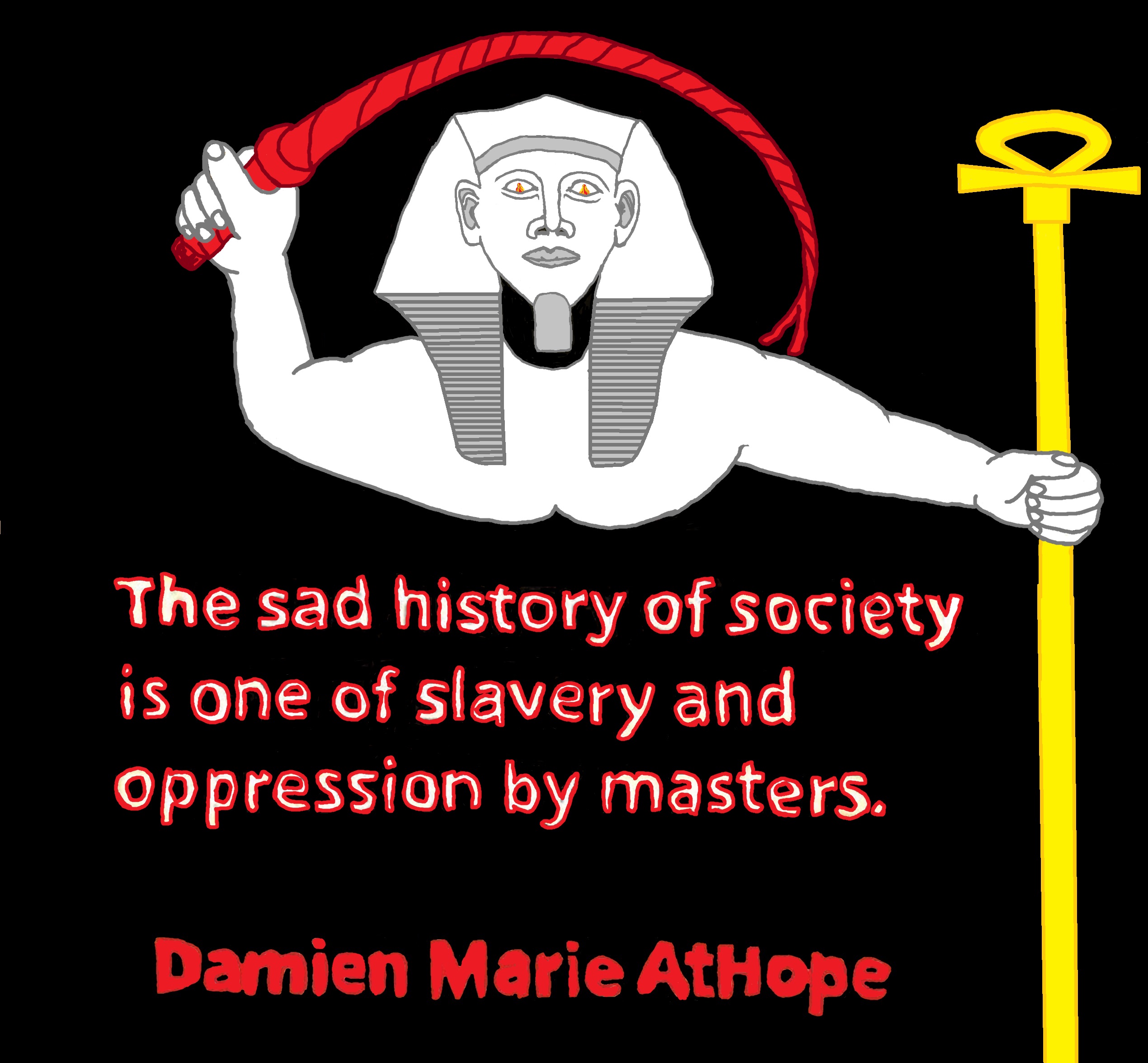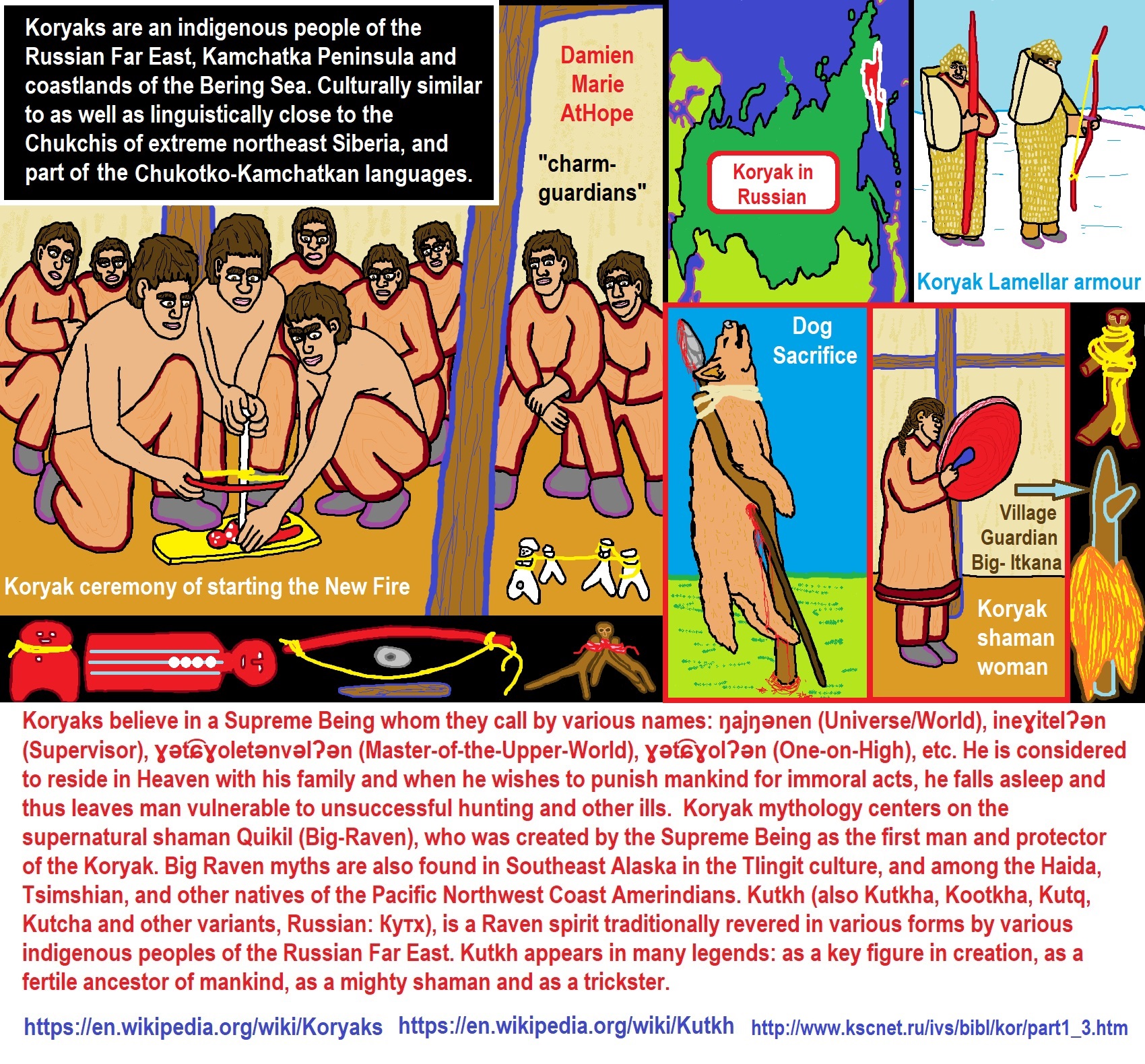
“The ANE lineage is defined by association with the MA-1, or “Mal’ta boy“, the remains of an individual who lived during the Last Glacial Maximum, 24,000 years ago in central Siberia. Populations genetically similar to MA-1 were an important genetic contributor to Native Americans, Europeans, Ancient Central Asians, South Asians, and some East Asian groups (such as the Ainu people), in order of significance.” ref
“Groups partially derived from the Ancient North Eurasians: Eastern Hunter-Gatherer (R1a-M417, around 8,400 years ago), Scandinavian Hunter-Gatherer (around 8,000 years ago), Ancient Beringian/Ancestral Native American (around 11,500 years ago), West Siberian Hunter-Gatherer, Western Steppe Herders (closely related to the Yamnaya culture), Late Upper Paeolithic Lake Baikal (14,050-13,770 years ago), Lake Baikal Holocene (around 11,650 years ago to the present), Jōmon people, pre-Neolithic population of Japan (and present-day Ainu people).” ref
“Since the term ‘Ancient North Eurasian’ refers to a genetic bridge of connected mating networks, scholars of comparative mythology have argued that they probably shared myths and beliefs that could be reconstructed via the comparison of stories attested within cultures that were not in contact for millennia and stretched from the Pontic–Caspian steppe to the American continent.” ref
“For instance, the mytheme of the dog guarding the Otherworld possibly stems from an older Ancient North Eurasian belief, as suggested by similar motifs found in Indo-European, Native American, and Siberian mythology. In Siouan, Algonquian, Iroquoian, and in Central and South American beliefs, a fierce guard dog was located in the Milky Way, perceived as the path of souls in the afterlife, and getting past it was a test. The Siberian Chukchi and Tungus believed in a guardian-of-the-afterlife dog and a spirit dog that would absorb the dead man’s soul and act as a guide in the afterlife. In Indo-European myths, the figure of the dog is embodied by Cerberus, Sarvarā, and Garmr. Anthony and Brown note that it might be one of the oldest mythemes recoverable through comparative mythology.” ref
“A second canid-related series of beliefs, myths, and rituals connected dogs with healing rather than death. For instance, Ancient Near Eastern and Turkic–Kipchaq myths are prone to associate dogs with healing and generally categorized dogs as impure. A similar myth-pattern is assumed for the Eneolithic site of Botai in Kazakhstan, dated to 3500 BC, which might represent the dog as absorber of illness and guardian of the household against disease and evil. In Mesopotamia, the goddess Nintinugga, associated with healing, was accompanied or symbolized by dogs. Similar absorbent-puppy healing and sacrifice rituals were practiced in Greece and Italy, among the Hittites, again possibly influenced by Near Eastern traditions.” ref
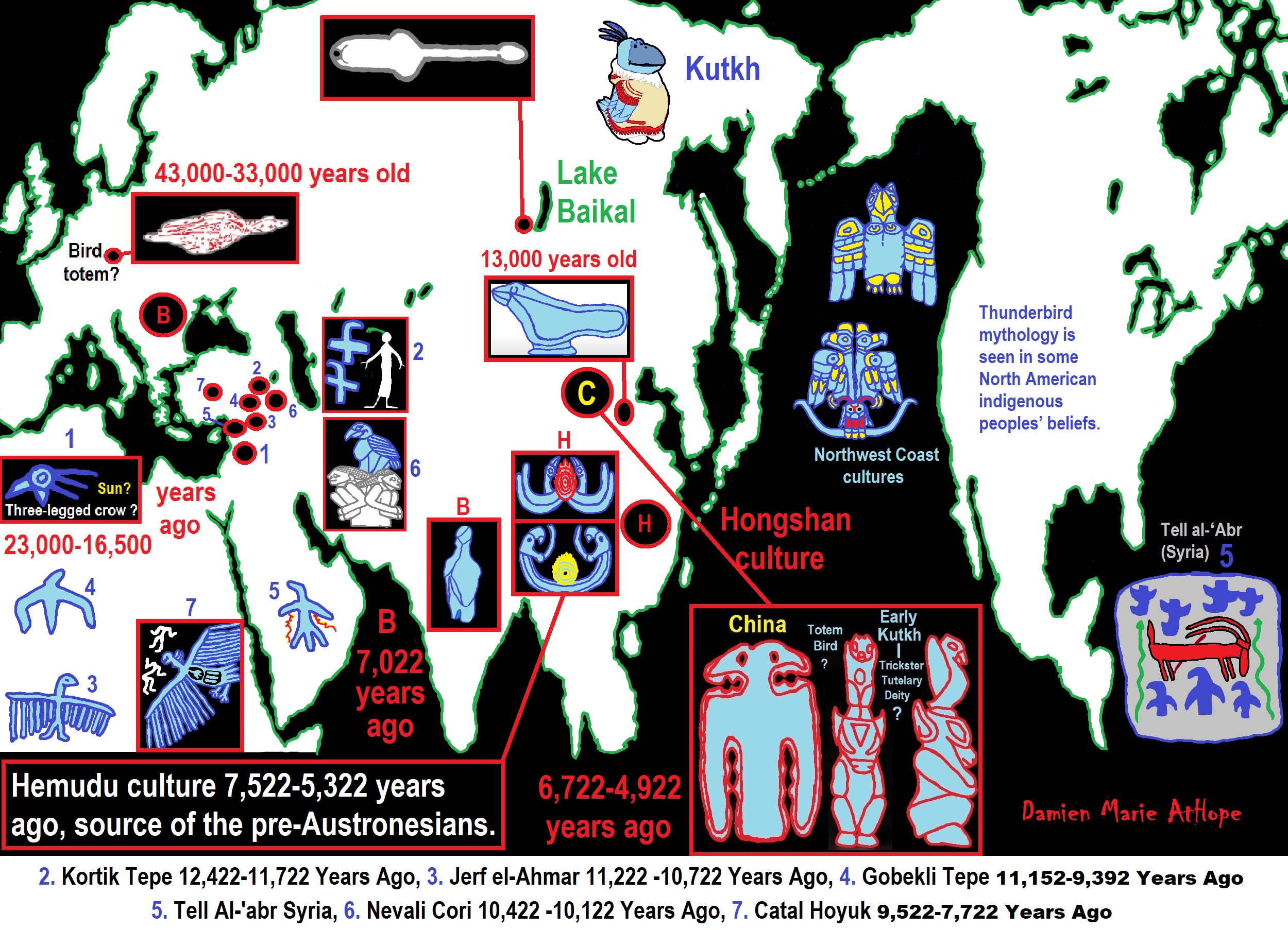
ref, ref, ref, ref, ref, ref, ref, ref, ref, ref, ref, ref, ref, ref
1. Kebaran culture 23,022-16,522 Years Ago, 2. Kortik Tepe 12,422-11,722 Years Ago, 3. Jerf el-Ahmar 11,222 -10,722 Years Ago, 4. Gobekli Tepe 11,152-9,392 Years Ago, 5. Tell Al-‘abrUbaid and Uruk Periods, 6. Nevali Cori 10,422 -10,122 Years Ago, 7. Catal Hoyuk 9,522-7,722 Years Ago

Koryaks
“Koryaks (or Koriak, Russian: Коряки) are an indigenous people of the Russian Far East, who live immediately north of the Kamchatka Peninsula in Kamchatka Krai and inhabit the coastlands of the Bering Sea. The cultural borders of the Koryaks include Tigilsk in the south and the Anadyr basin in the north. Neighbors of the Koryaks include the Evens to the west, the Alutor to the south (on the isthmus of Kamchatka Peninsula), the Kerek to the east, and the Chukchi to the northeast.” ref
“The Koryaks are culturally similar to the Chukchis of extreme northeast Siberia. The Koryak language and Alutor (which is often regarded as a dialect of Koryak), are linguistically close to the Chukchi language. All of these languages are members of the Chukotko-Kamchatkan language family. They are more distantly related to the Itelmens on the Kamchatka Peninsula. All of these peoples and other, unrelated minorities in and around Kamchatka are known collectively as Kamchadals.” ref
“The Koryak are typically split into two groups. The coastal people are called Nemelan (or Nymylan) meaning ‘village dwellers’, due to their living in villages. Their lifestyle is based on local fishing and marine mammal hunting. The inland Koryak, reindeer herders, are called Chaucu (or Chauchuven), meaning ‘rich in reindeer’. They are more nomadic, following the herds as they graze with the seasons. According to the 2010 census, there were 7,953 Koryaks in Russia.” ref
Chukotko-Kamchatkan languages
“The Chukotko-Kamchatkan or Chukchi–Kamchatkan languages are a language family of extreme northeastern Siberia. Its speakers traditionally were indigenous hunter-gatherers and reindeer-herders. Chukotko-Kamchatkan is endangered. The Kamchatkan branch is moribund, represented only by Western Itelmen, with only 4 or 5 elderly speakers left. The Chukotkan branch had close to 7,000 speakers left (as of 2010, the majority being speakers of Chukchi), with a reported total ethnic population of 25,000.” ref
“While the family is sometimes grouped typologically and geographically as Paleo-Siberian, no external genetic relationship has been widely accepted as proven. The most popular such proposals have been for links with Eskimo–Aleut, either alone or in the context of a wider grouping.” ref
Languages
“The Chukotko-Kamchatkan family consists of two distantly related dialect clusters, Chukotkan and Kamchatkan. Chukotkan is considered anywhere from three to five languages, whereas there is only one surviving Kamchatkan language, Itelmen. The relationship of the Chukotkan languages to Itelmen is at best distant, and has been met with only partial acceptance by scholars.” ref
“All the Chukotko-Kamchatkan languages are under pressure from Russian. Almost all speakers are bilingual in Russian, and few members of the ethnic groups associated with the languages born after 1970 speak any language but Russian. The Chukotko-Kamchatkan languages have no generally accepted relation to any other language family. There are several theories about possible relationships to existing or hypothetical language families.” ref
The accepted classification is this:
- KamchatkanSouthern Kamchadal †
Eastern Kamchadal †
Itelmen (Western Kamchadal) - ChukotkanChukchi
Koryak
Alyutor
Kerek †
Paleosiberian?
“The Chukotko-Kamchatkan languages are sometimes classified among the Paleosiberian languages, a catch-all term for language groups with no identified relationship to one another that are believed to represent remnants of the language map of Siberia prior to the advances of Turkic and Tungusic.” ref
“Michael Fortescue (2011) suggests that Chukokto-Kamchatkan and Nivkh (Gilyak, Amuric) are related to each other on the basis of morphological, typological, and lexical evidence. Together, Chukokto-Kamchatkan and Nivkh could form a larger Chukokto-Kamchatkan-Amuric language family.” ref
Eurasiatic?
“Joseph Greenberg identifies Chukotko-Kamchatkan (which he names Chukotian) as a member of Eurasiatic, a proposed macrofamily that includes Indo-European, Altaic, and Eskimo–Aleut, among others. Greenberg also assigns Nivkh and Yukaghir, sometimes classed as “Paleosiberian” languages, to the Eurasiatic family.” ref
“While the Eurasiatic hypothesis has been well received by Nostraticists and some Indo-Europeanists, it remains very controversial. Part of the reason is that the Eurasiatic hypothesis rests on mass comparison of lexemes, grammatical formatives, and vowel systems, rather than on the prevailing view that regular sound correspondences that are linked to a wide array of lexemes and grammatical formatives are the only valid means to establish genetic relationship (see for instance Baldi 2002:2–19). Murray Gell-Mann, Ilia Peiros, and Georgiy Starostin group Chukotko-Kamchatkan languages and Nivkh with Almosan instead of Eurasiatic.” ref
Uralo-Siberian?
“Michael Fortescue, a specialist in Eskimo–Aleut as well as in Chukotko-Kamchatkan, argued for a link between Uralic, Yukaghir, Chukotko-Kamchatkan, and Eskimo–Aleut calling this proposed grouping Uralo-Siberian. Later, he has argued for Nivkh as the closest relative of Chukotko-Kamchatkan and suggests interpreting the similarities to Uralo-Siberian through language contact.” ref
Chukotko-Kamchatkan–Amuric?
“Chukotko-Kamchatkan–Amuric languages, Michael Fortescue argued that Nivkh and Chukotko-Kamchatkan are related and that their common ancestor might have been spoken 4000 years ago.” ref
Proto-Chukotko-Kamchatkan language
“Proto-Chukotko-Kamchatkan is the reconstructed common ancestor of the Chukotko-Kamchatkan languages. It is purported to have broken up into the Northern (Chukotian) and Southern (Itelmen) branches around 2000 BCE, when western reindeer herders moved into the Chukotko-Kamchatkans’ homeland and its inland people adopted the new lifestyle. A reconstruction is presented by Michael Fortescue in his Comparative Dictionary of Chukotko-Kamchatkan (2005).” ref
“It is generally accepted that Proto-Chukotko-Kamchatkan had an eleven-case system for nouns, but Dibella Wdzenczny has hypothesized that these evolved from only six cases in Pre-Proto-Chukotko-Kamchatkan. The protolanguage is thought to have been a nominative-accusative language, with the current Chukotko-Kamchatkan ergative aspects coming later in the (Northern) Chukotian branch, possibly through contact with nearby Eskimo–Aleut-speaking peoples. This would explain why Itelmen, spoken further south than any Eskimo–Aleut speakers visited, lacks ergative structures. Some linguists, however, maintain that Proto-Chukotko-Kamchatkan began as an ergative language and lost that feature over time.” ref
Uralo-Siberian languages
“Uralo-Siberian is a hypothetical language family consisting of Uralic, Yukaghir, Eskimo–Aleut, possibly Nivkh, and formerly Chukotko-Kamchatkan. It was proposed in 1998 by Michael Fortescue, an expert in Eskimo–Aleut and Chukotko-Kamchatkan, in his book Language Relations across Bering Strait. In 2011, Fortescue removed Chukotko-Kamchatkan from the proposal.” ref
“Structural similarities between Uralic and Eskimo–Aleut languages were observed early. In 1746, the Danish theologian Marcus Wøldike [da] compared Greenlandic to Hungarian. In 1818, Rasmus Rask considered Greenlandic to be related to the Uralic languages, Finnish in particular, and presented a list of lexical correspondences (Rask also considered Uralic and Altaic to be related to each other.) In 1959, Knut Bergsland published the paper The Eskimo–Uralic Hypothesis, in which he, like other authors before him, presented a number of grammatical similarities and a small number of lexical correspondences. In 1962, Morris Swadesh proposed a relationship between the Eskimo–Aleut and Chukotko-Kamchatkan language families. In 1998, Michael Fortescue presented more detailed arguments in his book, Language Relations across Bering Strait. His title evokes Morris Swadesh’s 1962 article, “Linguistic relations across the Bering Strait.” ref
“Michael Fortescue (2017) presents, besides new linguistic evidence, also several genetic studies, that support a common origin of the included groups, with a suggested homeland in Northeast Asia. Fortescue (1998, pp. 60–95) surveys 44 typological markers and argues that a typological profile uniquely identifying the language families proposed to comprise the Uralo-Siberian family can be established. The Uralo-Siberian hypothesis is rooted in the assumption that this distinct typological profile was, rather than an areal profile common to four unrelated language families, the profile of a single language ancestral to all four: Proto-Uralo-Siberian.” ref
Phonology
- “A single, voiceless series of stop consonants.Voiced stops such as /d/ occur in the Indo-European, Yeniseian, Turkic, Mongolian, Tungusic, Japonic, and Sino-Tibetan languages. They have also later arisen in several branches of Uralic.
Aspirated stops such as /tʰ/ occur in Korean, Nivkh, Na-Dene, Haida, etc.
Ejective stops such as /tʼ/ occur in Na-Dene, Haida, Salishan, Tsimshian, etc. - A series of voiced non-sibilant fricatives, including /ð/, which lack voiceless counterparts such as /θ/.Original non-sibilant fricatives are absent from most other languages of Eurasia. Voiceless fricatives prevail over voiced ones in most of northern America. Both voiced and voiceless fricatives occur in Nivkh.
- Primary palatal or palatalized consonants such as /ɲ ~ nʲ/, /ʎ ~ lʲ/.
- The occurrence of a rhotic consonant /r/.Found in most other language families of northern Eurasia as well; however, widely absent from languages of northern America.
- Consonant clusters are absent word-initially and word-finally, but present word-medially.A feature shared with most ‘Altaic’ languages. Contrasts with the presence of abundant consonant clusters in Nivkh, as well as in the Indo-European and Salishan languages.
- Canonically bisyllabic word roots, with the exception of pronouns.Contrasts with canonically monosyllabic word roots in Indo-European, Sino-Tibetan, Yeniseian, Na-Dene, Haida, Tsimshian, Wakashan, Salishan, etc. Some secondarily monosyllabic word roots have developed in Aleut and multiple Uralic languages, and they predominate in Itelmen.” ref
- Word-initial stress.
Morphology
- Exclusively suffixal morphology.Contrasts particularly with Yeniseian and Na-Dene.
- Accusative case, genitive case, and at least three local cases.
- singular, plural, and dual number.
- The absence of adjectives and adverbs as morphologically distinct parts of speech.
- Evidentiality marking.
- Indicative markers based on participles.
- Possessive suffixes.
Syntax
- The presence of a copula, used as an auxiliary verb.
- Negation expressed by an auxiliary verb (known as a negative verb)
- Subordinate clauses based on non-finite verb forms.” ref
“None of the four families shows all of these 17 features; ranging from 12 reconstructible in Proto-Chukotko-Kamchatkan to 16 in Proto-Uralic. Frequently the modern-day descendant languages have diverged further from this profile — particularly Itelmen, for which Fortescue assumes substrate influence from a language typologically more alike to the non-Uralo-Siberian languages of the region.” ref
“Several more widely spread typologically significant features may also instead represent contact influence, according to Fortescue (1998):
- Primary uvular consonants are absent from Uralic, but can be found in Chukotko-Kamchatkan and Eskimo-Aleut. They are also present in Yukaghir, though are likely to be of secondary origin there (as also in the Uralic Selkup, as well as a large number of Turkic languages). They are, however, firmly entrenched in the non-Uralo-Siberian languages of northernmost Eurasia, including Yeniseian, Nivkh, Na-Dene, Haida, Salishan, etc. Fortescue suggests that the presence of uvulars in CK and EA may, then, represent an ancient areal innovation acquired from the earlier, “pre-Na-Dene” languages of Beringia.” ref
“Fortescue argues that the Uralo-Siberian proto-language (or a complex of related proto-languages) may have been spoken by Mesolithic hunting and fishing people in south-central Siberia (roughly, from the upper Yenisei river to Lake Baikal) between 8000 and 6000 BC, and that the proto-languages of the derived families may have been carried northward out of this homeland in several successive waves down to about 4000 BC, leaving the Samoyedic branch of Uralic in occupation of the Urheimat thereafter.” ref
“Some or all of the four Uralo-Siberian families have been included in more extensive groupings of languages (see links below). Fortescue’s hypothesis does not oppose or exclude these various proposals. In particular, he considers that a remote relationship between Uralo-Siberian and Altaic (or some part of Altaic) is likely (see Ural–Altaic languages). However, Fortescue holds that Uralo-Siberian lies within the bounds of the provable, whereas Nostratic may be too remote a grouping to ever be convincingly demonstrated.” ref
“The University of Leiden linguist Frederik Kortlandt (2006:1) asserts that Indo-Uralic (a proposed language family consisting of Uralic and Indo-European) is itself a branch of Uralo-Siberian and that, furthermore, the Nivkh language also belongs to Uralo-Siberian. This would make Uralo-Siberian the proto-language of a much vaster language family. Kortlandt (2006:3) considers that Uralo-Siberian and Altaic (defined by him as consisting of Turkic, Mongolian, Tungusic, Korean, and Japanese) may be coordinate branches of the Eurasiatic language family proposed by Joseph Greenberg but rejected by most linguists.” ref
“Koryak” Etymology
“The name Koryak was from the exonym word ‘Korak’, meaning ‘with the reindeer (kor)’ in a nearby group Chukotko-Kamchatkan language. The earliest references to the name ‘Koryak’ were recorded in the writings of the Russian cossack Vladimir Atlasov, who conquered Kamchatka for the Tsar in 1695. The variant name was adopted by Russia in official state documents, hence popularizing it ever since.” ref
“The origin of the Koryak is unknown. Anthropologists have speculated that a land bridge connected the Eurasian and North American continent during Late Pleistocene. It is possible that migratory peoples crossed the modern-day Koryak land en route to North America. Scientists have suggested that people traveled back and forth between this area and Haida Gwaii before the ice age receded. They theorize that the ancestors of the Koryak had returned to Siberian Asia from North America during this time. Cultural and some linguistic similarity exist between the Nivkh and the Koryak.” ref
“Koryak” Culture
“Families usually gathered into groups of six or seven, forming bands. The nominal chief had no predominating authority, and the groups relied on consensus to make decisions, resembling common small group egalitarianism. Today the Koryaks also buy processed food, such as bread, cereal, and canned fish. They sell some reindeer each year for money, but can build up their herds due to the large population of reindeer.” ref
“The lives of the people in the interior revolved around reindeer, their main source of food. They also used all the parts of its body to make sewing materials and clothing, tools, and weapons. The meat was mostly eaten roasted and the blood, marrow, and milk were drunk or eaten raw. The liver, heart, kidneys, and tongue were considered delicacies. Salmon and other freshwater fish as well as berries and roots played a major part in the diet, as reindeer flesh did not contain some necessary vitamins and minerals, nor dietary fibre, needed to survive in the harsh tundra.” ref
“Clothing was made out of reindeer hides, but nowadays men and women often have replaced that with cloth. The men wore baggy pants and a hide shirt, which often had a hood attached to it, boots, and traditional caps made of reindeer skin. They still use the boots and caps. The women wore the same as the men, but with a longer shirt reaching to the calves. Today women often wear a head cloth and skirt, but wear the reindeer skin robe in cold weather.” ref
“The Koryak lived in domed-shaped tents, called jajanga, or yaranga (from the more famous Chukchi term) similar to a tipi of the American Plains Indians, but less vertical, while some lived in yurts. The framework was covered in many reindeer skins. Few families still use the yaranga as dwellings, but some use them for trips to the tundra. The center of the yaranga had a hearth, which has been replaced by an iron stove. Reindeer hide beds are placed to the east in the chum. They used small cupboards to store the families’ food, clothing, and personal items.” ref
“The inland Koryak rode reindeer to get around, cutting off their antlers to prevent injuries. They also fitted a team of reindeer with harnesses and attached them to sleds to transport goods and people when moving camp. Today the Koryak use snowmobiles more often than reindeer. Most inter-village transport is by air or boat, although tracked vehicles are used for travel to neighboring villages.” ref
“They developed snowshoes, which they used in winter (and still do) when the snow is deep. Snowshoes are made by lashing reindeer sinew and hide strips to a tennis racket-shaped birch bark or willow hoop. The sinew straps are used to attach the shoe to the foot. Children learned to ride a reindeer, sleigh, and use snowshoes at a very young age. The other Koryak were skilled seafarers hunting whales and other marine mammals.” ref
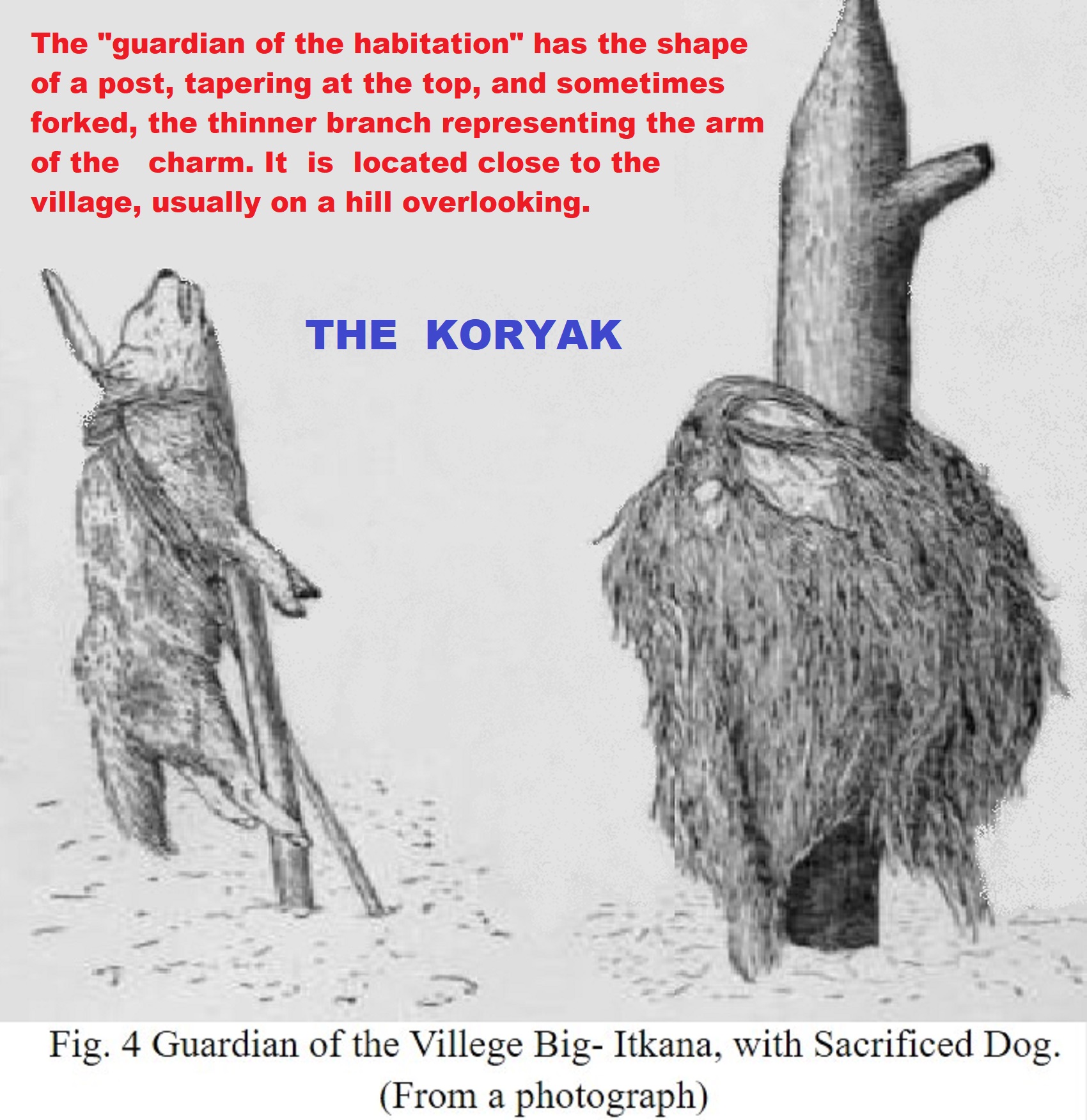
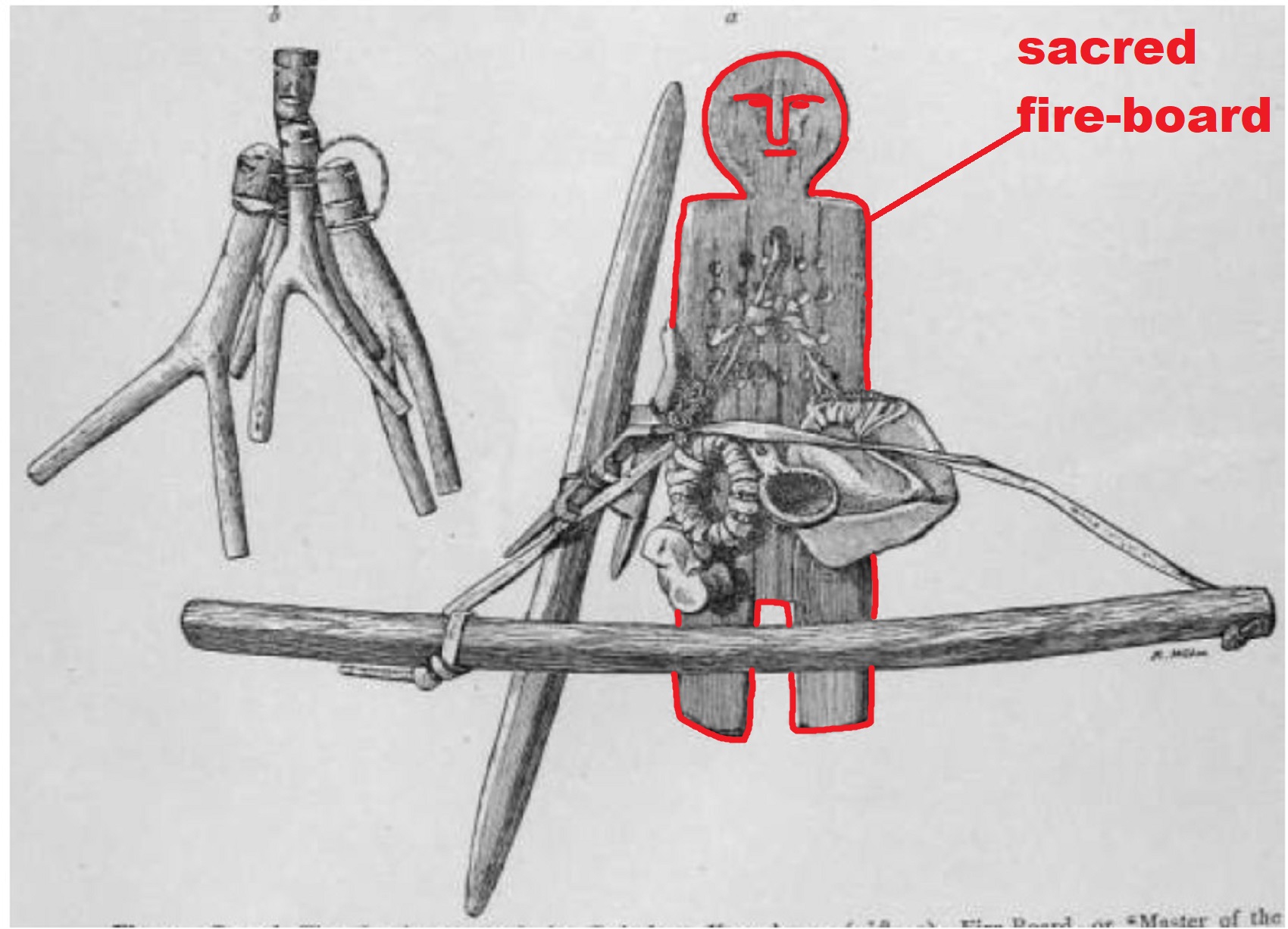
“Koryak” Religion
“Koryaks believe in a Supreme Being whom they call by various names: ŋajŋənen (Universe/World), ineɣitelʔən (Supervisor), ɣət͡ɕɣoletənvəlʔən (Master-of-the-Upper-World), ɣət͡ɕɣolʔən (One-on-High), etc. He is considered to reside in Heaven with his family and when he wishes to punish mankind for immoral acts, he falls asleep and thus leaves man vulnerable to unsuccessful hunting and other ills.” ref
“Koryak” GUARDIANS AND CHARMS.
“Passing from the conceptions of invisible supernatural beings to the religious significance of concrete objects, I .shall begin with a discussion of guardians and charms. It is very difficult to answer the question, In what way does an image of man or animal, made by man, or do objects in their natural state and having no likeness to animated objects, come to be considered as deities or guardians? It is impossible to obtain a direct explanation from primitive man. I will relate here a case that I witnessed myself.” ref
“Two brothers, Reindeer Koryak from Tilqai River, after their father’s death, divided between themselves the reindeer-herd, intending to live apart. According to custom, the family sacred fire-board,1 the guardian of the herd, was given to the younger brother.” ref
“Then the older brother made a new sacred fire-board for himself. With adze in hand, he went to the woods and soon returned with a newly hewn wooden figure. It was put upon the cross-beam over the hearth to dry, and in a few days, its consecration took place. A reindeer was slaughtered as a sacrifice to The-Master-on-High (Gicho’l-eti’nvilaen), and the figure was anointed with the sacrificial blood and fat. Thereupon the mother of the two brothers pronounced an incantation over it, consisting of an appeal to Big-Raven to set up the new sacred fire-board as a guardian of the herd.” ref
“Then fire was for the first time obtained from the sacred fire- board by means of drilling; and the wooden god, or rather guardian, black from hearth smoke, and shining from the fat that had been smeared upon it, became the guardian of the herd and of the hearth. “Now my reindeer will have their own herdsman,” said Qacai, the older of the two brothers, with a smile, in reply to my questions.2 It seems to me that there are two elements that participate in this transformation into a guardian, of a piece of wood shaped into a crude likeness of a human figure. First, there is the conception of a concealed vital principle in objects apparently inanimate.” ref
“Second, there is the mysterious influence of an incantation upon this vital principle; i. e., the power of the words of man to increase the force of the vital principle, and to direct it to a certain activity. In what way the guardianship is exercised by the charm is a question which the Koryak never put to themselves; but it is exercised by means that are not perceptible to our senses. While the invisible, organizing, creative, and destructive forces – The- Master-on-High, Big-Raven, and Kalau — are deities or spirits of the entire tribe (with the exception of those that serve individual shamans1), the “protectors or guardians” belong each to a family, an individual, and in some cases to a whole village.” ref
“In general, the guardians form a group of objects that are supposed to take care of the welfare of man, and keep away all evil from him. The particular function of the guardians depends upon the office with which they are charged. The same little figure may act as the guardian of a family or of an individual. Nevertheless, some “guardians” have definite forms and duties.” ref
“Koryak mythology centers on the supernatural shaman Quikil (Big-Raven), who was created by the Supreme Being as the first man and protector of the Koryak. Big Raven myths are also found in Southeast Alaska in the Tlingit culture, and among the Haida, Tsimshian, and other natives of the Pacific Northwest Coast Amerindians.” ref

Kutkh “Big God” Raven spirit
I think Kutkh, a Raven spirit, Bird god from North Aisa, relates to Bird gods/spirits in China/North Aisa, the Middle East/Egypt, & the Americas. But in Europe, was turned into a human Zeus/Thor, Middle East/Egypt turned him into a half-bird half other-being or half-human, Horus.
Paganism 12,000 years old: related to (Pre-Capitalism): LINK
Paganism 7,000-5,000 years old: related to (Capitalism) (World War 0) Elite & their slaves: LINK
Paganism 5,000 years old: progressed organized religion and the state: related to (Kings and the Rise of the State): LINK
Paganism 4,000 years old: related to (First Moralistic gods, then the Origin time of Monotheism): LINK
“Kutkh (also Kutkha, Kootkha, Kutq, Kutcha and other variants, Russian: Кутх), is a Raven spirit traditionally revered in various forms by various indigenous peoples of the Russian Far East. Kutkh appears in many legends: as a key figure in creation, as a fertile ancestor of mankind, as a mighty shaman, and as a trickster. He is a popular subject of the animist stories of the Chukchi people and plays a central role in the mythology of the Koryaks and Itelmens of Kamchatka. Many of the stories regarding Kutkh are similar to those of the Raven among the indigenous peoples of the Pacific Northwest Coast, suggesting a long history of indirect cultural contact between Asian and North American peoples.” ref
“Kutkh is known widely among the people that share a common Chukotko-Kamchatkan language family. Regionally, he is known as Kúrkil among the Chukchi; as Kutq among the Itelmens; and as KútqI, KútqIy, or KúsqIy among the southeastern Koryaks and KúykIy or QúykIy among the northwestern Koryaks. In Koryak, the name is employed commonly in its augmentative form, (KutqÍnnaku, KusqÍnnaku, KuyÍnnaku) all meaning “Big Kutkh” and often translated simply as “God.” ref
Kutkh Myths
“The tales of Kutkh come in many, often contradictory versions. In some tales he is explicitly created by a Creator and lets the dawn onto the earth by chipping away at the stones surrounding her. In others, he creates himself (sometimes out of an old fur coat) and takes pride in his independence from the Creator. In some, Kamchatka is created as he drops a feather while flying over the earth. In others, islands and continents are created by his defecation, rivers, and lakes out of his waters. The difficult volcanic terrain and swift rivers of Kamchatka are thought to reflect Kutkh’s capricious and willful nature.” ref
“The bringing of light in the form of the sun and the moon is a common theme. Sometimes, he tricks an evil spirit which has captured the celestial bodies much in the style of analogous legends about the Tlingit and Haida in the Pacific Northwest. In others, it is he who must be tricked into releasing the sun and the moon from his bill. Kutkh’s virility is emphasized in many legends. Many myths concern his children copulating with other animal spirits and creating the peoples that populate the world. In the animistic tradition of north-Eurasian peoples, Kutkh has a variety of interactions and altercations with Wolf, Fox, Bear, Wolverine, Mouse, Owl, Dog, Seal, Walrus, and a host of other spirits. Many of these interactions involve some sort of trickery in which Kutkh comes out on top about as often as he is made a fool of.” ref
“An example of these contradictions is given to the Chukchi legend of Kutkh and the Mice. The great and mighty raven Kutkh was flying through the cosmos. Tired from constant flight, he regurgitated the Earth from his gut, transformed into an old man, and alighted on the empty land to rest. Out of his first footsteps emerged the first Mice. Curious, playful and fearless, they entered the sleeping Kutkh’s nose. The fury of the subsequent sneeze buckled the earth and created the mountains and the valleys. Attempts to stamp them out led to the formation of the ocean. Further harassments led to a great battle between the forces of snow and fire which created the seasons. Thus, the variable world recognizable to people emerged from the dynamic interaction between the mighty Kutkh and the small but numerous Mice.” ref
Kutkh Attitudes
“Although Kutkh is supposed to have given mankind variously light, fire, language, fresh water, and skills such as net-weaving and copulation, he is also often portrayed as a laughing-stock, hungry, thieving, and selfish. In its contradictions, his character is similar that of other trickster gods, such as Coyote.” ref
“The early Russian explorer and ethnographer of Kamchatka Stepan Krasheninnikov (1711–1755) summarize the Itelmen’s relationship to Kutkh as follows:
They pay no homage to him and never ask any favor of him; they speak of him only in derision. They tell such indecent stories about him that I would be embarrassed to repeat them. They upbraid him for having made too many mountains, precipices, reefs, sand banks and swift rivers, for causing rainstorms and tempests which frequently inconvenience them. In winter when they climb up or down the mountains, they heap abuses on him and curse him with imprecations. They behave the same way when they are in other difficult or dangerous situations.” ref
“The image of Kutkh remains popular and iconic in Kamchatka, used often in advertising and promotional materials. Stylized carvings of Kutkh by Koryak artisans, often adorned with beads and lined with fur, are sold widely as souvenirs. The Chukchi creator-deity, roughly analogous to Bai-Ulgan of the Turkic pantheon. The Koryaks refer to him as Quikinna’qu (“Big Raven”) and in Kamchadal (Itelmens) mythology he is called Kutkhu.” ref
Horus?
“Horus or Her, Heru, Hor, Har in Ancient Egyptian, is one of the most significant ancient Egyptian deities who served many functions, most notable god of kingship and the sky. He was worshipped from at least the late prehistoric Egypt until the Ptolemaic Kingdom and Roman Egypt. Different forms of Horus are recorded in history and these are treated as distinct gods by Egyptologists. These various forms may possibly be different manifestations of the same multi-layered deity in which certain attributes or syncretic relationships are emphasized, not necessarily in opposition but complementary to one another, consistent with how the Ancient Egyptians viewed the multiple facets of reality. He was most often depicted as a falcon, most likely a lanner falcon or peregrine falcon, or as a man with a falcon head.” ref
“The earliest recorded form of Horus is the tutelary deity of Nekhen in Upper Egypt, who is the first known national god, specifically related to the ruling pharaoh who in time came to be regarded as a manifestation of Horus in life and Osiris in death. The most commonly encountered family relationship describes Horus as the son of Isis and Osiris, and he plays a key role in the Osiris myth as Osiris’s heir and the rival to Set, the murderer, and brother of Osiris. In another tradition, Hathor is regarded as his mother and sometimes as his wife. Claudius Aelianus wrote that Egyptians called the god Apollo “Horus” in their own language.” ref
“Horus is recorded in Egyptian hieroglyphs as ḥr.w “Falcon”; the original pronunciation has been reconstructed as /ˈħaːɾuw/ in Old Egyptian and early Middle Egyptian, /ˈħaːɾəʔ/ in later Middle Egyptian, and /ˈħoːɾ(ə)/ in Late Egyptian. Additional meanings are thought to have been “the distant one” or “one who is above, over”.[10] As the language changed over time, it appeared in Coptic varieties variously as /hoːɾ/ or /ħoːɾ/ and was adopted into ancient Greek as Ὧρος Hōros (pronounced at the time as /hɔ̂ːros/). It also survives in Late Egyptian and Coptic theophoric name forms such as Siese “son of Isis” and Harsiese “Horus, Son of Isis”. Nekheny may have been another falcon god worshipped at Nekhen, city of the falcon, with whom Horus was identified from early on. Horus may be shown as a falcon on the Narmer Palette, dating from about the 31st century BC.” ref
Horus and the pharaoh
“The Pyramid Texts (c. 2400–2300 BC) describe the nature of the pharaoh in different characters as both Horus and Osiris. The pharaoh as Horus in life became the pharaoh as Osiris in death, where he was united with the other gods. New incarnations of Horus succeeded the deceased pharaoh on earth in the form of new pharaohs.” ref
“The lineage of Horus, the eventual product of unions between the children of Atum, may have been a means to explain and justify pharaonic power. The gods produced by Atum were all representative of cosmic and terrestrial forces in Egyptian life. By identifying Horus as the offspring of these forces, then identifying him with Atum himself, and finally identifying the Pharaoh with Horus, the Pharaoh theologically had dominion over all the world.” ref
Horus Mythology
Sky god
“Since Horus was said to be the sky, he was considered to also contain the Sun and Moon. It became said that the Sun was his right eye and the Moon his left, and that they traversed the sky when he, a falcon, flew across it. Later, the reason that the Moon was not as bright as the Sun was explained by a tale, known as The Contendings of Horus and Seth. In this tale, it was said that Set, the patron of Upper Egypt, and Horus, the patron of Lower Egypt, had battled for Egypt brutally, with neither side victorious, until eventually, the gods sided with Horus.” ref
“As Horus was the ultimate victor he became known as ḥr.w wr “Horus the Great”, but more usually translated “Horus the Elder”. In the struggle, Set had lost a testicle, and Horus’ eye was gouged out. Horus was occasionally shown in art as a naked boy with a finger in his mouth sitting on a lotus with his mother. In the form of a youth, Horus was referred to as nfr ḥr.w “Good Horus”, transliterated Neferhor, Nephoros, or Nopheros (reconstructed as naːfiru ħaːruw).” ref
“The Eye of Horus is an ancient Egyptian symbol of protection and royal power from deities, in this case from Horus or Ra. The symbol is seen on images of Horus’ mother, Isis, and on other deities associated with her. In the Egyptian language, the word for this symbol was “wedjat” (wɟt). It was the eye of one of the earliest of Egyptian deities, Wadjet, who later became associated with Bastet, Mut, and Hathor as well. Wadjet was a solar deity and this symbol began as her all-seeing eye. In early artwork, Hathor is also depicted with this eye. Funerary amulets were often made in the shape of the Eye of Horus. The Wedjat or Eye of Horus is “the central element” of seven “gold, faience, carnelian, and lapis lazuli” bracelets found on the mummy of Shoshenq II. The Wedjat “was intended to protect the king [here] in the afterlife” and to ward off evil. Egyptian and Near Eastern sailors would frequently paint the symbol on the bow of their vessel to ensure safe sea travel.” ref
Other forms of Horus
Heru-ur (Horus the Elder)
“Heru-ur (or Herwer), (Haroeris to the Ptolemaic Greeks), also known as Horus the Elder, was a form of Horus, where he was the son of Geb and Nut. He was one of the oldest gods of ancient Egypt. He absorbed a number of local gods including a hawk god Nekheny the nome of Nekhen and Wer (a god of light known as “the great one” whose eyes were the sun and moon) to become the patron of Nekhen (Hierakonpolis), the first national god (“God of the Kingdom”) and later the patron god of the pharaohs. Nekhen was a powerful city in the pre-dynastic period, and the early capital of Upper Egypt. By the Old Kingdom he was simply referred to as Horus and had become the first national god and the patron of the Pharaoh. He was called the son of truth – signifying his role as an important upholder of Maat. His right eye was the Sun and the left one was the Moon. Heru-ur was sometimes depicted fully as a falcon, he was sometimes given the title Kemwer, meaning “(the) great black (one). Other variants include Hor Merti ‘Horus of the two eyes’ and Horkhenti Irti.” ref
Heru-pa-khered (Horus the Younger)
“Heru-pa-khered (Harpocrates to the Ptolemaic Greeks), also known as Horus the Younger, is represented in the form of a youth wearing a lock of hair (a sign of youth) on the right of his head while sucking his finger. In addition, he usually wears the united crowns of Egypt, the crown of Upper Egypt and the crown of Lower Egypt. He is a form of the rising sun, representing its earliest light.” ref
Heru-Behdeti (Horus of Behdet)
“The winged sun of Horus of Edfu and depicted on the top of pylons in the ancient temples throughout Egypt.” ref
Her-em-akhet (Horus in the Horizon)
Her-em-akhet (or Horemakhet), (Harmakhis in Greek), represented the dawn and the early morning sun. He was often depicted as a sphinx with the head of a man (like the Great Sphinx of Giza), or as a hieracosphinx, a creature with a lion’s body and a falcon’s head and wings, sometimes with the head of a lion or ram (the latter providing a link to the god Khepri, the rising sun). It was believed that he was the inspiration for the Great Sphinx of Giza, constructed under the order of Khafre, whose head it depicts.” ref
“Other forms of Horus include:
– Hor Merti (‘Horus of the Two Eyes’);
– Horkhenti Irti;
– Her-sema-tawy (‘Horus Uniter of the Two Lands’), the Greek Harsomptus, depicted like the double-crowned Horus
– Her-iunmutef or Iunmutef, depicted as a priest with a leopard-skin over the torso;
– Herui (the “double falcon or Horuses”), the 5th nome god of Upper Egypt in Coptos
Her-em-akhet (Greek: Harmakhis), the wall relief of a hieracosphinx depicted at the Temple of Horus in Edfu
Herui, the 5th nome god of Upper Egypt in Coptos besides the pharaoh Sahure
Her-iunmutef (Iunmutef), (‘Horus, Pillar of His Mother’), depicted as a priest wearing a leopard-skin over torso in the Tomb of Nefertari, Valley of the Queens
Her-sema-tawy (‘Horus, Uniter of the Two Lands’), tying the papyrus and reed plants in the sema tawy symbol for the unification of Upper and Lower Egypt opposite with Set (Sutekh)” ref
“The Festival of Victory (Egyptian: Heb Nekhtet) was an annual Egyptian festival dedicated to the god Horus. The Festival of Victory was celebrated at the Temple of Horus at Edfu, and took place during the second month of the Season of the Emergence (or the sixth month of the Egyptian calendar).” ref
“The ceremonies which took place during the Festival of Victory included the performance of a sacred drama which commemorated the victory of Horus over Set. The main actor in this drama was the king of Egypt himself, who played the role of Horus. His adversary was a hippopotamus, who played the role of Set. In the course of the ritual, the king would strike the hippopotamus with a harpoon. The destruction of the hippopotamus by the king commemorated the defeat of Set by Horus, which also legitimized the king.” ref
“It is unlikely that the king attended the Festival of Victory every year; in many cases, he was probably represented by a priest. It is also unlikely that a real hippopotamus was used in the festival every year; in many cases, it was probably represented by a model. The 4th-century Roman author Macrobius mentions another annual Egyptian festival dedicated to Horus in his Chronicon. Macrobius specifies this festival as occurring on the winter solstice. The 4th-century Christian bishop Epiphanius of Salamis also mentions a winter solstice festival of Horus in his Panarion. However, this festival is not attested in any native Egyptian sources.” ref

Thunderbird (mythology)?
“The thunderbird is a legendary creature in certain North American indigenous peoples’ history and culture. It is considered a supernatural being of power and strength. It is especially important, and frequently depicted, in the art, songs, and oral histories of many Pacific Northwest Coast cultures, but is also found in various forms among some peoples of the American Southwest, East Coast of the United States, Great Lakes, and Great Plains.” ref
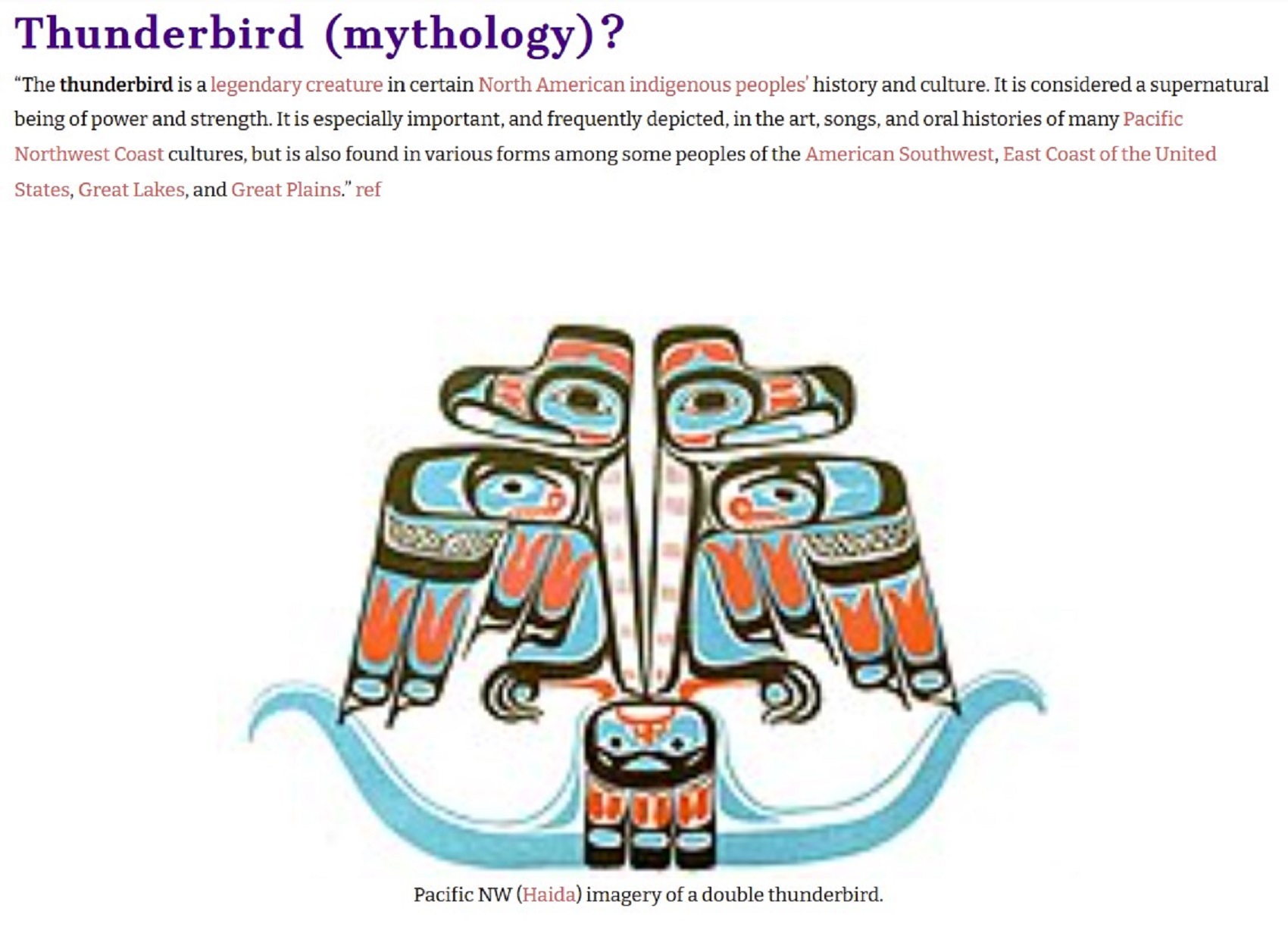
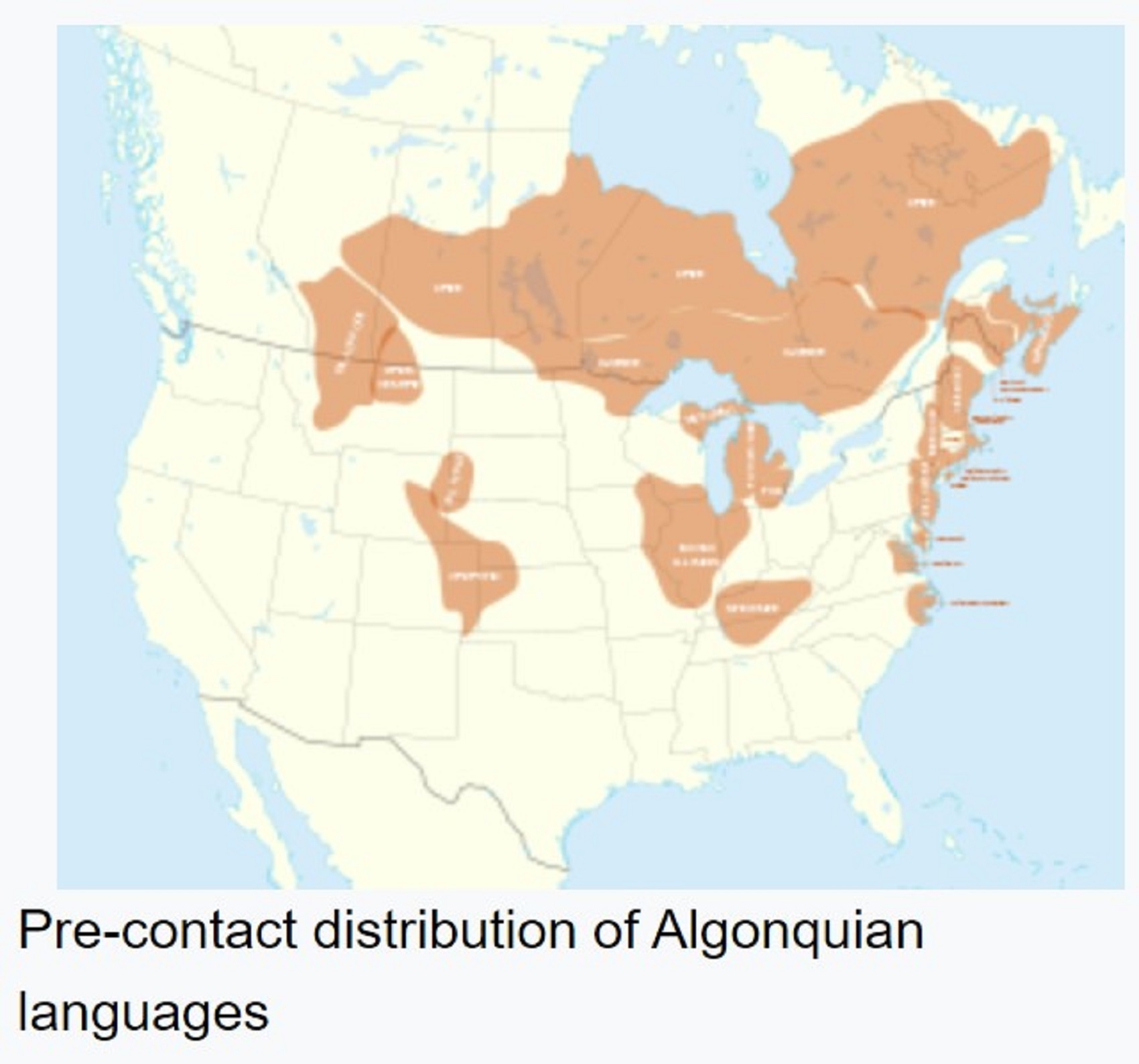
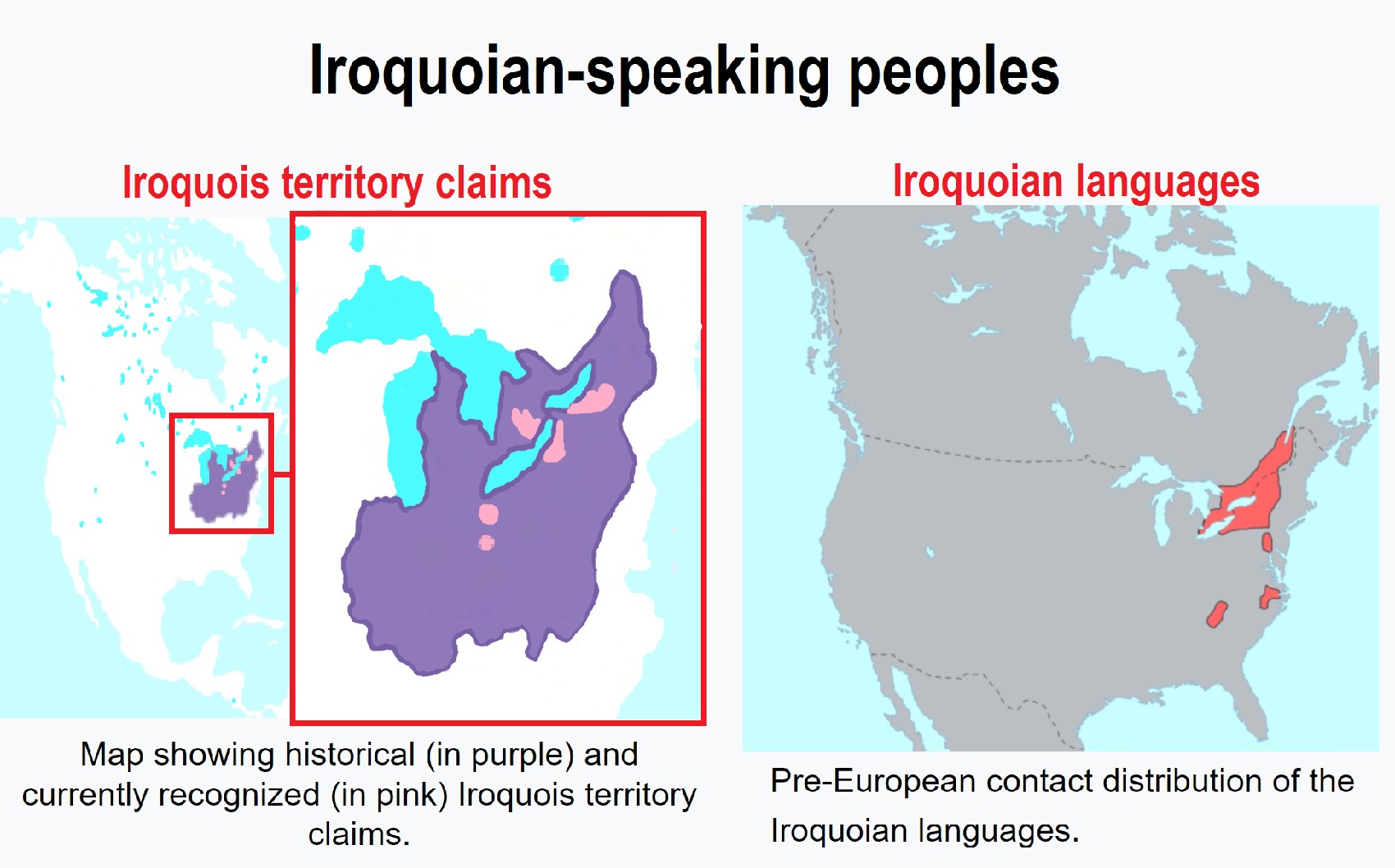
“The Algonquian are one of the most populous and widespread North American native language groups. Historically, the peoples were prominent along the Atlantic Coast and into the interior along the Saint Lawrence River and around the Great Lakes. This grouping consists of the peoples who speak Algonquian languages. Before Europeans came into contact, most Algonquian settlements lived by hunting and fishing, although quite a few supplemented their diet by cultivating corn, beans, and squash (the “Three Sisters”). The Ojibwe cultivated wild rice.” ref
“At the time of the first European settlements in North America, Algonquian peoples occupied what is now New Brunswick, and much of what is now Canada east of the Rocky Mountains; what is now New England, New Jersey, southeastern New York, Delaware, and down the Atlantic Coast through the Upper South; and around the Great Lakes in present-day Minnesota, Wisconsin, Michigan, Illinois, Indiana, and Iowa. The homeland of the Algonquian peoples is not known. At the time of the European arrival, the hegemonic Iroquois Confederacy, based in present-day New York and Pennsylvania, was regularly at war with Algonquian neighbors.” ref
Algonquian Tribal identity?
New England area
“Colonists in the Massachusetts Bay area first encountered the Wampanoag, Massachusett, Nipmuc, Pennacook, Penobscot, Passamaquoddy, and Quinnipiac. The Mohegan, Pequot, Pocumtuc, Podunk, Tunxis, and Narragansett were based in southern New England. The Abenaki were located in northern New England: present-day Maine, New Hampshire, and Vermont in what became the United States and eastern Quebec in what became Canada. They had established trading relationships with French colonists who settled along the Atlantic coast and what was later called the Saint Lawrence River. The Mahican were located in western New England in the upper Hudson River Valley (around what was developed by Europeans as Albany, New York). These groups practiced agriculture, hunting, and fishing.” ref
“The Algonquians of New England such as the Piscataway, (who spoke Eastern Algonquian) practiced a seasonal economy. The basic social unit was the village: a few hundred people related by a clan kinship structure. Villages were temporary and mobile. The people moved to locations of greatest natural food supply, often breaking into smaller units or gathering as the circumstances required. This custom resulted in a certain degree of cross-tribal mobility, especially in troubled times.” ref
“In warm weather, they constructed portable wigwams, a type of hut usually with buckskin doors. In the winter, they erected the more substantial longhouses, in which more than one clan could reside. They cached food supplies in more permanent, semi-subterranean structures.” ref
“In the spring, when the fish were spawning, they left the winter camps to build villages at coastal locations and waterfalls. In March, they caught smelt in nets and weirs, moving about in birch bark canoes. In April, they netted alewife, sturgeon, and salmon. In May, they caught cod with hook and line in the ocean; and trout, smelt, striped bass, and flounder in the estuaries and streams. Putting out to sea, they hunted whales, porpoises, walruses, and seals. They gathered scallops, mussels, clams, and crabs.” ref
“From April through October, natives hunted migratory birds and their eggs: Canada geese, brant, mourning doves and others. In July and August they gathered strawberries, raspberries, blueberries, and nuts. In September, they split into small groups and moved up the streams to the forest. There, they hunted beaver, caribou, moose and white-tailed deer.[5]
“In December, when the snows began, the people created larger winter camps in sheltered locations, where they built or reconstructed longhouses. February and March were lean times. The tribes in southern New England and other northern latitudes had to rely on cached food. Northerners developed a practice of going hungry for several days at a time. Historians hypothesize that this practice kept the population down, according to Liebig’s law of the minimum.” ref
“The southern Algonquians of New England relied predominantly on slash and burn agriculture. They cleared fields by burning for one or two years of cultivation, after which the village moved to another location. This is the reason the English found the region relatively cleared and ready for planting. By using various kinds of native corn (maize), beans, and squash, southern New England natives were able to improve their diet to such a degree that their population increased and they reached a density of 287 people per 100 square miles as opposed to 41 in the north. Scholars estimate that, by the year 1600, the indigenous population of New England had reached 70,000–100,000.” ref
Midwest
“The French encountered Algonquian peoples in this area through their trade and limited colonization of New France along the Mississippi and Ohio rivers. The historic peoples of the Illinois Country were the Shawnee, Illiniwek, Kickapoo, Menominee, Miami, Sauk, and Meskwaki. The latter were also known as the Sac and Fox, and later known as the Meskwaki Indians, who lived throughout the present-day Midwest of the United States.” ref
“During the nineteenth century, many Native Americans from east of the Mississippi River were displaced over great distances through the United States passage and enforcement of Indian removal legislation; they forced the people west of the Mississippi River to what they designated as Indian Territory. After the US extinguished Indian land claims, this area was admitted as the state of Oklahoma in the early 20th century.” ref
Upper west
“Ojibwe/Chippewa, Odawa, Potawatomi, and a variety of Cree groups lived in Upper Peninsula of Michigan, Western Ontario, Wisconsin, Minnesota, and the Canadian Prairies. The Arapaho, Blackfoot, and Cheyenne developed as indigenous to the Great Plains.” ref
List of historic Algonquian-speaking peoples
- Algonquin
- AbenakiMissiquoi
Pennacook - Arapaho
- Beothuk
- Blackfoot
- Cheyenne
- Chowanoke
- Cree
- Gros Ventre
- Illinois
- Kickapoo
- Lenape
MunseeWappinger
Unami - Meskwaki
- Menominee
- Mahican
- Maliseet
- Mascouten
- Massachusett
- MattabesicMattabessett
Podunk
Tunxis
Paugussett
Quinnipiac
Unquachog - Miami
- Mi’kmaq
- Montaukett
- Mohegan
- Nanticoke
- Narragansett
- Nipissing
- Nipmuc
- Odawa
- OjibweMississauga
- Passamaquoddy
- Penobscot
- Pequot
- PiscatawayNacotchtank
- Potawatomi
- Powhatan
- Roanoke peopleCroatan
- Sauk
- ShawneeChalahgawtha
Hathawekela
Kispoko
Mekoche
Pekowi - Secotan
- Wampanoag
- Weapemeoc
21. Munsee (nearly extinct)22. Unami (†)23. Nanticoke–Piscataway (†)24. Carolina Algonquian (†)25. Powhatan (†)26. Etchemin (†) (uncertain – See Eastern Algonquian languages)27. Loup A (†) (probably Nipmuck (†), uncertain – See Eastern Algonquian languages)28. Loup B (†) (uncertain – See Eastern Algonquian languages)29. Shinnecock (†) (uncertain)Algonquian languages?
“The Algonquian languages also Algonkian) are a subfamily of American indigenous languages that include most languages in the Algic language family. The name of the Algonquian language family is distinguished from the orthographically similar Algonquin dialect of the Indigenous Ojibwe language (Chippewa), which is a senior member of the Algonquian language family. The term Algonquin has been suggested to derive from the Maliseet word elakómkwik, “they are our relatives/allies”. A number of Algonquian languages, like many other Native American languages, are now extinct.” ref
“Speakers of Algonquian languages stretch from the east coast of North America to the Rocky Mountains. The proto-language from which all of the languages of the family descend, Proto-Algonquian, was spoken around 2,500 to 3,000 years ago. There is no scholarly consensus about where this language was spoken.” ref
“This subfamily of around 30 languages is divided into three groups according to geography: Plains, Central, and Eastern Algonquian; of these three, only Eastern Algonquian constitutes a true genetic subgroup. The languages are listed below, following the classifications of Goddard (1996) and Mithun (1999). Extinct languages are marked with †, and endangered languages are noted as such. For dialects and subdialects, consult the separate main articles for each of the three divisions.” ref
Plains1. BlackfootArapahoan (including Nawathinehena (†), and Besawunena (†))2. Arapaho proper3. Gros Ventre (†)4. CheyenneCentral5. Cree–Innu–Naskapi6. Menominee (severely endangered)Ojibwe–Potawatomi7. Ojibwe8. Potawatomi (nearly extinct)9. Sauk–Fox–Kickapoo (severely endangered)10. Shawnee (severely endangered)11. Miami–Illinois (†)Eastern12. MiꞌkmaqAbenaki13. Western Abenaki (nearly extinct)14. Eastern Abenaki (†)15. Malecite–Passamaquoddy16. Massachusett17. Narragansett (†)18. Mohegan–Pequot (†)19. Quiripi-Naugatuck-Unquachog (†)20. Mahican (†)Lenape


Groups partially derived from the Ancient North Eurasians
“The ANE lineage is defined by association with the MA-1, or “Mal’ta boy”, remains of 24,000 years ago in central Siberia Mal’ta-Buret’ culture 24,000-15,000 years ago. The Ancient North Eurasians (ANE) samples (Afontova Gora 3, Mal’ta 1, and Yana-RHS) show evidence for minor gene flow from an East Asian-related group (simplified by the Amis, Han, or Tianyuan) but no evidence for ANE-related geneflow into East Asians (Amis, Han, Tianyuan), except the Ainu, of North Japan.” ref
“The ANE lineage is defined by association with the MA-1, or “Mal’ta boy”, remains of 24,000 years ago in central Siberia Mal’ta-Buret’ culture 24,000-15,000 years ago “basal to modern-day Europeans”. Some Ancient North Eurasians also carried East Asian populations, such as Tianyuan Man.” ref
“Bronze-age-steppe Yamnaya and Afanasevo cultures were ANE at around 50% and Eastern Hunter-Gatherer (EHG) at around 75% ANE. Karelia culture: Y-DNA R1a-M417 8,400 years ago, Y-DNA J, 7,200 years ago, and Samara, of Y-haplogroup R1b-P297 7,600 years ago is closely related to ANE from Afontova Gora, 18,000 years ago around the time of blond hair first seen there.” ref
Ancient North Eurasian
“In archaeogenetics, the term Ancient North Eurasian (often abbreviated as ANE) is the name given to an ancestral West Eurasian component that represents descent from the people similar to the Mal’ta–Buret’ culture and populations closely related to them, such as from Afontova Gora and the Yana Rhinoceros Horn Site. Significant ANE ancestry are found in some modern populations, including Europeans and Native Americans.” ref
“The ANE lineage is defined by association with the MA-1, or “Mal’ta boy“, the remains of an individual who lived during the Last Glacial Maximum, 24,000 years ago in central Siberia, Ancient North Eurasians are described as a lineage “which is deeply related to Paleolithic/Mesolithic hunter-gatherers in Europe,” meaning that they diverged from Paleolithic Europeans a long time ago.” ref
“The ANE population has also been described as having been “basal to modern-day Europeans” but not especially related to East Asians, and is suggested to have perhaps originated in Europe or Western Asia or the Eurasian Steppe of Central Asia. However, some samples associated with Ancient North Eurasians also carried ancestry from an ancient East Asian population, such as Tianyuan Man. Sikora et al. (2019) found that the Yana RHS sample (31,600 BP) in Northern Siberia “can be modeled as early West Eurasian with an approximately 22% contribution from early East Asians.” ref
“Populations genetically similar to MA-1 were an important genetic contributor to Native Americans, Europeans, Central Asians, South Asians, and some East Asian groups, in order of significance. Lazaridis et al. (2016:10) note “a cline of ANE ancestry across the east-west extent of Eurasia.” The ancient Bronze-age-steppe Yamnaya and Afanasevo cultures were found to have a noteworthy ANE component at ~50%.” ref
“According to Moreno-Mayar et al. 2018 between 14% and 38% of Native American ancestry may originate from gene flow from the Mal’ta–Buret’ people (ANE). This difference is caused by the penetration of posterior Siberian migrations into the Americas, with the lowest percentages of ANE ancestry found in Eskimos and Alaskan Natives, as these groups are the result of migrations into the Americas roughly 5,000 years ago.” ref
“Estimates for ANE ancestry among first wave Native Americans show higher percentages, such as 42% for those belonging to the Andean region in South America. The other gene flow in Native Americans (the remainder of their ancestry) was of East Asian origin. Gene sequencing of another south-central Siberian people (Afontova Gora-2) dating to approximately 17,000 years ago, revealed similar autosomal genetic signatures to that of Mal’ta boy-1, suggesting that the region was continuously occupied by humans throughout the Last Glacial Maximum.” ref
“The earliest known individual with a genetic mutation associated with blonde hair in modern Europeans is an Ancient North Eurasian female dating to around 16000 BCE from the Afontova Gora 3 site in Siberia. It has been suggested that their mythology may have included a narrative, found in both Indo-European and some Native American fables, in which a dog guards the path to the afterlife.” ref
“Genomic studies also indicate that the ANE component was introduced to Western Europe by people related to the Yamnaya culture, long after the Paleolithic. It is reported in modern-day Europeans (7%–25%), but not of Europeans before the Bronze Age. Additional ANE ancestry is found in European populations through paleolithic interactions with Eastern Hunter-Gatherers, which resulted in populations such as Scandinavian Hunter-Gatherers.” ref
“The Ancient North Eurasians (ANE) split from the ancestors of European peoples somewhere in the Middle East or South-central Asia, and used a northern dispersal route through Central Asia into Northern Asia and Siberia. Genetic analyses show that all ANE samples (Afontova Gora 3, Mal’ta 1, and Yana-RHS) show evidence for minor gene flow from an East Asian-related group (simplified by the Amis, Han, or Tianyuan). In contrast, no evidence for ANE-related geneflow into East Asians (Amis, Han, Tianyuan), except the Ainu, was found.” ref
“Genetic data suggests that the ANE formed during the Terminal Upper-Paleolithic (36+-1,5ka) period from a deeply European-related population, which was once widespread in Northern Eurasia, and from an early East Asian-related group, which migrated northwards into Central Asia and Siberia, merging with this deeply European-related population. These population dynamics and constant northwards geneflow of East Asian-related ancestry would later gave rise to the “Ancestral Native Americans” and Paleosiberians, which replaced the ANE as dominant population of Siberia.” ref
Groups partially derived from the Ancient North Eurasians
“Eastern Hunter-Gatherer (EHG) is a lineage derived predominantly (75%) from ANE. It is represented by two individuals from Karelia, one of Y-haplogroup R1a-M417, dated c. 8.4 kya, the other of Y-haplogroup J, dated c. 7.2 kya; and one individual from Samara, of Y-haplogroup R1b-P297, dated c. 7.6 kya. This lineage is closely related to the ANE sample from Afontova Gora, dated c. 18 kya. After the end of the Last Glacial Maximum, the Western Hunter-Gatherers (WHG) and EHG lineages merged in Eastern Europe, accounting for early presence of ANE-derived ancestry in Mesolithic Europe. Evidence suggests that as Ancient North Eurasians migrated West from Eastern Siberia, they absorbed Western Hunter-Gatherers and other West Eurasian populations as well.” ref
“Caucasian Hunter-Gatherer (CHG) is represented by the Satsurblia individual dated ~13 kya (from the Satsurblia cave in Georgia), and carried 36% ANE-derived admixture. While the rest of their ancestry is derived from the Dzudzuana cave individual dated ~26 kya, which lacked ANE-admixture, Dzudzuana affinity in the Caucasus decreased with the arrival of ANE at ~13 kya Satsurblia.” ref
“Scandinavian Hunter-Gatherer (SHG) is represented by several individuals buried at Motala, Sweden ca. 6000 BC. They were descended from Western Hunter-Gatherers who initially settled Scandinavia from the south, and later populations of EHG who entered Scandinavia from the north through the coast of Norway.” ref
“Iran Neolithic (Iran_N) individuals dated ~8.5 kya carried 50% ANE-derived admixture and 50% Dzudzuana-related admixture, marking them as different from other Near-Eastern and Anatolian Neolithics who didn’t have ANE admixture. Iran Neolithics were later replaced by Iran Chalcolithics, who were a mixture of Iran Neolithic and Near Eastern Levant Neolithic.” ref
“Ancient Beringian/Ancestral Native American are specific archaeogenetic lineages, based on the genome of an infant found at the Upward Sun River site (dubbed USR1), dated to 11,500 years ago. The AB lineage diverged from the Ancestral Native American (ANA) lineage about 20,000 years ago.” ref
“West Siberian Hunter-Gatherer (WSHG) are a specific archaeogenetic lineage, first reported in a genetic study published in Science in September 2019. WSGs were found to be of about 30% EHG ancestry, 50% ANE ancestry, and 20% to 38% East Asian ancestry.” ref
“Western Steppe Herders (WSH) is the name given to a distinct ancestral component that represents descent closely related to the Yamnaya culture of the Pontic–Caspian steppe. This ancestry is often referred to as Yamnaya ancestry or Steppe ancestry.” ref
“Late Upper Paeolithic Lake Baikal – Ust’Kyakhta-3 (UKY) 14,050-13,770 BP were mixture of 30% ANE ancestry and 70% East Asian ancestry.” ref
“Lake Baikal Holocene – Baikal Eneolithic (Baikal_EN) and Baikal Early Bronze Age (Baikal_EBA) derived 6.4% to 20.1% ancestry from ANE, while rest of their ancestry was derived from East Asians. Fofonovo_EN near by Lake Baikal were mixture of 12-17% ANE ancestry and 83-87% East Asian ancestry.” ref
“Hokkaido Jōmon people specifically refers to the Jōmon period population of Hokkaido in northernmost Japan. Though the Jōmon people themselves descended mainly from East Asian lineages, one study found an affinity between Hokkaido Jōmon with the Northern Eurasian Yana sample (an ANE-related group, related to Mal’ta), and suggest as an explanation the possibility of minor Yana gene flow into the Hokkaido Jōmon population (as well as other possibilities). A more recent study by Cooke et al. 2021, confirmed ANE-related geneflow among the Jōmon people, partially ancestral to the Ainu people. ANE ancestry among Jōmon people is estimated at 21%, however, there is a North to South cline within the Japanese archipelago, with the highest amount of ANE ancestry in Hokkaido and Tohoku.” ref

ref, ref, ref, ref, ref, ref, ref, ref, ref, ref, ref, ref, ref, ref, ref, ref, ref
“The shaman is, above all, a connecting figure, bridging several worlds for his people, traveling between this world, the underworld, and the heavens. He transforms himself into an animal and talks with ghosts, the dead, the deities, and the ancestors. He dies and revives. He brings back knowledge from the shadow realm, thus linking his people to the spirits and places which were once mythically accessible to all.–anthropologist Barbara Meyerhoff” ref
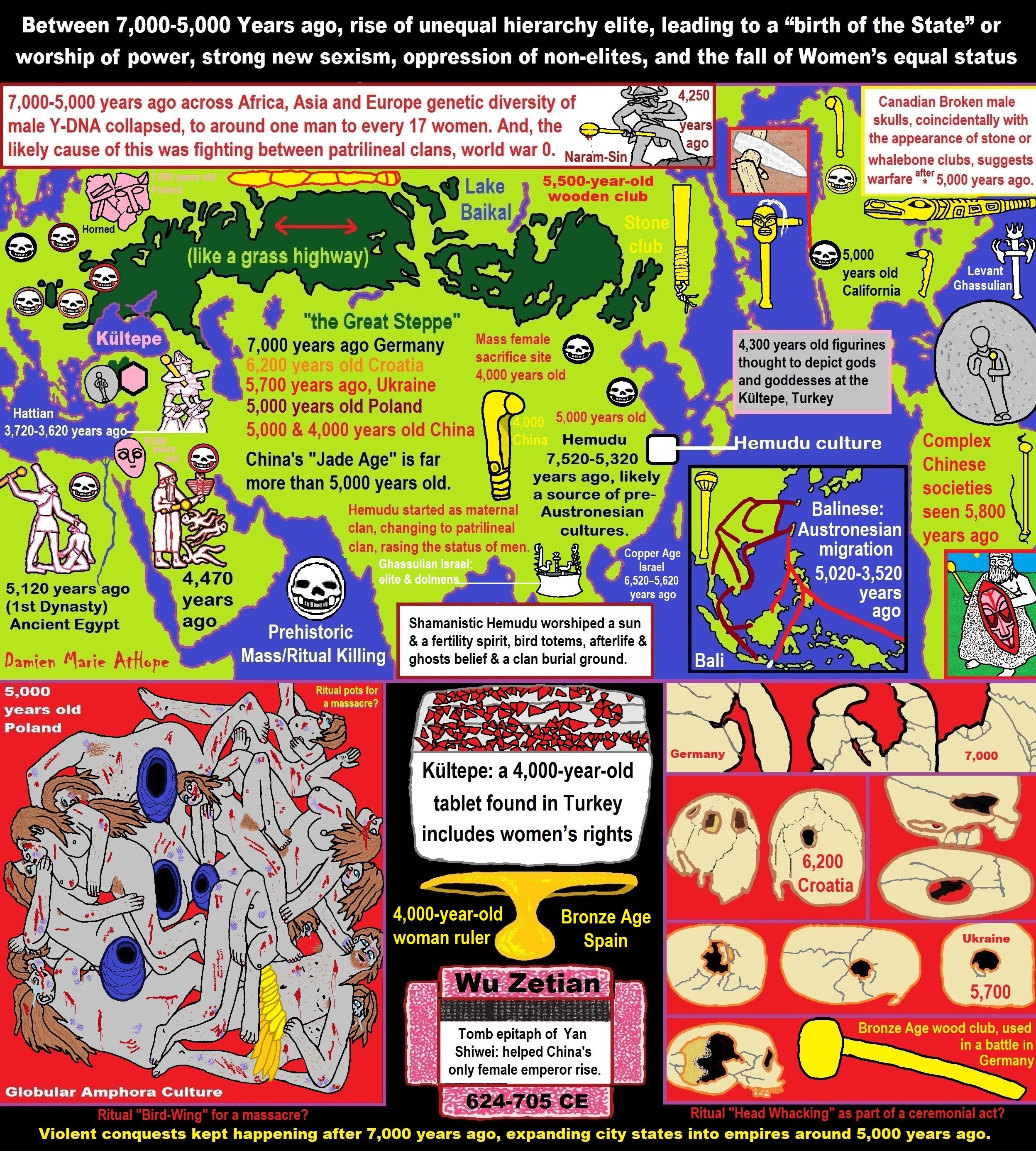
ref, ref, ref, ref, ref, ref, ref, ref, ref, ref, ref, ref, ref, ref, ref, ref, ref, ref, ref, ref, ref, ref, ref, ref, ref, ref, ref, ref, ref, ref, ref, ref, ref, ref, ref, ref, ref, ref, ref, ref, ref, ref, ref, ref, ref, ref, ref, ref, ref, ref, ref, ref, ref, ref, ref, ref, ref, ref, ref, ref, ref, ref, ref, ref, ref, ref, ref, ref, ref, ref, ref, ref, ref, ref, ref, ref, ref, ref, ref, ref, ref, ref, ref, ref, ref, ref, ref, ref, ref, ref
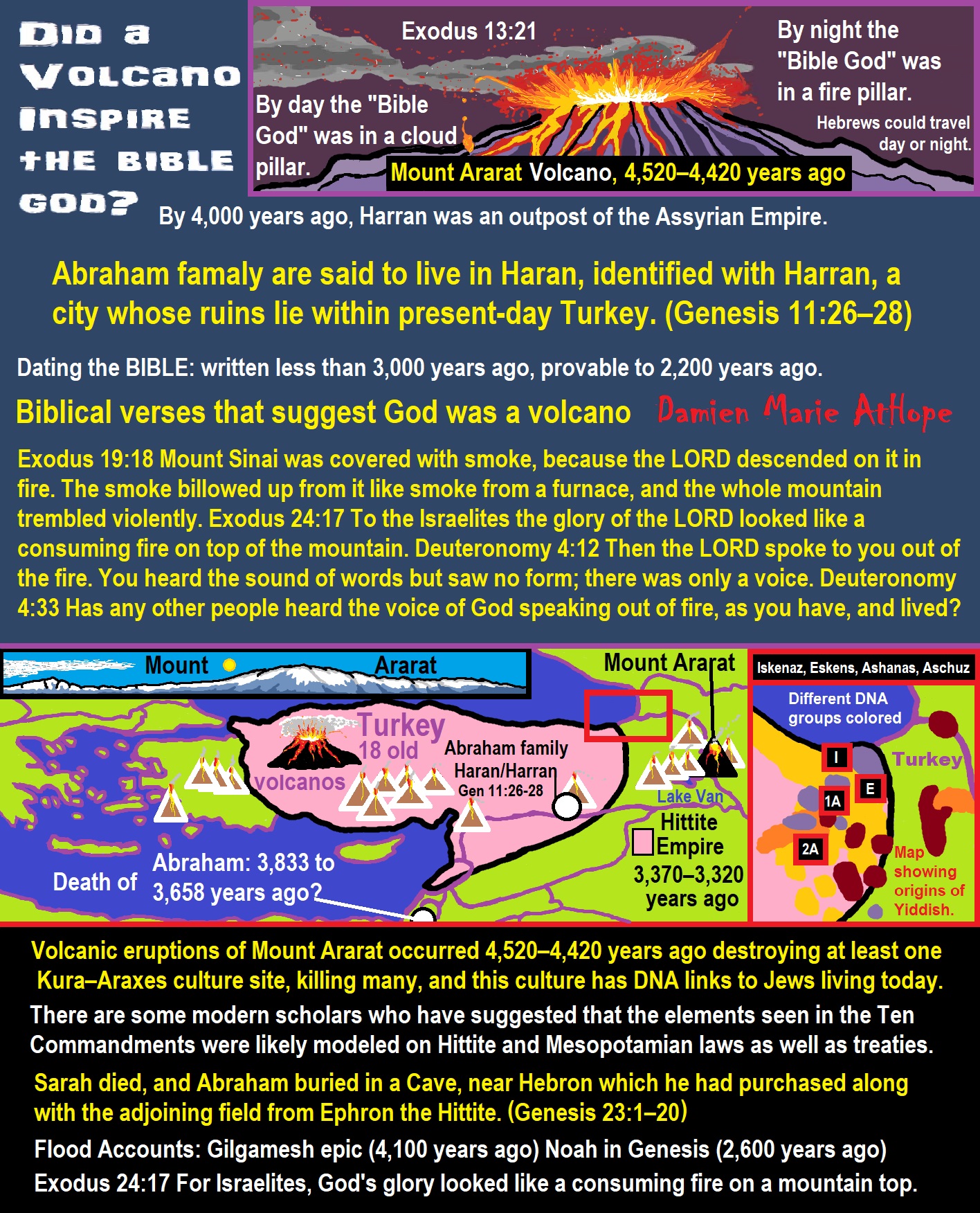
ref, ref, ref, ref, ref, ref, ref, ref, ref, ref, ref, ref, ref
By day the LORD went ahead of them in a pillar of cloud to guide them on their way and by night in a pillar of fire to give them light, so that they could travel by day or night.
- By day the “Bible God” was in a cloud pillar.
- By night the “Bible God” was in a fire pillar.
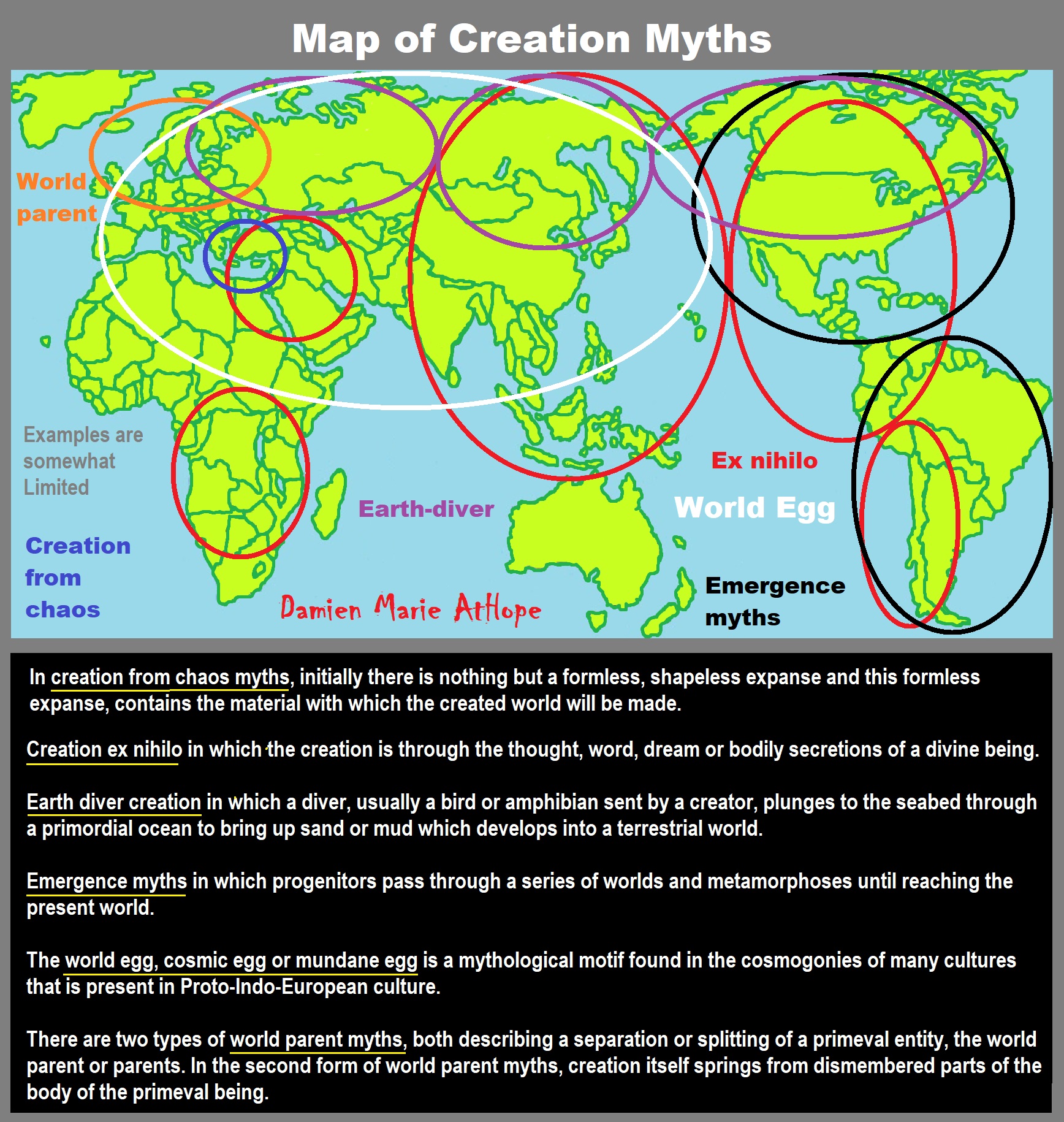
Creation myths: From chaos, Ex nihilo, Earth-diver, Emergence, World egg, and World parent
“A creation myth (or cosmogonic myth) is a symbolic narrative of how the world began and how people first came to inhabit it. While in popular usage the term myth often refers to false or fanciful stories, members of cultures often ascribe varying degrees of truth to their creation myths. In the society in which it is told, a creation myth is usually regarded as conveying profound truths – metaphorically, symbolically, historically, or literally. They are commonly, although not always, considered cosmogonical myths – that is, they describe the ordering of the cosmos from a state of chaos or amorphousness.” ref
“Creation myths often share a number of features. They often are considered sacred accounts and can be found in nearly all known religious traditions. They are all stories with a plot and characters who are either deities, human-like figures, or animals, who often speak and transform easily. They are often set in a dim and nonspecific past that historian of religion Mircea Eliade termed in illo tempore (‘at that time’). Creation myths address questions deeply meaningful to the society that shares them, revealing their central worldview and the framework for the self-identity of the culture and individual in a universal context. Creation myths develop in oral traditions and therefore typically have multiple versions; found throughout human culture, they are the most common form of myth.” ref
Creation myth definitions from modern references:
- “A “symbolic narrative of the beginning of the world as understood in a particular tradition and community. Creation myths are of central importance for the valuation of the world, for the orientation of humans in the universe, and for the basic patterns of life and culture.”
- “Creation myths tell us how things began. All cultures have creation myths; they are our primary myths, the first stage in what might be called the psychic life of the species. As cultures, we identify ourselves through the collective dreams we call creation myths, or cosmogonies. … Creation myths explain in metaphorical terms our sense of who we are in the context of the world, and in so doing they reveal our real priorities, as well as our real prejudices. Our images of creation say a great deal about who we are.”
- A “philosophical and theological elaboration of the primal myth of creation within a religious community. The term myth here refers to the imaginative expression in narrative form of what is experienced or apprehended as basic reality … The term creation refers to the beginning of things, whether by the will and act of a transcendent being, by emanation from some ultimate source, or in any other way.” ref
Religion professor Mircea Eliade defined the word myth in terms of creation:
“Myth narrates a sacred history; it relates an event that took place in primordial Time, the fabled time of the “beginnings.” In other words, myth tells how, through the deeds of Supernatural Beings, a reality came into existence, be it the whole of reality, the Cosmos, or only a fragment of reality – an island, a species of plant, a particular kind of human behavior, an institution.” ref
“All creation myths are in one sense etiological because they attempt to explain how the world formed and where humanity came from. Myths attempt to explain the unknown and sometimes teach a lesson.” ref
“Some Ethnologists and anthropologists who study origin myths say that in the modern context theologians try to discern humanity’s meaning from revealed truths and scientists investigate cosmology with the tools of empiricism and rationality, but creation myths define human reality in very different terms. In the past, historians of religion and other students of myth thought of such stories as forms of primitive or early-stage science or religion and analyzed them in a literal or logical sense. Today, however, they are seen as symbolic narratives which must be understood in terms of their own cultural context. Charles Long writes: “The beings referred to in the myth – gods, animals, plants – are forms of power grasped existentially. The myths should not be understood as attempts to work out a rational explanation of deity.” ref
“While creation myths are not literal explications, they do serve to define an orientation of humanity in the world in terms of a birth story. They provide the basis of a worldview that reaffirms and guides how people relate to the natural world, to any assumed spiritual world, and to each other. A creation myth acts as a cornerstone for distinguishing primary reality from relative reality, the origin and nature of being from non-being. In this sense, cosmogonic myths serve as a philosophy of life – but one expressed and conveyed through symbol rather than through systematic reason. And in this sense, they go beyond etiological myths (which explain specific features in religious rites, natural phenomena, or cultural life). Creation myths also help to orient human beings in the world, giving them a sense of their place in the world and the regard that they must have for humans and nature.” ref
Historian David Christian has summarised issues common to multiple creation myths:
“Each beginning seems to presuppose an earlier beginning. … Instead of meeting a single starting point, we encounter an infinity of them, each of which poses the same problem. … There are no entirely satisfactory solutions to this dilemma. What we have to find is not a solution but some way of dealing with the mystery …. And we have to do so using words. The words we reach for, from God to gravity, are inadequate to the task. So we have to use language poetically or symbolically; and such language, whether used by a scientist, a poet, or a shaman, can easily be misunderstood.” ref
“Mythologists have applied various schemes to classify creation myths found throughout human cultures. Eliade and his colleague Charles Long developed a classification based on some common motifs that reappear in stories the world over. The classification identifies five basic types: Brahmā, the Hindu deva of creation, emerges from a lotus risen from the navel of Viṣņu, who lies with Lakshmi on the serpent Ananta Shesha.” ref
- “Creation ex nihilo in which the creation is through the thought, word, dream, or bodily secretions of a divine being.
- Earth diver creation in which a diver, usually a bird or amphibian sent by a creator, plunges to the seabed through a primordial ocean to bring up sand or mud which develops into a terrestrial world.
- Emergence myths in which progenitors pass through a series of worlds and metamorphoses until reaching the present world.
- Creation by the dismemberment of a primordial being.
- Creation by the splitting or ordering of a primordial unity such as the cracking of a cosmic egg or a bringing order from chaos.” ref
“Marta Weigle further developed and refined this typology to highlight nine themes, adding elements such as deus faber, a creation crafted by a deity, creation from the work of two creators working together or against each other, creation from sacrifice, and creation from division/conjugation, accretion/conjunction, or secretion.” ref
An alternative system based on six recurring narrative themes was designed by Raymond Van Over:
- “Primeval abyss, an infinite expanse of waters or space.
- Originator deity which is awakened or an eternal entity within the abyss.
- Originator deity poised above the abyss.
- Cosmic egg or embryo.
- Originator deity creating life through sound or word.
- Life generating from the corpse or dismembered parts of an originator deity.” ref


Animism: Respecting the Living World by Graham Harvey
“How have human cultures engaged with and thought about animals, plants, rocks, clouds, and other elements in their natural surroundings? Do animals and other natural objects have a spirit or soul? What is their relationship to humans? In this new study, Graham Harvey explores current and past animistic beliefs and practices of Native Americans, Maori, Aboriginal Australians, and eco-pagans. He considers the varieties of animism found in these cultures as well as their shared desire to live respectfully within larger natural communities. Drawing on his extensive casework, Harvey also considers the linguistic, performative, ecological, and activist implications of these different animisms.” ref


My thoughts on Religion Evolution with external links for more info:
- (Pre-Animism Africa mainly, but also Europe, and Asia at least 300,000 years ago), (Pre-Animism – Oxford Dictionaries)
- (Animism Africa around 100,000 years ago), (Animism – Britannica.com)
- (Totemism Europe around 50,000 years ago), (Totemism – Anthropology)
- (Shamanism Siberia around 30,000 years ago), (Shamanism – Britannica.com)
- (Paganism Turkey around 12,000 years ago), (Paganism – BBC Religion)
- (Progressed Organized Religion “Institutional Religion” Egypt around 5,000 years ago), (Ancient Egyptian Religion – Britannica.com)
- (CURRENT “World” RELIGIONS after 4,000 years ago) (Origin of Major Religions – Sacred Texts)
- (Early Atheistic Doubting at least by 2,600 years ago) (History of Atheism – Wikipedia)
“Religion is an Evolved Product” and Yes, Religion is Like Fear Given Wings…
Atheists talk about gods and religions for the same reason doctors talk about cancer, they are looking for a cure, or a firefighter talks about fires because they burn people and they care to stop them. We atheists too often feel a need to help the victims of mental slavery, held in the bondage that is the false beliefs of gods and the conspiracy theories of reality found in religions.
Understanding Religion Evolution:
- Pre-Animism (at least 300,000 years ago)
- Animism (Africa: 100,000 years ago)
- Totemism (Europe: 50,000 years ago)
- Shamanism (Siberia: 30,000 years ago)
- Paganism (Turkey: 12,000 years ago)
- Progressed organized religion (Egypt: 5,000 years ago), (Egypt, the First Dynasty 5,150 years ago)
- CURRENT “World” RELIGIONS (after 4,000 years ago)
- Early Atheistic Doubting (at least by 2,600 years ago)
“An Archaeological/Anthropological Understanding of Religion Evolution”
It seems ancient peoples had to survived amazing threats in a “dangerous universe (by superstition perceived as good and evil),” and human “immorality or imperfection of the soul” which was thought to affect the still living, leading to ancestor worship. This ancestor worship presumably led to the belief in supernatural beings, and then some of these were turned into the belief in gods. This feeble myth called gods were just a human conceived “made from nothing into something over and over, changing, again and again, taking on more as they evolve, all the while they are thought to be special,” but it is just supernatural animistic spirit-belief perceived as sacred.
Quick Evolution of Religion?
Pre-Animism (at least 300,000 years ago) pre-religion is a beginning that evolves into later Animism. So, Religion as we think of it, to me, all starts in a general way with Animism (Africa: 100,000 years ago) (theoretical belief in supernatural powers/spirits), then this is physically expressed in or with Totemism (Europe: 50,000 years ago) (theoretical belief in mythical relationship with powers/spirits through a totem item), which then enlists a full-time specific person to do this worship and believed interacting Shamanism (Siberia/Russia: 30,000 years ago) (theoretical belief in access and influence with spirits through ritual), and then there is the further employment of myths and gods added to all the above giving you Paganism (Turkey: 12,000 years ago) (often a lot more nature-based than most current top world religions, thus hinting to their close link to more ancient religious thinking it stems from). My hypothesis is expressed with an explanation of the building of a theatrical house (modern religions development). Progressed organized religion (Egypt: 5,000 years ago) with CURRENT “World” RELIGIONS (after 4,000 years ago).
Historically, in large city-state societies (such as Egypt or Iraq) starting around 5,000 years ago culminated to make religion something kind of new, a sociocultural-governmental-religious monarchy, where all or at least many of the people of such large city-state societies seem familiar with and committed to the existence of “religion” as the integrated life identity package of control dynamics with a fixed closed magical doctrine, but this juggernaut integrated religion identity package of Dogmatic-Propaganda certainly did not exist or if developed to an extent it was highly limited in most smaller prehistoric societies as they seem to lack most of the strong control dynamics with a fixed closed magical doctrine (magical beliefs could be at times be added or removed). Many people just want to see developed religious dynamics everywhere even if it is not. Instead, all that is found is largely fragments until the domestication of religion.
Religions, as we think of them today, are a new fad, even if they go back to around 6,000 years in the timeline of human existence, this amounts to almost nothing when seen in the long slow evolution of religion at least around 70,000 years ago with one of the oldest ritual worship. Stone Snake of South Africa: “first human worship” 70,000 years ago. This message of how religion and gods among them are clearly a man-made thing that was developed slowly as it was invented and then implemented peace by peace discrediting them all. Which seems to be a simple point some are just not grasping how devastating to any claims of truth when we can see the lie clearly in the archeological sites.
I wish people fought as hard for the actual values as they fight for the group/clan names political or otherwise they think support values. Every amount spent on war is theft to children in need of food or the homeless kept from shelter.
Here are several of my blog posts on history:
- To Find Truth You Must First Look
- (Magdalenian/Iberomaurusian) Connections to the First Paganists of the early Neolithic Near East Dating from around 17,000 to 12,000 Years Ago
- Natufians: an Ancient People at the Origins of Agriculture and Sedentary Life
- Possible Clan Leader/Special “MALE” Ancestor Totem Poles At Least 13,500 years ago?
- Jewish People with DNA at least 13,200 years old, Judaism, and the Origins of Some of its Ideas
- Baltic Reindeer Hunters: Swiderian, Lyngby, Ahrensburgian, and Krasnosillya cultures 12,020 to 11,020 years ago are evidence of powerful migratory waves during the last 13,000 years and a genetic link to Saami and the Finno-Ugric peoples.
- The Rise of Inequality: patriarchy and state hierarchy inequality
- Fertile Crescent 12,500 – 9,500 Years Ago: fertility and death cult belief system?
- 12,400 – 11,700 Years Ago – Kortik Tepe (Turkey) Pre/early-Agriculture Cultic Ritualism
- Ritualistic Bird Symbolism at Gobekli Tepe and its “Ancestor Cult”
- Male-Homosexual (female-like) / Trans-woman (female) Seated Figurine from Gobekli Tepe
- Could a 12,000-year-old Bull Geoglyph at Göbekli Tepe relate to older Bull and Female Art 25,000 years ago and Later Goddess and the Bull cults like Catal Huyuk?
- Sedentism and the Creation of goddesses around 12,000 years ago as well as male gods after 7,000 years ago.
- Alcohol, where Agriculture and Religion Become one? Such as Gobekli Tepe’s Ritualistic use of Grain as Food and Ritual Drink
- Neolithic Ritual Sites with T-Pillars and other Cultic Pillars
- Paganism: Goddesses around 12,000 years ago then Male Gods after 7,000 years ago
- First Patriarchy: Split of Women’s Status around 12,000 years ago & First Hierarchy: fall of Women’s Status around 5,000 years ago.
- Natufians: an Ancient People at the Origins of Agriculture and Sedentary Life
- J DNA and the Spread of Agricultural Religion (paganism)
- Paganism: an approximately 12,000-year-old belief system
- Paganism 12,000 years old: related to “Anarchism and Socialism” (Pre-Capitalism)
- Shaman burial in Israel 12,000 years ago and the Shamanism Phenomena
- Need to Mythicized: gods and goddesses
- 12,000 – 7,000 Years Ago – Paleo-Indian Culture (The Americas)
- 12,000 – 2,000 Years Ago – Indigenous-Scandinavians (Nordic)
- Norse did not wear helmets with horns?
- Pre-Pottery Neolithic Skull Cult around 11,500 to 8,400 Years Ago?
- 10,400 – 10,100 Years Ago, in Turkey the Nevail Cori Religious Settlement
- 9,000-6,500 Years Old Submerged Pre-Pottery/Pottery Neolithic Ritual Settlements off Israel’s Coast
- Catal Huyuk “first religious designed city” around 9,500 to 7,700 years ago (Turkey)
- Cultic Hunting at Catal Huyuk “first religious designed city”
- Special Items and Art as well as Special Elite Burials at Catal Huyuk
- New Rituals and Violence with the appearance of Pottery and People?
- Haplogroup N and its related Uralic Languages and Cultures
- Ainu people, Sámi people, Native Americans, the Ancient North Eurasians, and Paganistic-Shamanism with Totemism
- Ideas, Technology and People from Turkey, Europe, to China and Back again 9,000 to 5,000 years ago?
- First Pottery of Europe and the Related Cultures
- 9,000 years old Neolithic Artifacts Judean Desert and Hills Israel
- 9,000-7,000 years-old Sex and Death Rituals: Cult Sites in Israel, Jordan, and the Sinai
- 9,000-8500 year old Horned Female shaman Bad Dürrenberg Germany
- Neolithic Jewelry and the Spread of Farming in Europe Emerging out of West Turkey
- 8,600-year-old Tortoise Shells in Neolithic graves in central China have Early Writing and Shamanism
- Swing of the Mace: the rise of Elite, Forced Authority, and Inequality begin to Emerge 8,500 years ago?
- Migrations and Changing Europeans Beginning around 8,000 Years Ago
- My “Steppe-Anatolian-Kurgan hypothesis” 8,000/7,000 years ago
- Around 8,000-year-old Shared Idea of the Mistress of Animals, “Ritual” Motif
- Pre-Columbian Red-Paint (red ochre) Maritime Archaic Culture 8,000-3,000 years ago
- 7,522-6,522 years ago Linear Pottery culture which I think relates to Arcane Capitalism’s origins
- Arcane Capitalism: Primitive socialism, Primitive capital, Private ownership, Means of production, Market capitalism, Class discrimination, and Petite bourgeoisie (smaller capitalists)
- 7,500-4,750 years old Ritualistic Cucuteni-Trypillian culture of Moldova, Romania, and Ukraine
- Roots of a changing early society 7,200-6,700 years ago Jordan and Israel
- Agriculture religion (Paganism) with farming reached Britain between about 7,000 to 6,500 or so years ago and seemingly expressed in things like Western Europe’s Long Barrows
- My Thoughts on Possible Migrations of “R” DNA and Proto-Indo-European?
- “Millet” Spreading from China 7,022 years ago to Europe and related Language may have Spread with it leading to Proto-Indo-European
- Proto-Indo-European (PIE), ancestor of Indo-European languages: DNA, Society, Language, and Mythology
- The Dnieper–Donets culture and Asian varieties of Millet from China to the Black Sea region of Europe by 7,022 years ago
- Kurgan 6,000 years ago/dolmens 7,000 years ago: funeral, ritual, and other?
- 7,020 to 6,020-year-old Proto-Indo-European Homeland of Urheimat or proposed home of their Language and Religion
- Ancient Megaliths: Kurgan, Ziggurat, Pyramid, Menhir, Trilithon, Dolman, Kromlech, and Kromlech of Trilithons
- The Mytheme of Ancient North Eurasian Sacred-Dog belief and similar motifs are found in Indo-European, Native American, and Siberian comparative mythology
- Elite Power Accumulation: Ancient Trade, Tokens, Writing, Wealth, Merchants, and Priest-Kings
- Sacred Mounds, Mountains, Kurgans, and Pyramids may hold deep connections?
- Between 7,000-5,000 Years ago, rise of unequal hierarchy elite, leading to a “birth of the State” or worship of power, strong new sexism, oppression of non-elites, and the fall of Women’s equal status
- Paganism 7,000-5,000 years old: related to “Anarchism and Socialism” (Capitalism) (World War 0) Elite & their slaves
- Hell and Underworld mythologies starting maybe as far back as 7,000 to 5,000 years ago with the Proto-Indo-Europeans?
- The First Expression of the Male God around 7,000 years ago?
- White (light complexion skin) Bigotry and Sexism started 7,000 years ago?
- Around 7,000-year-old Shared Idea of the Divine Bird (Tutelary and/or Trickster spirit/deity), “Ritual” Motif
- Nekhbet an Ancient Egyptian Vulture Goddess and Tutelary Deity
- 6,720 to 4,920 years old Ritualistic Hongshan Culture of Inner Mongolia with 5,000-year-old Pyramid Mounds and Temples
- First proto-king in the Balkans, Varna culture around 6,500 years ago?
- 6,500–5,800 years ago in Israel Late Chalcolithic (Copper Age) Period in the Southern Levant Seems to Express Northern Levant Migrations, Cultural and Religious Transfer
- KING OF BEASTS: Master of Animals “Ritual” Motif, around 6,000 years old or older…
- Around 6000-year-old Shared Idea of the Solid Wheel & the Spoked Wheel-Shaped Ritual Motif
- “The Ghassulian Star,” a mysterious 6,000-year-old mural from Jordan; a Proto-Star of Ishtar, Star of Inanna or Star of Venus?
- Religious/Ritual Ideas, including goddesses and gods as well as ritual mounds or pyramids from Northeastern Asia at least 6,000 years old, seemingly filtering to Iran, Iraq, the Mediterranean, Europe, Egypt, and the Americas?
- Maykop (5,720–5,020 years ago) Caucasus region Bronze Age culture-related to Copper Age farmers from the south, influenced by the Ubaid period and Leyla-Tepe culture, as well as influencing the Kura-Araxes culture
- 5-600-year-old Tomb, Mummy, and First Bearded Male Figurine in a Grave
- Kura-Araxes Cultural 5,520 to 4,470 years old DNA traces to the Canaanites, Arabs, and Jews
- Minoan/Cretan (Keftiu) Civilization and Religion around 5,520 to 3,120 years ago
- Evolution Of Science at least by 5,500 years ago
- 5,500 Years old birth of the State, the rise of Hierarchy, and the fall of Women’s status
- “Jiroft culture” 5,100 – 4,200 years ago and the History of Iran
- Stonehenge: Paganistic Burial and Astrological Ritual Complex, England (5,100-3,600 years ago)
- Around 5,000-year-old Shared Idea of the “Tree of Life” Ritual Motif
- Complex rituals for elite, seen from China to Egypt, at least by 5,000 years ago
- Around 5,000 years ago: “Birth of the State” where Religion gets Military Power and Influence
- The Center of the World “Axis Mundi” and/or “Sacred Mountains” Mythology Could Relate to the Altai Mountains, Heart of the Steppe
- Progressed organized religion starts, an approximately 5,000-year-old belief system
- China’s Civilization between 5,000-3,000 years ago, was a time of war and class struggle, violent transition from free clans to a Slave or Elite society
- Origin of Logics is Naturalistic Observation at least by around 5,000 years ago.
- Paganism 5,000 years old: progressed organized religion and the state: related to “Anarchism and Socialism” (Kings and the Rise of the State)
- Ziggurats (multi-platform temples: 4,900 years old) to Pyramids (multi-platform tombs: 4,700 years old)
- Did a 4,520–4,420-year-old Volcano In Turkey Inspire the Bible God?
- Finland’s Horned Shaman and Pre-Horned-God at least 4,500 years ago?
- 4,000-year-Old Dolmens in Israel: A Connected Dolmen Religious Phenomenon?
- Creation myths: From chaos, Ex nihilo, Earth-diver, Emergence, World egg, and World parent
- Bronze Age “Ritual” connections of the Bell Beaker culture with the Corded Ware/Single Grave culture, which were related to the Yamnaya culture and Proto-Indo-European Languages/Religions
- Low Gods (Earth/ Tutelary deity), High Gods (Sky/Supreme deity), and Moralistic Gods (Deity enforcement/divine order)
- The exchange of people, ideas, and material-culture including, to me, the new god (Sky Father) and goddess (Earth Mother) religion between the Cucuteni-Trypillians and others which is then spread far and wide
- Koryaks: Indigenous People of the Russian Far East and Big Raven myths also found in Tlingit, Haida, Tsimshian, and other Indigenous People of North America
- 42 Principles Of Maat (Egyptian Goddess of the justice) around 4,400 years ago, 2000 Years Before Ten Commandments
- “Happy Easter” Well Happy Eostre/Ishter
- 4,320-3,820 years old “Shimao” (North China) site with Totemistic-Shamanistic Paganism and a Stepped Pyramid
- 4,250 to 3,400 Year old Stonehenge from Russia: Arkaim?
- 4,100-year-old beaker with medicinal & flowering plants in a grave of a woman in Scotland
- Early European Farmer ancestry, Kelif el Boroud people with the Cardial Ware culture, and the Bell Beaker culture Paganists too, spread into North Africa, then to the Canary Islands off West Africa
- Flood Accounts: Gilgamesh epic (4,100 years ago) Noah in Genesis (2,600 years ago)
- Paganism 4,000 years old: related to “Anarchism and Socialism” (First Moralistic gods, then the Origin time of Monotheism)
- When was the beginning: TIMELINE OF CURRENT RELIGIONS, which start around 4,000 years ago.
- Early Religions Thought to Express Proto-Monotheistic Systems around 4,000 years ago
- Kultepe? An archaeological site with a 4,000 years old women’s rights document.
- Single God Religions (Monotheism) = “Man-o-theism” started around 4,000 years ago with the Great Sky Spirit/God Tiān (天)?
- Confucianism’s Tiān (Shangdi god 4,000 years old): Supernaturalism, Pantheism or Theism?
- Yes, Your Male God is Ridiculous
- Mythology, a Lunar Deity is a Goddess or God of the Moon
- Sacred Land, Hills, and Mountains: Sami Mythology (Paganistic Shamanism)
- Horse Worship/Sacrifice: mythical union of Ruling Elite/Kingship and the Horse
- The Amorite/Amurru people’s God Amurru “Lord of the Steppe”, relates to the Origins of the Bible God?
- Bronze Age Exotic Trade Routes Spread Quite Far as well as Spread Religious Ideas with Them
- Sami and the Northern Indigenous Peoples Landscape, Language, and its Connection to Religion
- Prototype of Ancient Analemmatic Sundials around 3,900-3,150 years ago and a Possible Solar Connection to gods?
- Judaism is around 3,450 or 3,250 years old. (“Paleo-Hebrew” 3,000 years ago and Torah 2,500 years ago)
- The Weakening of Ancient Trade and the Strengthening of Religions around 3000 years ago?
- Are you aware that there are religions that worship women gods, explain now religion tears women down?
- Animistic, Totemistic, and Paganistic Superstition Origins of bible god and the bible’s Religion.
- Myths and Folklore: “Trickster gods and goddesses”
- Jews, Judaism, and the Origins of Some of its Ideas
- An Old Branch of Religion Still Giving Fruit: Sacred Trees
- Dating the BIBLE: naming names and telling times (written less than 3,000 years ago, provable to 2,200 years ago)
- Did a Volcano Inspire the bible god?
- The Amorite/Amurru people’s God Amurru “Lord of the Steppe”, relates to the Origins of the Bible God?
- Dené–Yeniseian language, Old Copper Complex, and Pre-Columbian Mound Builders?
- No “dinosaurs and humans didn’t exist together just because some think they are in the bible itself”
- Sacred Shit and Sacred Animals?
- Everyone Killed in the Bible Flood? “Nephilim” (giants)?
- Hey, Damien dude, I have a question for you regarding “the bible” Exodus.
- Archaeology Disproves the Bible
- Bible Battle, Just More, Bible Babble
- The Jericho Conquest lie?
- Canaanites and Israelites?
- Accurate Account on how did Christianity Began?
- Let’s talk about Christianity.
- So the 10 commandments isn’t anything to go by either right?
- Misinformed christian
- Debunking Jesus?
- Paulism vs Jesus
- Ok, you seem confused so let’s talk about Buddhism.
- Unacknowledged Buddhism: Gods, Savior, Demons, Rebirth, Heavens, Hells, and Terrorism
- His Foolishness The Dalai Lama
- Yin and Yang is sexist with an ORIGIN around 2,300 years ago?
- I Believe Archaeology, not Myths & Why Not, as the Religious Myths Already Violate Reason!
- Archaeological, Scientific, & Philosophic evidence shows the god myth is man-made nonsense.
- Aquatic Ape Theory/Hypothesis? As Always, Just Pseudoscience.
- Ancient Aliens Conspiracy Theorists are Pseudohistorians
- The Pseudohistoric and Pseudoscientific claims about “Bakoni Ruins” of South Africa
- Why do people think Religion is much more than supernaturalism and superstitionism?
- Religion is an Evolved Product
- Was the Value of Ancient Women Different?
- 1000 to 1100 CE, human sacrifice Cahokia Mounds a pre-Columbian Native American site
- Feminist atheists as far back as the 1800s?
- Promoting Religion as Real is Mentally Harmful to a Flourishing Humanity
- Screw All Religions and Their Toxic lies, they are all fraud
- Forget Religions’ Unfounded Myths, I Have Substantiated “Archaeology Facts.”
- Religion Dispersal throughout the World
- I Hate Religion Just as I Hate all Pseudoscience
- Exposing Scientology, Eckankar, Wicca and Other Nonsense?
- Main deity or religious belief systems
- Quit Trying to Invent Your God From the Scraps of Science.
- Archaeological, Scientific, & Philosophic evidence shows the god myth is man-made nonsense.
- Ancient Alien Conspiracy Theorists: Misunderstanding, Rhetoric, Misinformation, Fabrications, and Lies
- Misinformation, Distortion, and Pseudoscience in Talking with a Christian Creationist
- Judging the Lack of Goodness in Gods, Even the Norse God Odin
- Challenging the Belief in God-like Aliens and Gods in General
- A Challenge to Christian use of Torture Devices?
- Yes, Hinduism is a Religion
- Trump is One of the Most Reactionary Forces of Far-right Christian Extremism
- Was the Bull Head a Symbol of God? Yes!
- Primate Death Rituals
- Christian – “God and Christianity are objectively true”
- Australopithecus afarensis Death Ritual?
- You Claim Global Warming is a Hoax?
- Doubter of Science and Defamer of Atheists?
- I think that sounds like the Bible?
- History of the Antifa (“anti-fascist”) Movements
- Indianapolis Anti-Blasphemy Laws #Free Soheil Rally
- Damien, you repeat the golden rule in so many forms then you say religion is dogmatic?
- Science is a Trustable Methodology whereas Faith is not Trustable at all!
- Was I ever a believer, before I was an atheist?
- Atheists rise in reason
- Mistrust of science?
- Open to Talking About the Definition of ‘God’? But first, we address Faith.
- ‘United Monarchy’ full of splendor and power – Saul, David, and Solomon? Most likely not.
- Is there EXODUS ARCHAEOLOGY? The short answer is “no.”
- Lacking Proof of Bigfoots, Unicorns, and Gods is Just a Lack of Research?
- Religion and Politics: Faith Beliefs vs. Rational Thinking
- Hammer of Truth that lying pig RELIGION: challenged by an archaeologist
- “The Hammer of Truth” -ontology question- What do You Mean by That?
- Navigation of a bad argument: Ad Hominem vs. Attack
- Why is it Often Claimed that Gods have a Gender?
- Why are basically all monotheistic religions ones that have a male god?
- Shifting through the Claims in support of Faith
- Dear Mr. AtHope, The 20th Century is an Indictment of Secularism and a Failed Atheist Century
- An Understanding of the Worldwide Statistics and Dynamics of Terrorist Incidents and Suicide Attacks
- Intoxication and Evolution? Addressing and Assessing the “Stoned Ape” or “Drunken Monkey” Theories as Catalysts in Human Evolution
- Sacred Menstrual cloth? Inanna’s knot, Isis knot, and maybe Ma’at’s feather?
- Damien, why don’t the Hebrews accept the bible stories?
- Dealing with a Troll and Arguing Over Word Meaning
- Knowledge without Belief? Justified beliefs or disbeliefs worthy of Knowledge?
- Afrocentrism and African Religions
- Crecganford @crecganford offers history & stories of the people, places, gods, & culture
- Empiricism-Denier?
I am not an academic. I am a revolutionary that teaches in public, in places like social media, and in the streets. I am not a leader by some title given but from my commanding leadership style of simply to start teaching everywhere to everyone, all manner of positive education.







ref, ref, ref, ref, ref, ref, ref, ref, ref, ref, ref, ref, ref, ref, ref, ref, ref, ref, ref, ref, ref
Low Gods “Earth” or Tutelary deity and High Gods “Sky” or Supreme deity
“An Earth goddess is a deification of the Earth. Earth goddesses are often associated with the “chthonic” deities of the underworld. Ki and Ninhursag are Mesopotamian earth goddesses. In Greek mythology, the Earth is personified as Gaia, corresponding to Roman Terra, Indic Prithvi/Bhūmi, etc. traced to an “Earth Mother” complementary to the “Sky Father” in Proto-Indo-European religion. Egyptian mythology exceptionally has a sky goddess and an Earth god.” ref
“A mother goddess is a goddess who represents or is a personification of nature, motherhood, fertility, creation, destruction or who embodies the bounty of the Earth. When equated with the Earth or the natural world, such goddesses are sometimes referred to as Mother Earth or as the Earth Mother. In some religious traditions or movements, Heavenly Mother (also referred to as Mother in Heaven or Sky Mother) is the wife or feminine counterpart of the Sky father or God the Father.” ref
“Any masculine sky god is often also king of the gods, taking the position of patriarch within a pantheon. Such king gods are collectively categorized as “sky father” deities, with a polarity between sky and earth often being expressed by pairing a “sky father” god with an “earth mother” goddess (pairings of a sky mother with an earth father are less frequent). A main sky goddess is often the queen of the gods and may be an air/sky goddess in her own right, though she usually has other functions as well with “sky” not being her main. In antiquity, several sky goddesses in ancient Egypt, Mesopotamia, and the Near East were called Queen of Heaven. Neopagans often apply it with impunity to sky goddesses from other regions who were never associated with the term historically. The sky often has important religious significance. Many religions, both polytheistic and monotheistic, have deities associated with the sky.” ref
“In comparative mythology, sky father is a term for a recurring concept in polytheistic religions of a sky god who is addressed as a “father”, often the father of a pantheon and is often either a reigning or former King of the Gods. The concept of “sky father” may also be taken to include Sun gods with similar characteristics, such as Ra. The concept is complementary to an “earth mother“. “Sky Father” is a direct translation of the Vedic Dyaus Pita, etymologically descended from the same Proto-Indo-European deity name as the Greek Zeûs Pater and Roman Jupiter and Germanic Týr, Tir or Tiwaz, all of which are reflexes of the same Proto-Indo-European deity’s name, *Dyēus Ph₂tḗr. While there are numerous parallels adduced from outside of Indo-European mythology, there are exceptions (e.g. In Egyptian mythology, Nut is the sky mother and Geb is the earth father).” ref
Tutelary deity
“A tutelary (also tutelar) is a deity or spirit who is a guardian, patron, or protector of a particular place, geographic feature, person, lineage, nation, culture, or occupation. The etymology of “tutelary” expresses the concept of safety and thus of guardianship. In late Greek and Roman religion, one type of tutelary deity, the genius, functions as the personal deity or daimon of an individual from birth to death. Another form of personal tutelary spirit is the familiar spirit of European folklore.” ref
“A tutelary (also tutelar) in Korean shamanism, jangseung and sotdae were placed at the edge of villages to frighten off demons. They were also worshiped as deities. Seonangshin is the patron deity of the village in Korean tradition and was believed to embody the Seonangdang. In Philippine animism, Diwata or Lambana are deities or spirits that inhabit sacred places like mountains and mounds and serve as guardians. Such as: Maria Makiling is the deity who guards Mt. Makiling and Maria Cacao and Maria Sinukuan. In Shinto, the spirits, or kami, which give life to human bodies come from nature and return to it after death. Ancestors are therefore themselves tutelaries to be worshiped. And similarly, Native American beliefs such as Tonás, tutelary animal spirit among the Zapotec and Totems, familial or clan spirits among the Ojibwe, can be animals.” ref
“A tutelary (also tutelar) in Austronesian beliefs such as: Atua (gods and spirits of the Polynesian peoples such as the Māori or the Hawaiians), Hanitu (Bunun of Taiwan‘s term for spirit), Hyang (Kawi, Sundanese, Javanese, and Balinese Supreme Being, in ancient Java and Bali mythology and this spiritual entity, can be either divine or ancestral), Kaitiaki (New Zealand Māori term used for the concept of guardianship, for the sky, the sea, and the land), Kawas (mythology) (divided into 6 groups: gods, ancestors, souls of the living, spirits of living things, spirits of lifeless objects, and ghosts), Tiki (Māori mythology, Tiki is the first man created by either Tūmatauenga or Tāne and represents deified ancestors found in most Polynesian cultures). ” ref, ref, ref, ref, ref, ref, ref
Mesopotamian Tutelary Deities can be seen as ones related to City-States
“Historical city-states included Sumerian cities such as Uruk and Ur; Ancient Egyptian city-states, such as Thebes and Memphis; the Phoenician cities (such as Tyre and Sidon); the five Philistine city-states; the Berber city-states of the Garamantes; the city-states of ancient Greece (the poleis such as Athens, Sparta, Thebes, and Corinth); the Roman Republic (which grew from a city-state into a vast empire); the Italian city-states from the Middle Ages to the early modern period, such as Florence, Siena, Ferrara, Milan (which as they grew in power began to dominate neighboring cities) and Genoa and Venice, which became powerful thalassocracies; the Mayan and other cultures of pre-Columbian Mesoamerica (including cities such as Chichen Itza, Tikal, Copán and Monte Albán); the central Asian cities along the Silk Road; the city-states of the Swahili coast; Ragusa; states of the medieval Russian lands such as Novgorod and Pskov; and many others.” ref
“The Uruk period (ca. 4000 to 3100 BCE; also known as Protoliterate period) of Mesopotamia, named after the Sumerian city of Uruk, this period saw the emergence of urban life in Mesopotamia and the Sumerian civilization. City-States like Uruk and others had a patron tutelary City Deity along with a Priest-King.” ref
“Chinese folk religion, both past, and present, includes myriad tutelary deities. Exceptional individuals, highly cultivated sages, and prominent ancestors can be deified and honored after death. Lord Guan is the patron of military personnel and police, while Mazu is the patron of fishermen and sailors. Such as Tu Di Gong (Earth Deity) is the tutelary deity of a locality, and each individual locality has its own Earth Deity and Cheng Huang Gong (City God) is the guardian deity of an individual city, worshipped by local officials and locals since imperial times.” ref
“A tutelary (also tutelar) in Hinduism, personal tutelary deities are known as ishta-devata, while family tutelary deities are known as Kuladevata. Gramadevata are guardian deities of villages. Devas can also be seen as tutelary. Shiva is the patron of yogis and renunciants. City goddesses include: Mumbadevi (Mumbai), Sachchika (Osian); Kuladevis include: Ambika (Porwad), and Mahalakshmi. In NorthEast India Meitei mythology and religion (Sanamahism) of Manipur, there are various types of tutelary deities, among which Lam Lais are the most predominant ones. Tibetan Buddhism has Yidam as a tutelary deity. Dakini is the patron of those who seek knowledge.” ref
“A tutelary (also tutelar) The Greeks also thought deities guarded specific places: for instance, Athena was the patron goddess of the city of Athens. Socrates spoke of hearing the voice of his personal spirit or daimonion:
You have often heard me speak of an oracle or sign which comes to me … . This sign I have had ever since I was a child. The sign is a voice which comes to me and always forbids me to do something which I am going to do, but never commands me to do anything, and this is what stands in the way of my being a politician.” ref
“Tutelary deities who guard and preserve a place or a person are fundamental to ancient Roman religion. The tutelary deity of a man was his Genius, that of a woman her Juno. In the Imperial era, the Genius of the Emperor was a focus of Imperial cult. An emperor might also adopt a major deity as his personal patron or tutelary, as Augustus did Apollo. Precedents for claiming the personal protection of a deity were established in the Republican era, when for instance the Roman dictator Sulla advertised the goddess Victory as his tutelary by holding public games (ludi) in her honor.” ref
“Each town or city had one or more tutelary deities, whose protection was considered particularly vital in time of war and siege. Rome itself was protected by a goddess whose name was to be kept ritually secret on pain of death (for a supposed case, see Quintus Valerius Soranus). The Capitoline Triad of Juno, Jupiter, and Minerva were also tutelaries of Rome. The Italic towns had their own tutelary deities. Juno often had this function, as at the Latin town of Lanuvium and the Etruscan city of Veii, and was often housed in an especially grand temple on the arx (citadel) or other prominent or central location. The tutelary deity of Praeneste was Fortuna, whose oracle was renowned.” ref
“The Roman ritual of evocatio was premised on the belief that a town could be made vulnerable to military defeat if the power of its tutelary deity were diverted outside the city, perhaps by the offer of superior cult at Rome. The depiction of some goddesses such as the Magna Mater (Great Mother, or Cybele) as “tower-crowned” represents their capacity to preserve the city. A town in the provinces might adopt a deity from within the Roman religious sphere to serve as its guardian, or syncretize its own tutelary with such; for instance, a community within the civitas of the Remi in Gaul adopted Apollo as its tutelary, and at the capital of the Remi (present-day Rheims), the tutelary was Mars Camulus.” ref
Household deity (a kind of or related to a Tutelary deity)
“A household deity is a deity or spirit that protects the home, looking after the entire household or certain key members. It has been a common belief in paganism as well as in folklore across many parts of the world. Household deities fit into two types; firstly, a specific deity – typically a goddess – often referred to as a hearth goddess or domestic goddess who is associated with the home and hearth, such as the ancient Greek Hestia.” ref
“The second type of household deities are those that are not one singular deity, but a type, or species of animistic deity, who usually have lesser powers than major deities. This type was common in the religions of antiquity, such as the Lares of ancient Roman religion, the Gashin of Korean shamanism, and Cofgodas of Anglo-Saxon paganism. These survived Christianisation as fairy-like creatures existing in folklore, such as the Anglo-Scottish Brownie and Slavic Domovoy.” ref
“Household deities were usually worshipped not in temples but in the home, where they would be represented by small idols (such as the teraphim of the Bible, often translated as “household gods” in Genesis 31:19 for example), amulets, paintings, or reliefs. They could also be found on domestic objects, such as cosmetic articles in the case of Tawaret. The more prosperous houses might have a small shrine to the household god(s); the lararium served this purpose in the case of the Romans. The gods would be treated as members of the family and invited to join in meals, or be given offerings of food and drink.” ref
“In many religions, both ancient and modern, a god would preside over the home. Certain species, or types, of household deities, existed. An example of this was the Roman Lares. Many European cultures retained house spirits into the modern period. Some examples of these include:
- Brownie (Scotland and England) or Hob (England) / Kobold (Germany) / Goblin / Hobgoblin
- Domovoy (Slavic)
- Nisse (Norwegian or Danish) / Tomte (Swedish) / Tonttu (Finnish)
- Húsvættir (Norse)” ref
“Although the cosmic status of household deities was not as lofty as that of the Twelve Olympians or the Aesir, they were also jealous of their dignity and also had to be appeased with shrines and offerings, however humble. Because of their immediacy they had arguably more influence on the day-to-day affairs of men than the remote gods did. Vestiges of their worship persisted long after Christianity and other major religions extirpated nearly every trace of the major pagan pantheons. Elements of the practice can be seen even today, with Christian accretions, where statues to various saints (such as St. Francis) protect gardens and grottos. Even the gargoyles found on older churches, could be viewed as guardians partitioning a sacred space.” ref
“For centuries, Christianity fought a mop-up war against these lingering minor pagan deities, but they proved tenacious. For example, Martin Luther‘s Tischreden have numerous – quite serious – references to dealing with kobolds. Eventually, rationalism and the Industrial Revolution threatened to erase most of these minor deities, until the advent of romantic nationalism rehabilitated them and embellished them into objects of literary curiosity in the 19th century. Since the 20th century this literature has been mined for characters for role-playing games, video games, and other fantasy personae, not infrequently invested with invented traits and hierarchies somewhat different from their mythological and folkloric roots.” ref
“In contradistinction to both Herbert Spencer and Edward Burnett Tylor, who defended theories of animistic origins of ancestor worship, Émile Durkheim saw its origin in totemism. In reality, this distinction is somewhat academic, since totemism may be regarded as a particularized manifestation of animism, and something of a synthesis of the two positions was attempted by Sigmund Freud. In Freud’s Totem and Taboo, both totem and taboo are outward expressions or manifestations of the same psychological tendency, a concept which is complementary to, or which rather reconciles, the apparent conflict. Freud preferred to emphasize the psychoanalytic implications of the reification of metaphysical forces, but with particular emphasis on its familial nature. This emphasis underscores, rather than weakens, the ancestral component.” ref
“William Edward Hearn, a noted classicist, and jurist, traced the origin of domestic deities from the earliest stages as an expression of animism, a belief system thought to have existed also in the neolithic, and the forerunner of Indo-European religion. In his analysis of the Indo-European household, in Chapter II “The House Spirit”, Section 1, he states:
The belief which guided the conduct of our forefathers was … the spirit rule of dead ancestors.” ref
“In Section 2 he proceeds to elaborate:
It is thus certain that the worship of deceased ancestors is a vera causa, and not a mere hypothesis. …
In the other European nations, the Slavs, the Teutons, and the Kelts, the House Spirit appears with no less distinctness. … [T]he existence of that worship does not admit of doubt. … The House Spirits had a multitude of other names which it is needless here to enumerate, but all of which are more or less expressive of their friendly relations with man. … In [England] … [h]e is the Brownie. … In Scotland this same Brownie is well known. He is usually described as attached to particular families, with whom he has been known to reside for centuries, threshing the corn, cleaning the house, and performing similar household tasks. His favorite gratification was milk and honey.” ref

Hinduism around 3,700 to 3,500 years old. ref
Judaism around 3,450 or 3,250 years old. (The first writing in the bible was “Paleo-Hebrew” dated to around 3,000 years ago Khirbet Qeiyafa is the site of an ancient fortress city overlooking the Elah Valley. And many believe the religious Jewish texts were completed around 2,500) ref, ref
Judaism is around 3,450 or 3,250 years old. (“Paleo-Hebrew” 3,000 years ago and Torah 2,500 years ago)
“Judaism is an Abrahamic, its roots as an organized religion in the Middle East during the Bronze Age. Some scholars argue that modern Judaism evolved from Yahwism, the religion of ancient Israel and Judah, by the late 6th century BCE, and is thus considered to be one of the oldest monotheistic religions.” ref
“Yahwism is the name given by modern scholars to the religion of ancient Israel, essentially polytheistic, with a plethora of gods and goddesses. Heading the pantheon was Yahweh, the national god of the Israelite kingdoms of Israel and Judah, with his consort, the goddess Asherah; below them were second-tier gods and goddesses such as Baal, Shamash, Yarikh, Mot, and Astarte, all of whom had their own priests and prophets and numbered royalty among their devotees, and a third and fourth tier of minor divine beings, including the mal’ak, the messengers of the higher gods, who in later times became the angels of Judaism, Christianity and Islam. Yahweh, however, was not the ‘original’ god of Israel “Isra-El”; it is El, the head of the Canaanite pantheon, whose name forms the basis of the name “Israel”, and none of the Old Testament patriarchs, the tribes of Israel, the Judges, or the earliest monarchs, have a Yahwistic theophoric name (i.e., one incorporating the name of Yahweh).” ref
“El is a Northwest Semitic word meaning “god” or “deity“, or referring (as a proper name) to any one of multiple major ancient Near Eastern deities. A rarer form, ‘ila, represents the predicate form in Old Akkadian and in Amorite. The word is derived from the Proto-Semitic *ʔil-, meaning “god”. Specific deities known as ‘El or ‘Il include the supreme god of the ancient Canaanite religion and the supreme god of East Semitic speakers in Mesopotamia’s Early Dynastic Period. ʼĒl is listed at the head of many pantheons. In some Canaanite and Ugaritic sources, ʼĒl played a role as father of the gods, of creation, or both. For example, in the Ugaritic texts, ʾil mlk is understood to mean “ʼĒl the King” but ʾil hd as “the god Hadad“. The Semitic root ʾlh (Arabic ʾilāh, Aramaic ʾAlāh, ʾElāh, Hebrew ʾelōah) may be ʾl with a parasitic h, and ʾl may be an abbreviated form of ʾlh. In Ugaritic the plural form meaning “gods” is ʾilhm, equivalent to Hebrew ʾelōhîm “powers”. In the Hebrew texts this word is interpreted as being semantically singular for “god” by biblical commentators. However the documentary hypothesis for the Old Testament (corresponds to the Jewish Torah) developed originally in the 1870s, identifies these that different authors – the Jahwist, Elohist, Deuteronomist, and the Priestly source – were responsible for editing stories from a polytheistic religion into those of a monotheistic religion. Inconsistencies that arise between monotheism and polytheism in the texts are reflective of this hypothesis.” ref
Jainism around 2,599 – 2,527 years old. ref
Confucianism around 2,600 – 2,551 years old. ref
Buddhism around 2,563/2,480 – 2,483/2,400 years old. ref
Christianity around 2,o00 years old. ref
Shinto around 1,305 years old. ref
Islam around 1407–1385 years old. ref

Knowledge to Ponder:
Stars/Astrology:
- Possibly, around 30,000 years ago (in simpler form) to 6,000 years ago, Stars/Astrology are connected to Ancestors, Spirit Animals, and Deities.
- The star also seems to be a possible proto-star for Star of Ishtar, Star of Inanna, or Star of Venus.
- Around 7,000 to 6,000 years ago, Star Constellations/Astrology have connections to the “Kurgan phenomenon” of below-ground “mound” stone/wood burial structures and “Dolmen phenomenon” of above-ground stone burial structures.
- Around 6,500–5,800 years ago, The Northern Levant migrations into Jordon and Israel in the Southern Levant brought new cultural and religious transfer from Turkey and Iran.
- “The Ghassulian Star,” a mysterious 6,000-year-old mural from Jordan may have connections to the European paganstic kurgan/dolmens phenomenon.
“Astrology is a range of divinatory practices, recognized as pseudoscientific since the 18th century, that claim to discern information about human affairs and terrestrial events by studying the apparent positions of celestial objects. Different cultures have employed forms of astrology since at least the 2nd millennium BCE, these practices having originated in calendrical systems used to predict seasonal shifts and to interpret celestial cycles as signs of divine communications. Most, if not all, cultures have attached importance to what they observed in the sky, and some—such as the Hindus, Chinese, and the Maya—developed elaborate systems for predicting terrestrial events from celestial observations. Western astrology, one of the oldest astrological systems still in use, can trace its roots to 19th–17th century BCE Mesopotamia, from where it spread to Ancient Greece, Rome, the Islamicate world and eventually Central and Western Europe. Contemporary Western astrology is often associated with systems of horoscopes that purport to explain aspects of a person’s personality and predict significant events in their lives based on the positions of celestial objects; the majority of professional astrologers rely on such systems.” ref
Around 5,500 years ago, Science evolves, The first evidence of science was 5,500 years ago and was demonstrated by a body of empirical, theoretical, and practical knowledge about the natural world. ref
Around 5,000 years ago, Origin of Logics is a Naturalistic Observation (principles of valid reasoning, inference, & demonstration) ref
Around 4,150 to 4,000 years ago: The earliest surviving versions of the Sumerian Epic of Gilgamesh, which was originally titled “He who Saw the Deep” (Sha naqba īmuru) or “Surpassing All Other Kings” (Shūtur eli sharrī) were written. ref
Hinduism:
- 3,700 years ago or so, the oldest of the Hindu Vedas (scriptures), the Rig Veda was composed.
- 3,500 years ago or so, the Vedic Age began in India after the collapse of the Indus Valley Civilization.
Judaism:
- around 3,000 years ago, the first writing in the bible was “Paleo-Hebrew”
- around 2,500 years ago, many believe the religious Jewish texts were completed
Myths: The bible inspired religion is not just one religion or one myth but a grouping of several religions and myths
- Around 3,450 or 3,250 years ago, according to legend, is the traditionally accepted period in which the Israelite lawgiver, Moses, provided the Ten Commandments.
- Around 2,500 to 2,400 years ago, a collection of ancient religious writings by the Israelites based primarily upon the Hebrew Bible, Tanakh, or Old Testament is the first part of Christianity’s bible.
- Around 2,400 years ago, the most accepted hypothesis is that the canon was formed in stages, first the Pentateuch (Torah).
- Around 2,140 to 2,116 years ago, the Prophets was written during the Hasmonean dynasty, and finally the remaining books.
- Christians traditionally divide the Old Testament into four sections:
- The first five books or Pentateuch (Torah).
- The proposed history books telling the history of the Israelites from their conquest of Canaan to their defeat and exile in Babylon.
- The poetic and proposed “Wisdom books” dealing, in various forms, with questions of good and evil in the world.
- The books of the biblical prophets, warning of the consequences of turning away from God:
- Henotheism:
- Exodus 20:23 “You shall not make other gods besides Me (not saying there are no other gods just not to worship them); gods of silver or gods of gold, you shall not make for yourselves.”
- Polytheism:
- Judges 10:6 “Then the sons of Israel again did evil in the sight of the LORD, served the Baals and the Ashtaroth, the gods of Aram, the gods of Sidon, the gods of Moab, the gods of the sons of Ammon, and the gods of the Philistines; thus they forsook the LORD and did not serve Him.”
- 1 Corinthians 8:5 “For even if there are so-called gods whether in heaven or on earth, as indeed there are many gods and many lords.”
- Monotheism:
- Isaiah 43:10 “You are my witnesses,” declares the LORD, “and my servant whom I have chosen, so that you may know and believe me and understand that I am he. Before me no god was formed, nor will there be one after me.
Around 2,570 to 2,270 Years Ago, there is a confirmation of atheistic doubting as well as atheistic thinking, mainly by Greek philosophers. However, doubting gods is likely as old as the invention of gods and should destroy the thinking that belief in god(s) is the “default belief”. The Greek word is apistos (a “not” and pistos “faithful,”), thus not faithful or faithless because one is unpersuaded and unconvinced by a god(s) claim. Short Definition: unbelieving, unbeliever, or unbelief.

Expressions of Atheistic Thinking:
- Around 2,600 years ago, Ajita Kesakambali, ancient Indian philosopher, who is the first known proponent of Indian materialism. ref
- Around 2,535 to 2,475 years ago, Heraclitus, Greek pre-Socratic philosopher, a native of the Greek city Ephesus, Ionia, on the coast of Anatolia, also known as Asia Minor or modern Turkey. ref
- Around 2,500 to 2,400 years ago, according to The Story of Civilization book series certain African pygmy tribes have no identifiable gods, spirits, or religious beliefs or rituals, and even what burials accrue are without ceremony. ref
- Around 2,490 to 2,430 years ago, Empedocles, Greek pre-Socratic philosopher and a citizen of Agrigentum, a Greek city in Sicily. ref
- Around 2,460 to 2,370 years ago, Democritus, Greek pre-Socratic philosopher considered to be the “father of modern science” possibly had some disbelief amounting to atheism. ref
- Around 2,399 years ago or so, Socrates, a famous Greek philosopher was tried for sinfulness by teaching doubt of state gods. ref
- Around 2,341 to 2,270 years ago, Epicurus, a Greek philosopher known for composing atheistic critics and famously stated, “Is God willing to prevent evil, but not able? Then he is not omnipotent. Is he able, but not willing? Then he is malevolent. Is he both able and willing? Then whence cometh evil? Is he neither able nor willing? Then why call him god?” ref
This last expression by Epicurus, seems to be an expression of Axiological Atheism. To understand and utilize value or actually possess “Value Conscious/Consciousness” to both give a strong moral “axiological” argument (the problem of evil) as well as use it to fortify humanism and positive ethical persuasion of human helping and care responsibilities. Because value-blindness gives rise to sociopathic/psychopathic evil.

While hallucinogens are associated with shamanism, it is alcohol that is associated with paganism.
The Atheist-Humanist-Leftist Revolutionaries Shows in the prehistory series:
Show two: Pre-animism 300,000 years old and animism 100,000 years old: related to “Anarchism and Socialism”
Show tree: Totemism 50,000 years old: related to “Anarchism and Socialism”
Show four: Shamanism 30,000 years old: related to “Anarchism and Socialism”
Show five: Paganism 12,000 years old: related to “Anarchism and Socialism”
Show six: Emergence of hierarchy, sexism, slavery, and the new male god dominance: Paganism 7,000-5,000 years old: related to “Anarchism and Socialism” (Capitalism) (World War 0) Elite and their slaves!
Prehistory: related to “Anarchism and Socialism” the division of labor, power, rights, and recourses: VIDEO
Pre-animism 300,000 years old and animism 100,000 years old: related to “Anarchism and Socialism”: VIDEO
Totemism 50,000 years old: related to “Anarchism and Socialism”: VIDEO
Shamanism 30,000 years old: related to “Anarchism and Socialism”: VIDEO
Paganism 12,000 years old: related to “Anarchism and Socialism” (Pre-Capitalism): VIDEO
Paganism 7,000-5,000 years old: related to “Anarchism and Socialism” (Capitalism) (World War 0) Elite and their slaves: VIEDO
Paganism 5,000 years old: progressed organized religion and the state: related to “Anarchism and Socialism” (Kings and the Rise of the State): VIEDO
Paganism 4,000 years old: related to “Anarchism and Socialism” (First Moralistic gods, then the Origin time of Monotheism): VIEDO
I do not hate simply because I challenge and expose myths or lies any more than others being thought of as loving simply because of the protection and hiding from challenge their favored myths or lies.
The truth is best championed in the sunlight of challenge.
An archaeologist once said to me “Damien religion and culture are very different”
My response, So are you saying that was always that way, such as would you say Native Americans’ cultures are separate from their religions? And do you think it always was the way you believe?
I had said that religion was a cultural product. That is still how I see it and there are other archaeologists that think close to me as well. Gods too are the myths of cultures that did not understand science or the world around them, seeing magic/supernatural everywhere.
I personally think there is a goddess and not enough evidence to support a male god at Çatalhöyük but if there was both a male and female god and goddess then I know the kind of gods they were like Proto-Indo-European mythology.
This series idea was addressed in, Anarchist Teaching as Free Public Education or Free Education in the Public: VIDEO
Our 12 video series: Organized Oppression: Mesopotamian State Force and the Politics of power (9,000-4,000 years ago), is adapted from: The Complete and Concise History of the Sumerians and Early Bronze Age Mesopotamia (7000-2000 BC): https://www.youtube.com/watch?v=szFjxmY7jQA by “History with Cy“
Show #1: Mesopotamian State Force and the Politics of Power (Samarra, Halaf, Ubaid)
Show #2: Mesopotamian State Force and the Politics of Power
Show #3: Mesopotamian State Force and the Politics of Power (Uruk and the First Cities)
Show #4: Mesopotamian State Force and the Politics of Power (First Kings)
Show #5: Mesopotamian State Force and the Politics of Power (Early Dynastic Period)
Show #6: Mesopotamian State Force and the Politics of Power
Show #7: Mesopotamian State Force and the Politics of Power (Sargon and Akkadian Rule)
Show #9: Mesopotamian State Force and the Politics of Power (Gudea of Lagash and Utu-hegal)
Show #12: Mesopotamian State Force and the Politics of Power (Aftermath and Legacy of Sumer)

The “Atheist-Humanist-Leftist Revolutionaries”
Cory Johnston ☭ Ⓐ Atheist Leftist @Skepticallefty & I (Damien Marie AtHope) @AthopeMarie (my YouTube & related blog) are working jointly in atheist, antitheist, antireligionist, antifascist, anarchist, socialist, and humanist endeavors in our videos together, generally, every other Saturday.
Why Does Power Bring Responsibility?
Think, how often is it the powerless that start wars, oppress others, or commit genocide? So, I guess the question is to us all, to ask, how can power not carry responsibility in a humanity concept? I know I see the deep ethical responsibility that if there is power their must be a humanistic responsibility of ethical and empathic stewardship of that power. Will I be brave enough to be kind? Will I possess enough courage to be compassionate? Will my valor reach its height of empathy? I as everyone, earns our justified respect by our actions, that are good, ethical, just, protecting, and kind. Do I have enough self-respect to put my love for humanity’s flushing, over being brought down by some of its bad actors? May we all be the ones doing good actions in the world, to help human flourishing.
I create the world I want to live in, striving for flourishing. Which is not a place but a positive potential involvement and promotion; a life of humanist goal precision. To master oneself, also means mastering positive prosocial behaviors needed for human flourishing. I may have lost a god myth as an atheist, but I am happy to tell you, my friend, it is exactly because of that, leaving the mental terrorizer, god belief, that I truly regained my connected ethical as well as kind humanity.
Cory and I will talk about prehistory and theism, addressing the relevance to atheism, anarchism, and socialism.
At the same time as the rise of the male god, 7,000 years ago, there was also the very time there was the rise of violence, war, and clans to kingdoms, then empires, then states. It is all connected back to 7,000 years ago, and it moved across the world.
Cory Johnston: https://damienmarieathope.com/2021/04/cory-johnston-mind-of-a-skeptical-leftist/?v=32aec8db952d
The Mind of a Skeptical Leftist (YouTube)
Cory Johnston: Mind of a Skeptical Leftist @Skepticallefty
The Mind of a Skeptical Leftist By Cory Johnston: “Promoting critical thinking, social justice, and left-wing politics by covering current events and talking to a variety of people. Cory Johnston has been thoughtfully talking to people and attempting to promote critical thinking, social justice, and left-wing politics.” http://anchor.fm/skepticalleft
Cory needs our support. We rise by helping each other.
Cory Johnston ☭ Ⓐ @Skepticallefty Evidence-based atheist leftist (he/him) Producer, host, and co-host of 4 podcasts @skeptarchy @skpoliticspod and @AthopeMarie
Damien Marie AtHope (“At Hope”) Axiological Atheist, Anti-theist, Anti-religionist, Secular Humanist. Rationalist, Writer, Artist, Poet, Philosopher, Advocate, Activist, Psychology, and Armchair Archaeology/Anthropology/Historian.
Damien is interested in: Freedom, Liberty, Justice, Equality, Ethics, Humanism, Science, Atheism, Antiteism, Antireligionism, Ignosticism, Left-Libertarianism, Anarchism, Socialism, Mutualism, Axiology, Metaphysics, LGBTQI, Philosophy, Advocacy, Activism, Mental Health, Psychology, Archaeology, Social Work, Sexual Rights, Marriage Rights, Woman’s Rights, Gender Rights, Child Rights, Secular Rights, Race Equality, Ageism/Disability Equality, Etc. And a far-leftist, “Anarcho-Humanist.”
I am not a good fit in the atheist movement that is mostly pro-capitalist, I am anti-capitalist. Mostly pro-skeptic, I am a rationalist not valuing skepticism. Mostly pro-agnostic, I am anti-agnostic. Mostly limited to anti-Abrahamic religions, I am an anti-religionist.
To me, the “male god” seems to have either emerged or become prominent around 7,000 years ago, whereas the now favored monotheism “male god” is more like 4,000 years ago or so. To me, the “female goddess” seems to have either emerged or become prominent around 11,000-10,000 years ago or so, losing the majority of its once prominence around 2,000 years ago due largely to the now favored monotheism “male god” that grow in prominence after 4,000 years ago or so.
My Thought on the Evolution of Gods?
Animal protector deities from old totems/spirit animal beliefs come first to me, 13,000/12,000 years ago, then women as deities 11,000/10,000 years ago, then male gods around 7,000/8,000 years ago. Moralistic gods around 5,000/4,000 years ago, and monotheistic gods around 4,000/3,000 years ago.

Damien Marie AtHope (Said as “At” “Hope”)/(Autodidact Polymath but not good at math):
Axiological Atheist, Anti-theist, Anti-religionist, Secular Humanist, Rationalist, Writer, Artist, Jeweler, Poet, “autodidact” Philosopher, schooled in Psychology, and “autodidact” Armchair Archaeology/Anthropology/Pre-Historian (Knowledgeable in the range of: 1 million to 5,000/4,000 years ago). I am an anarchist socialist politically. Reasons for or Types of Atheism
My Website, My Blog, & Short-writing or Quotes, My YouTube, Twitter: @AthopeMarie, and My Email: damien.marie.athope@gmail.com

